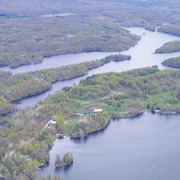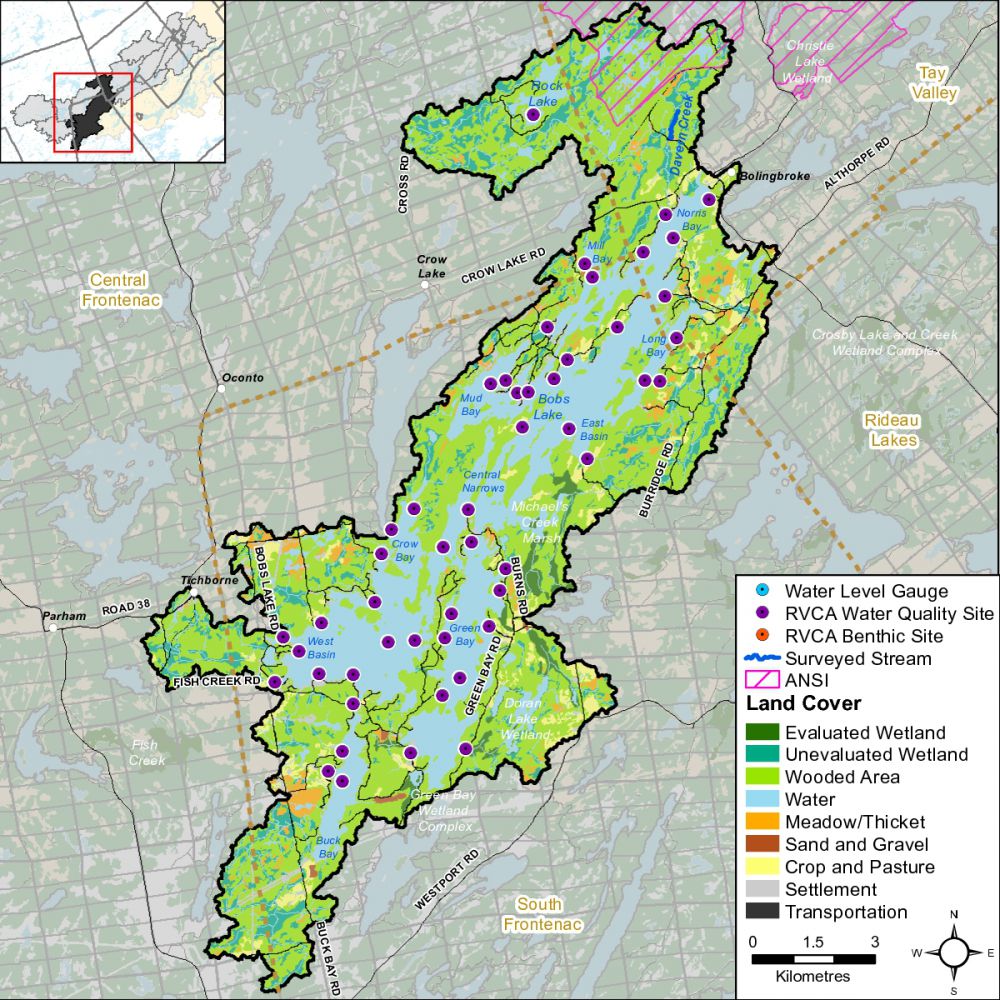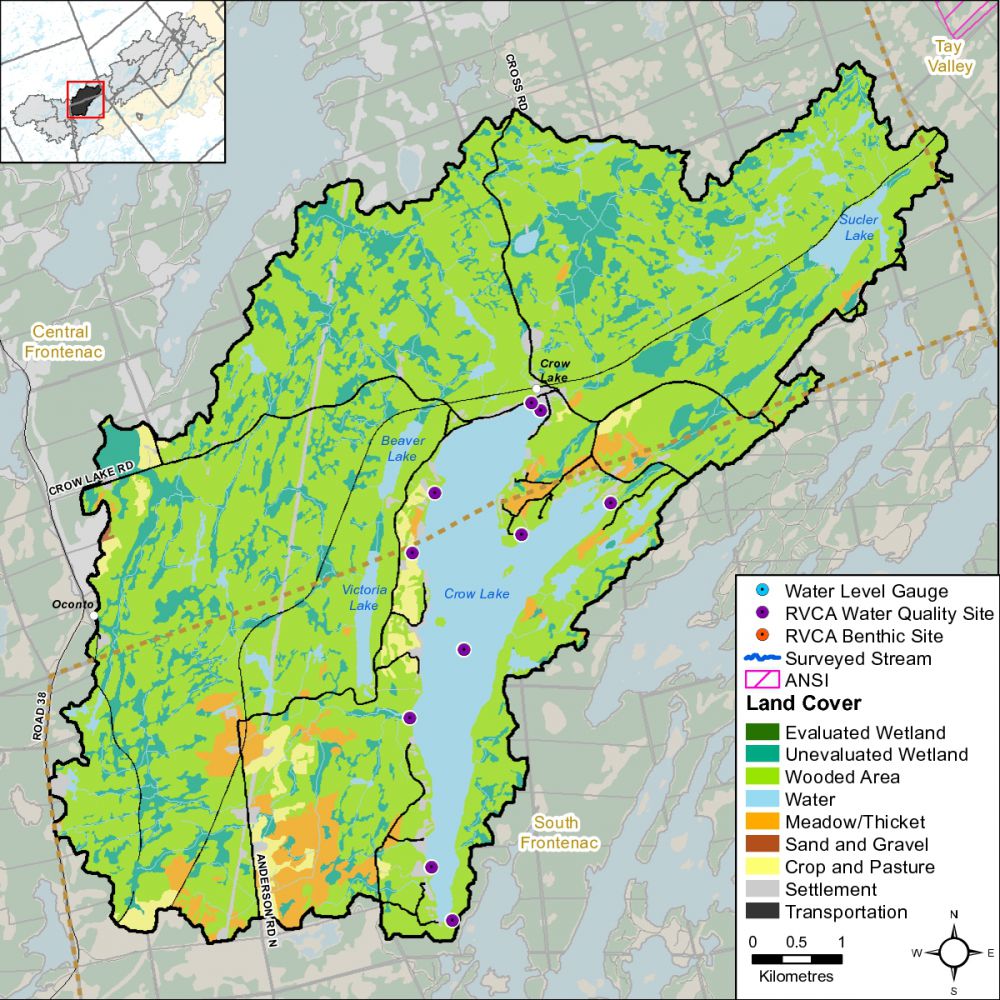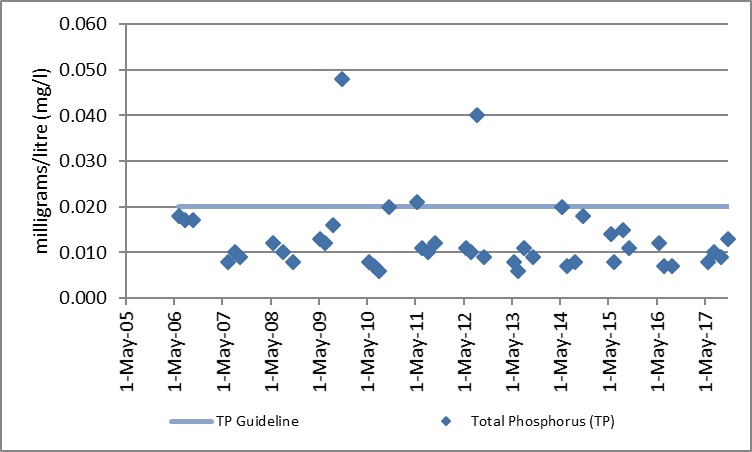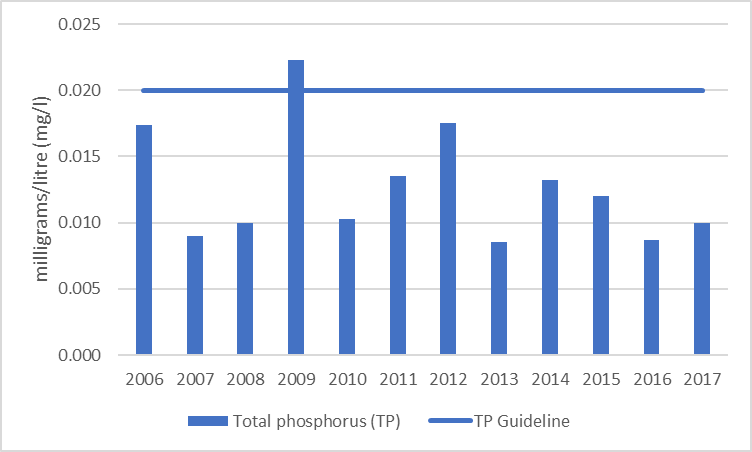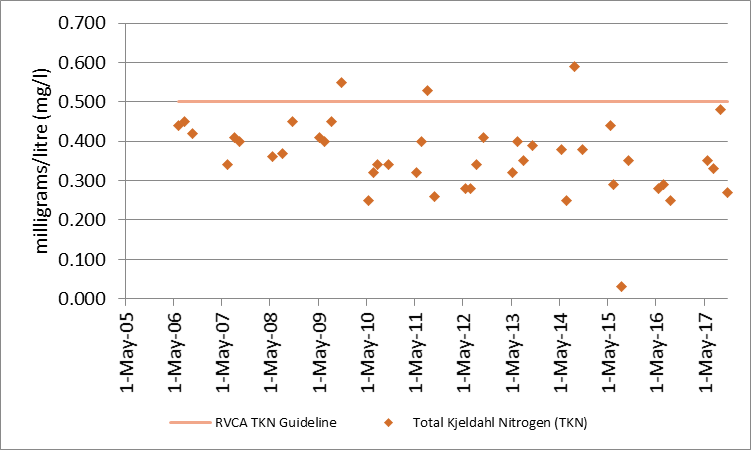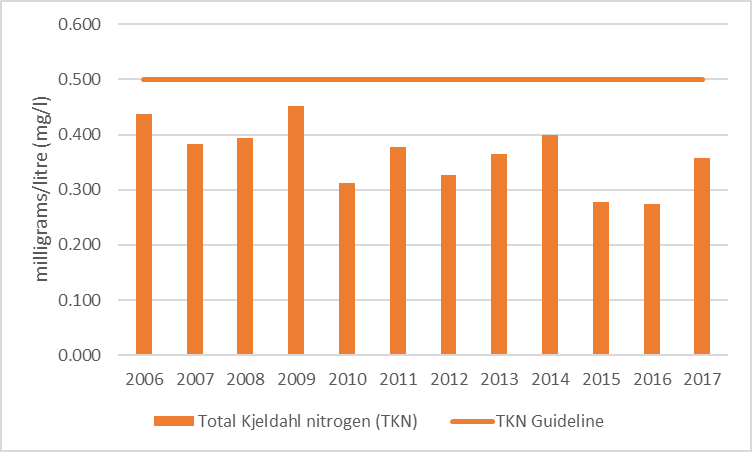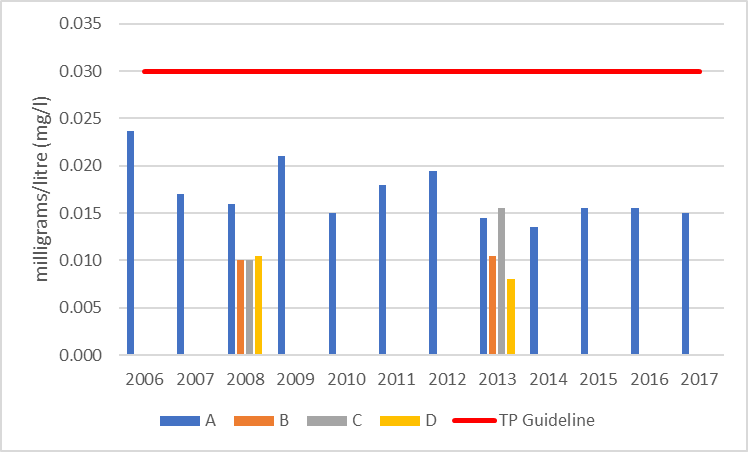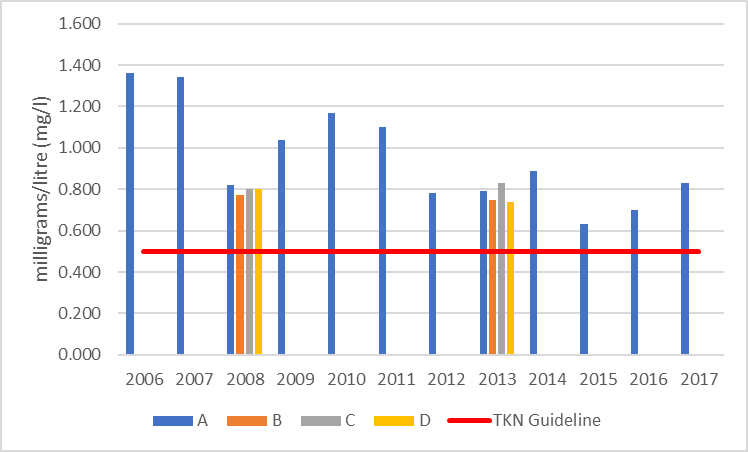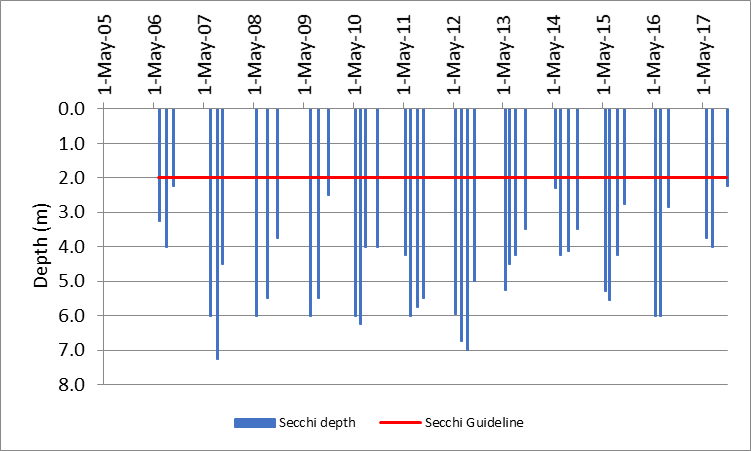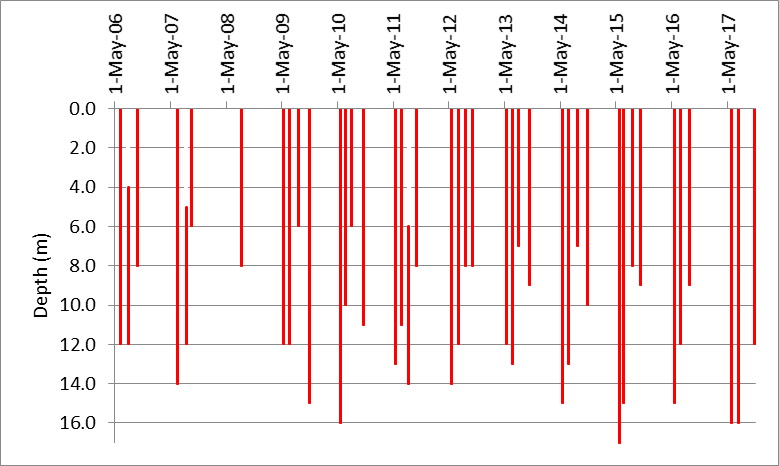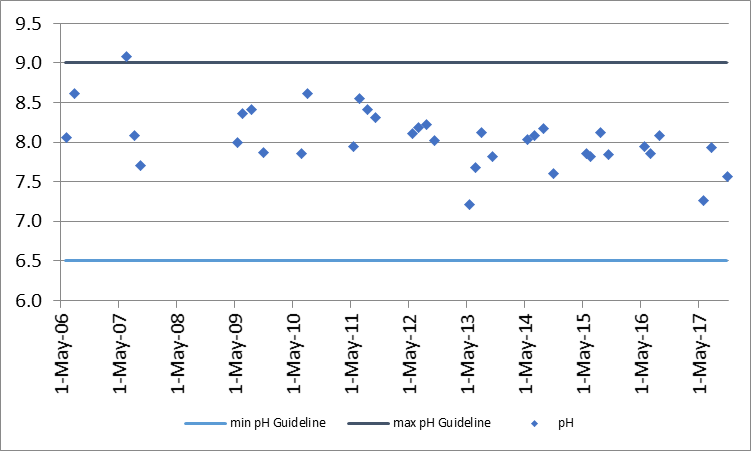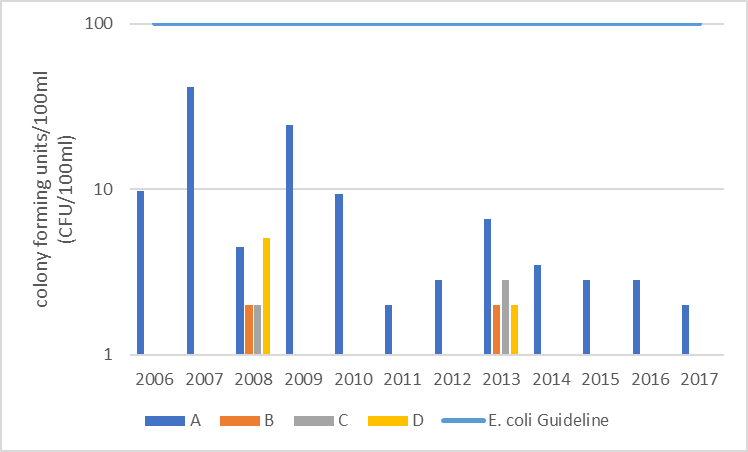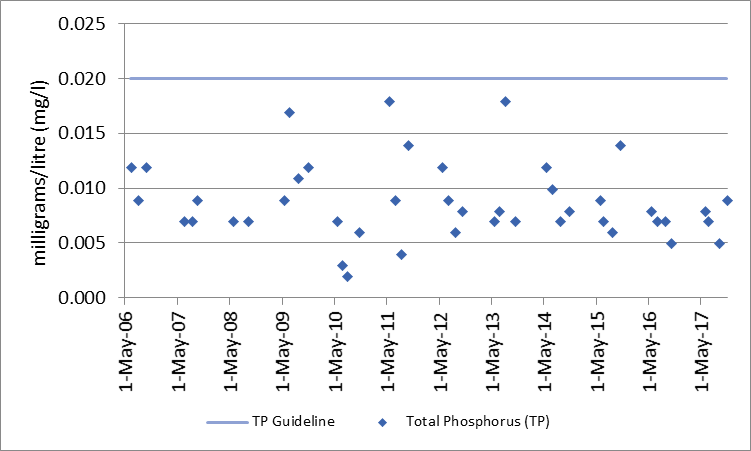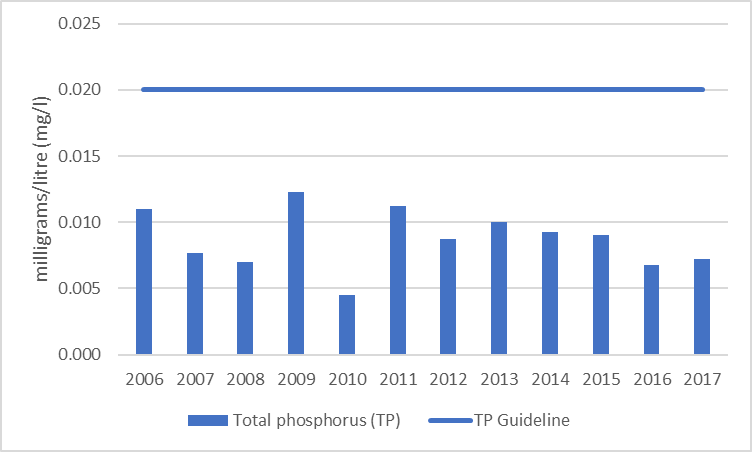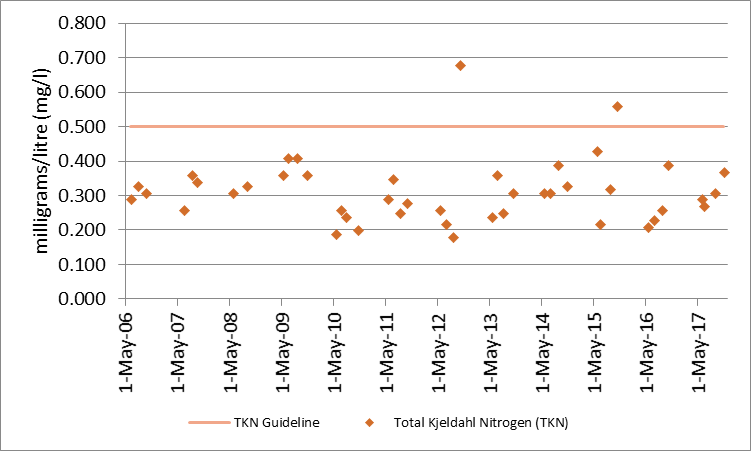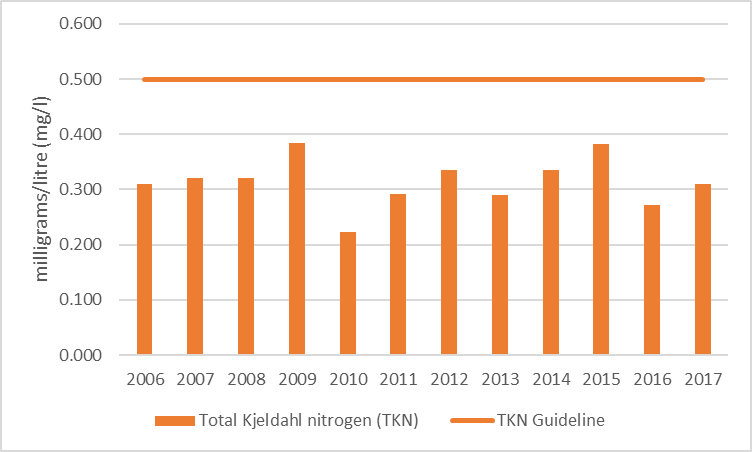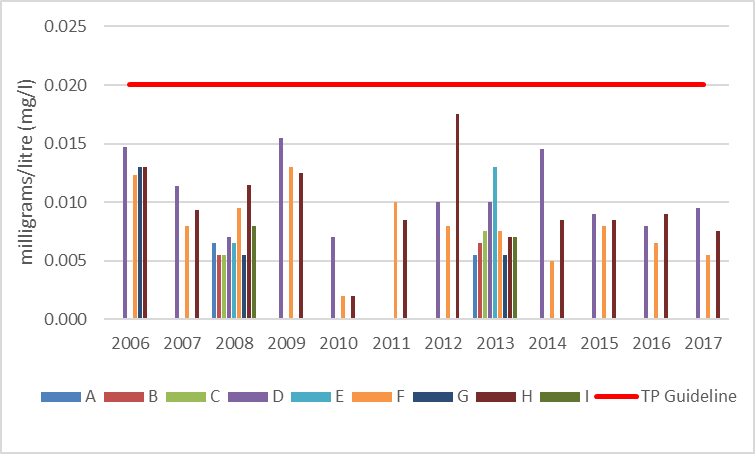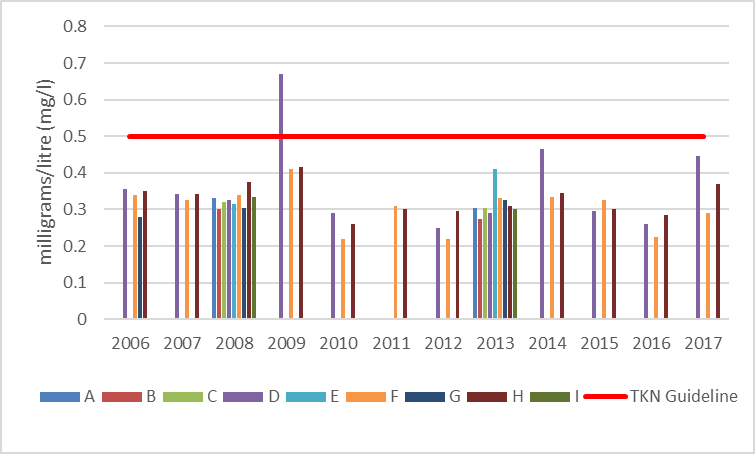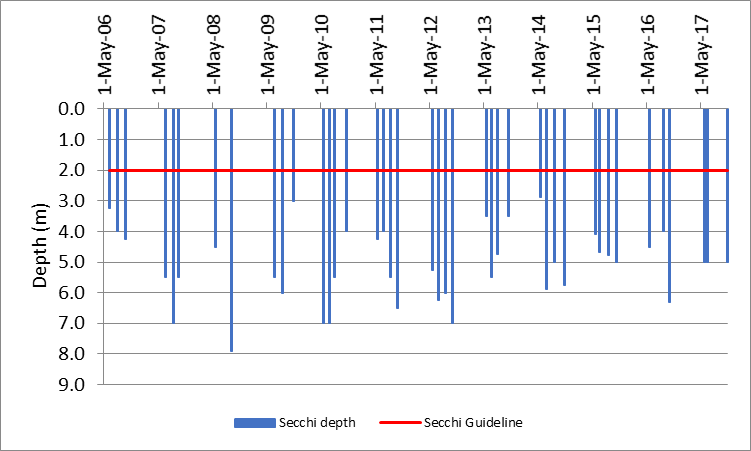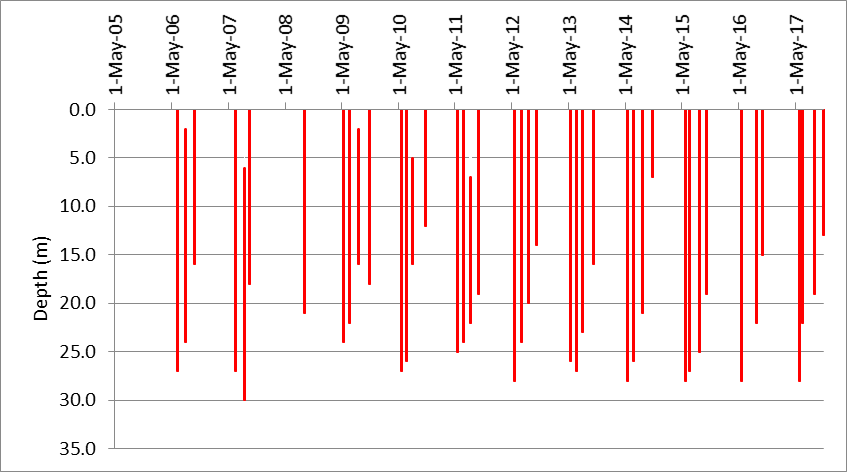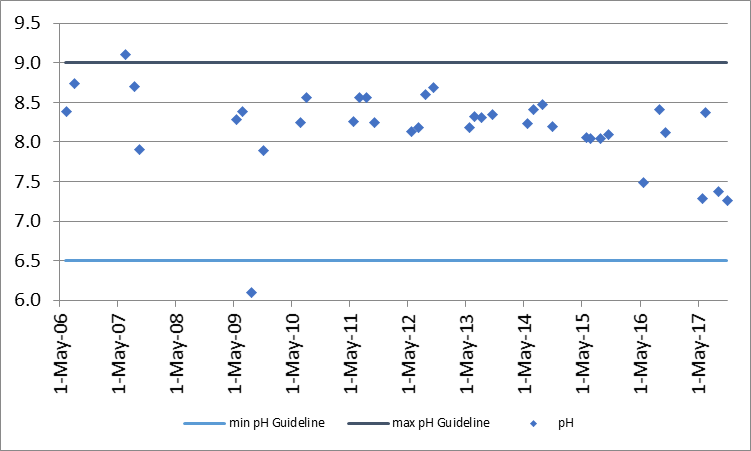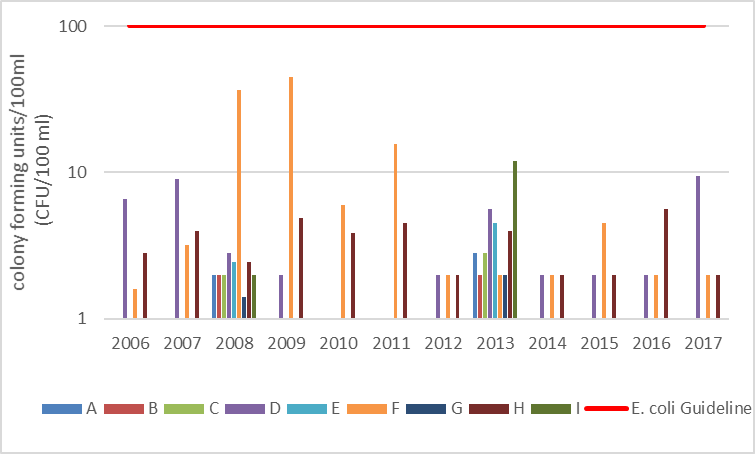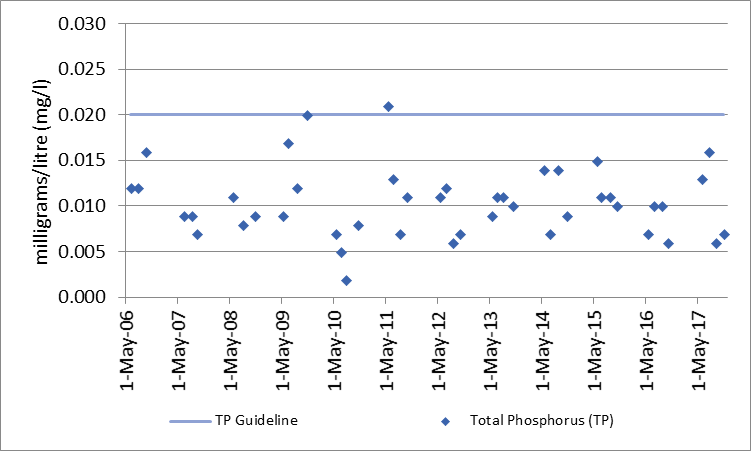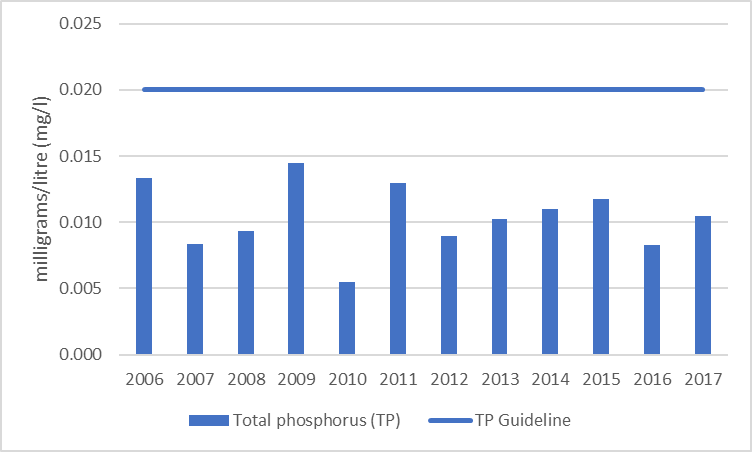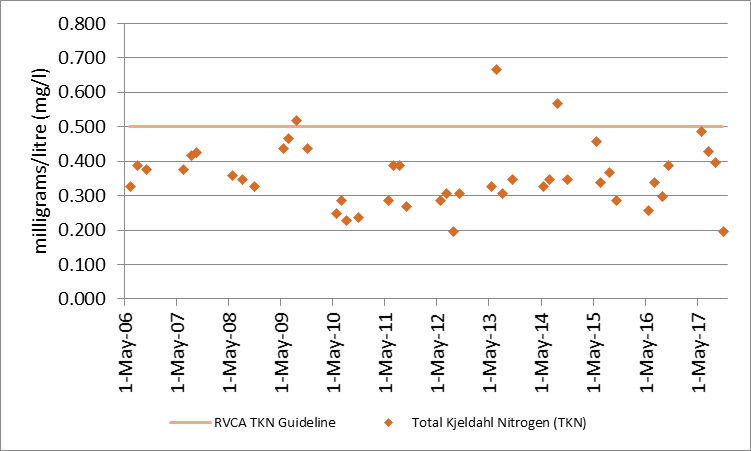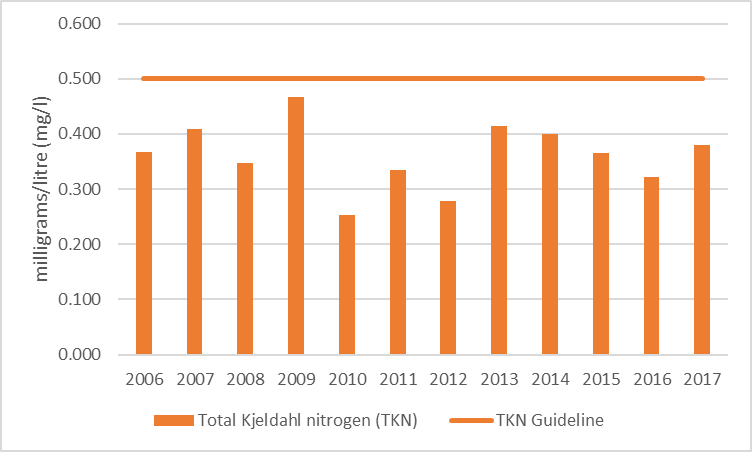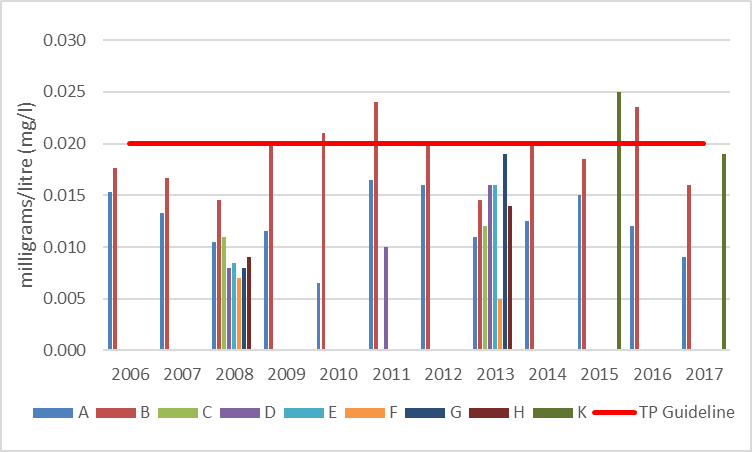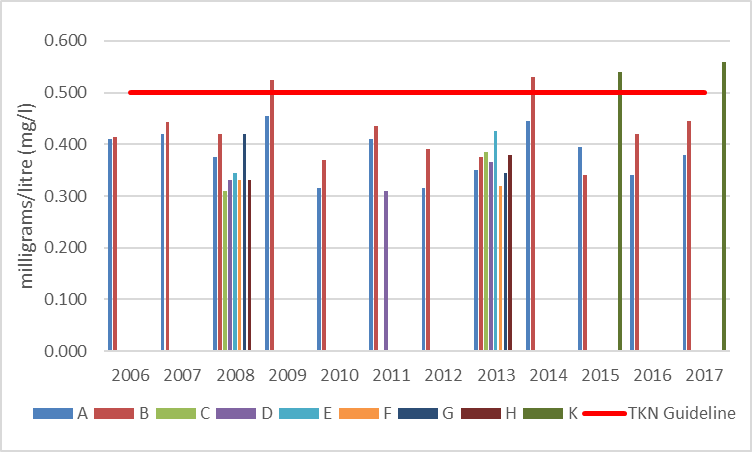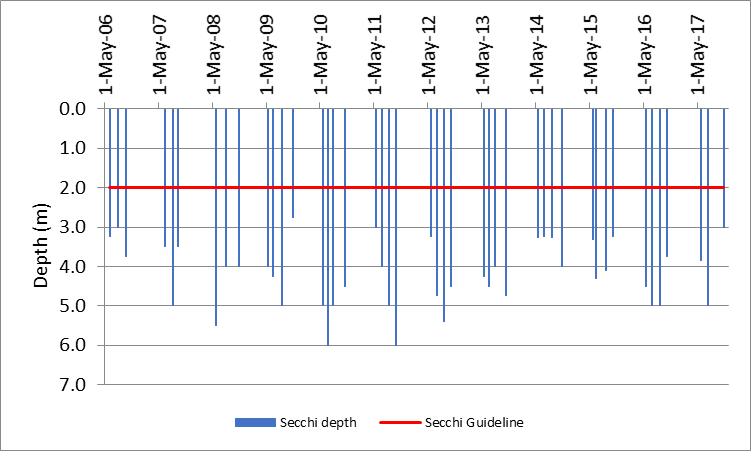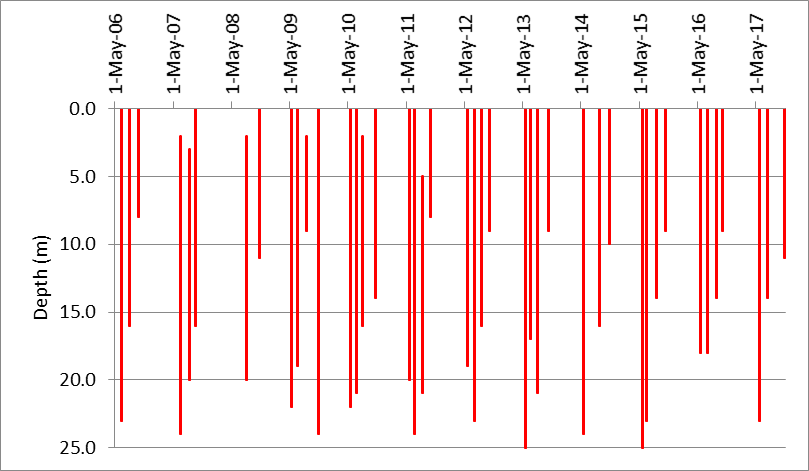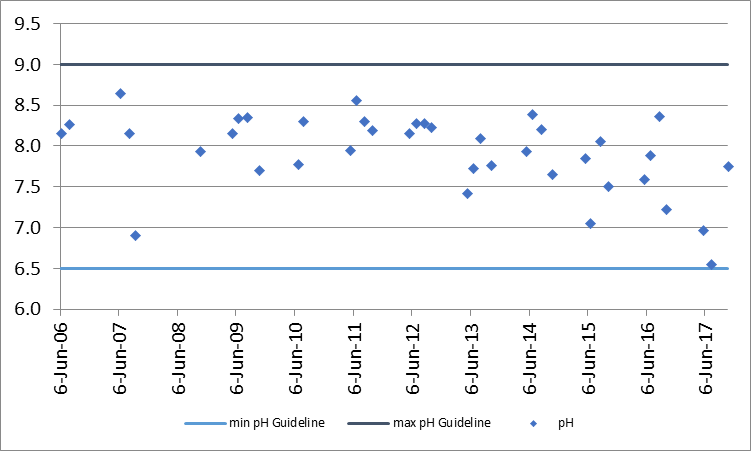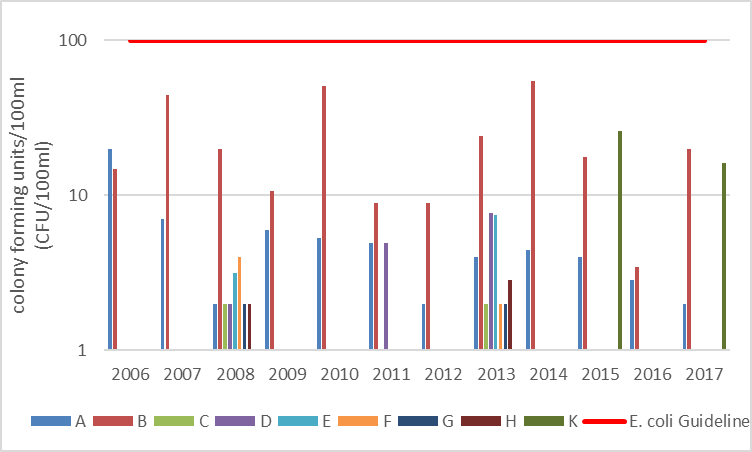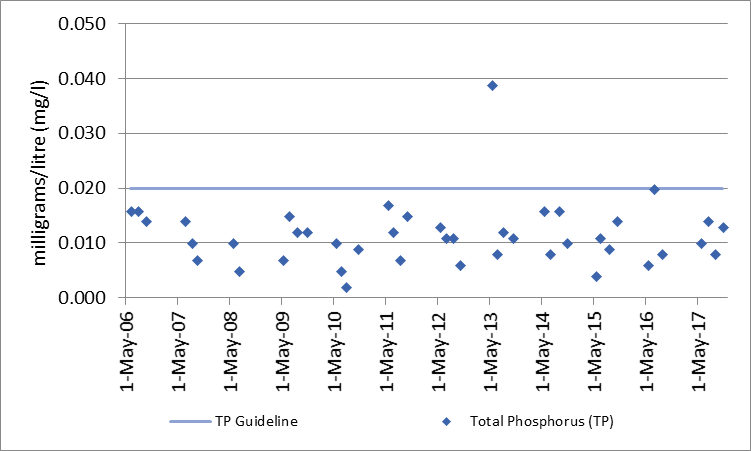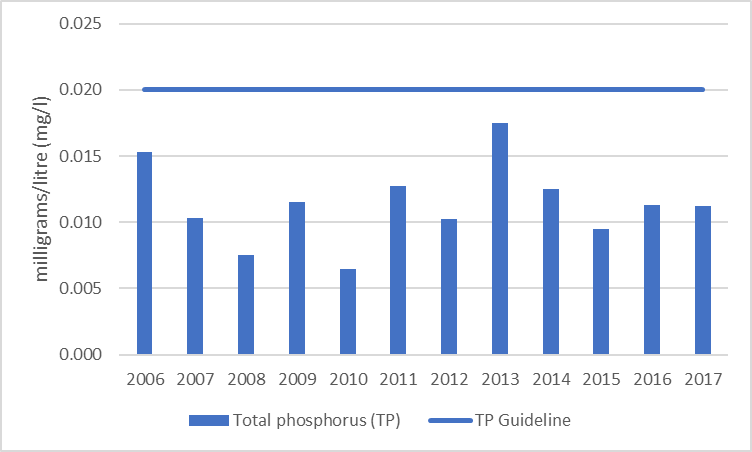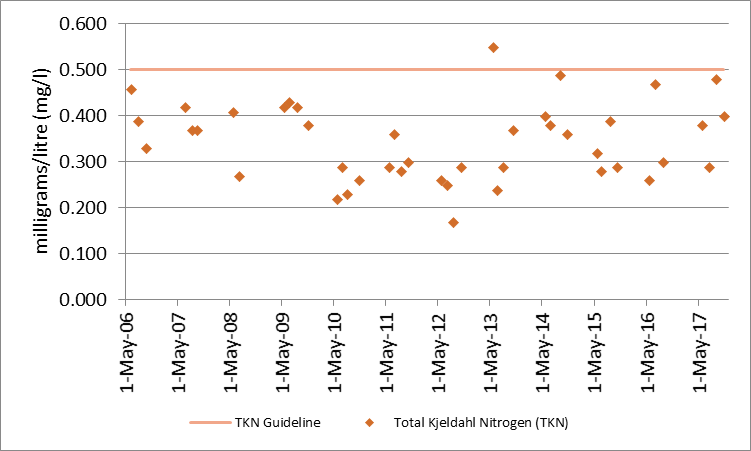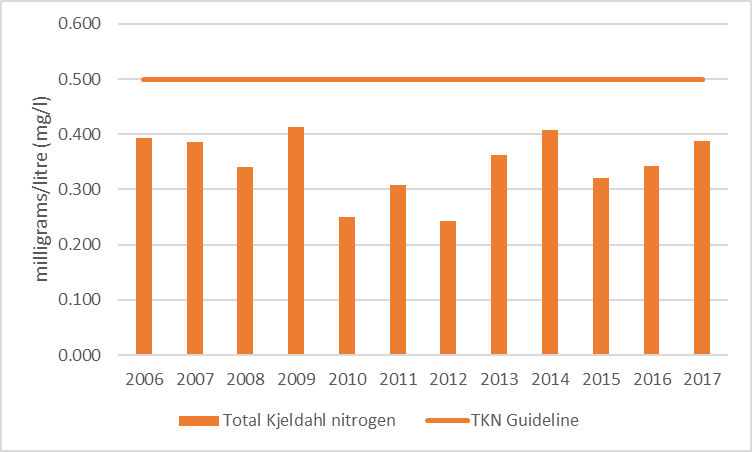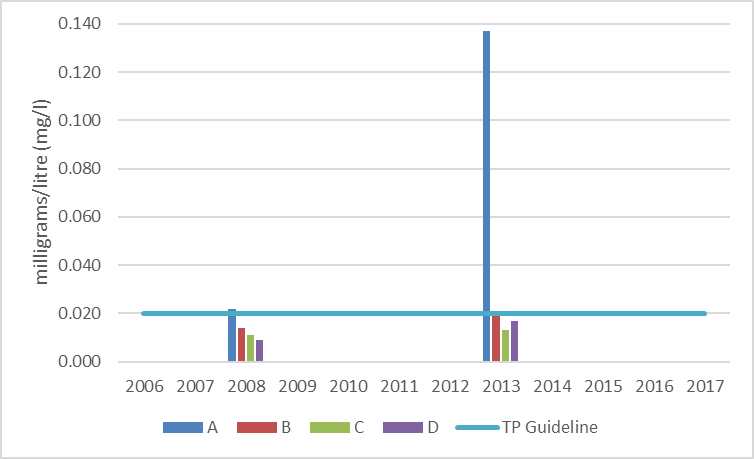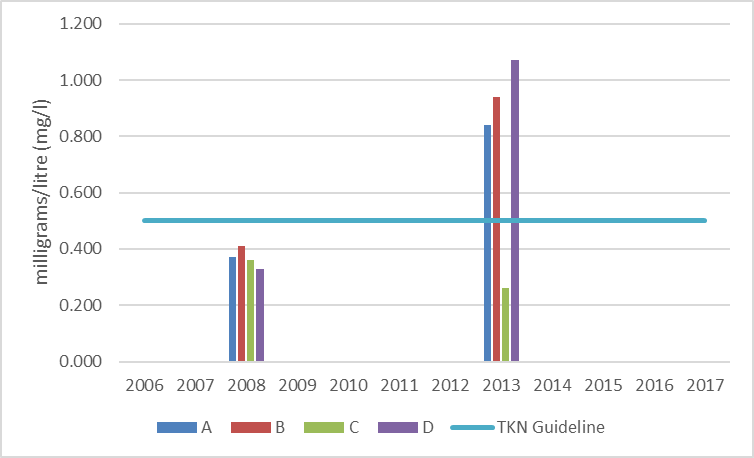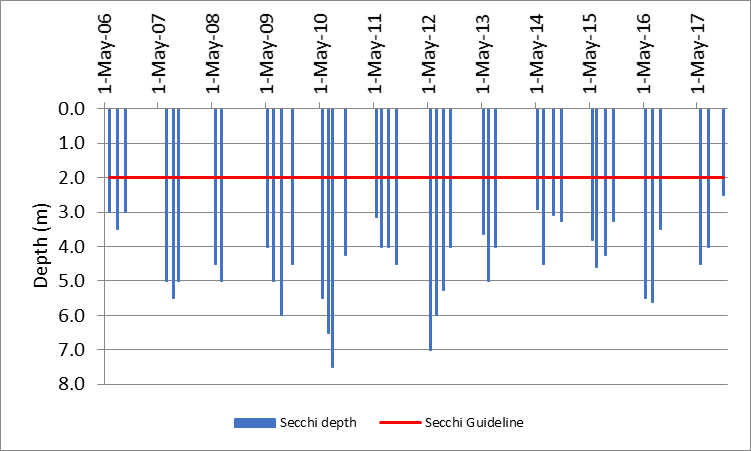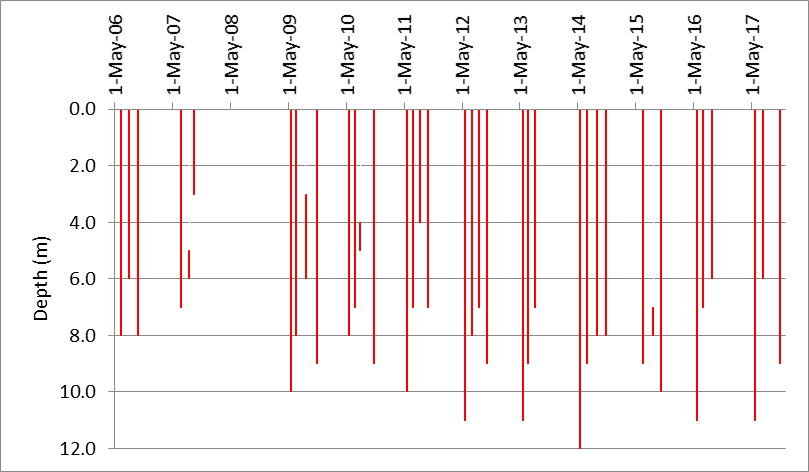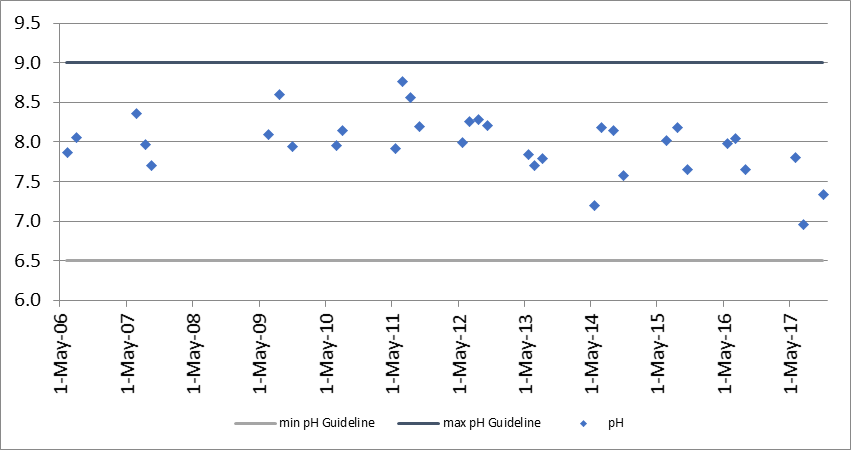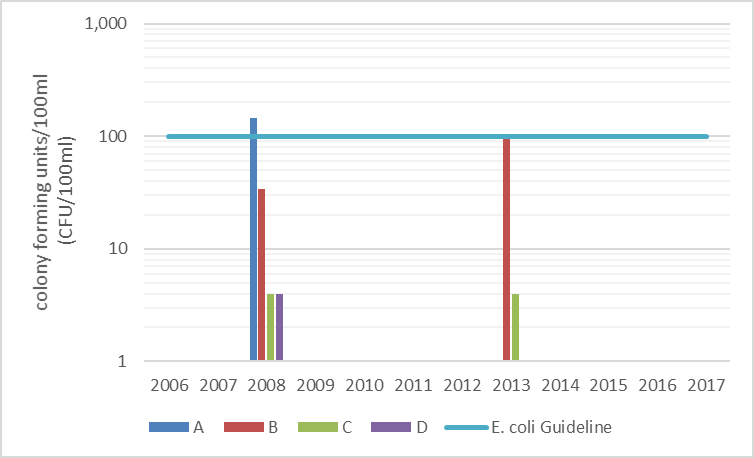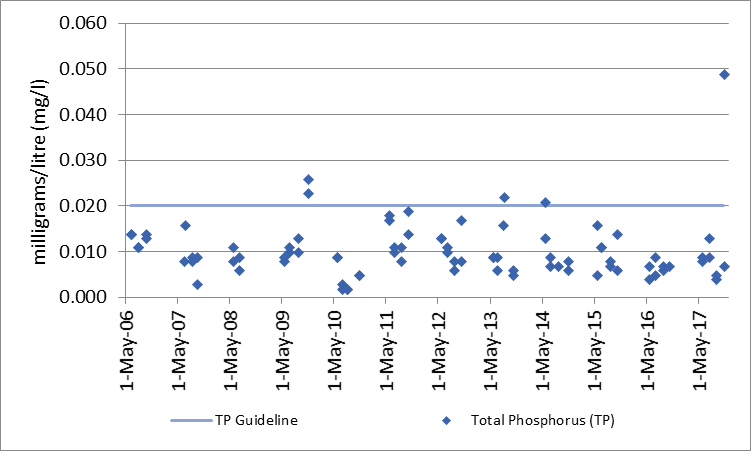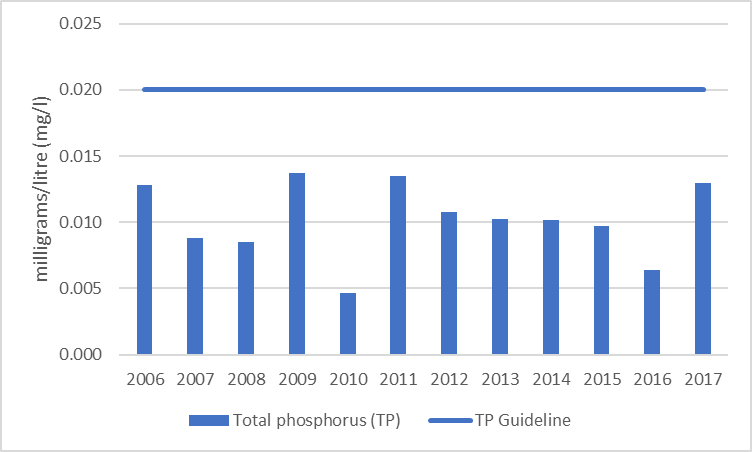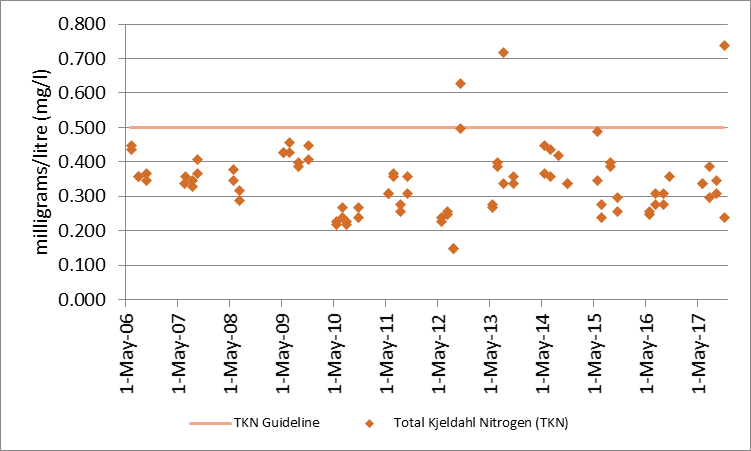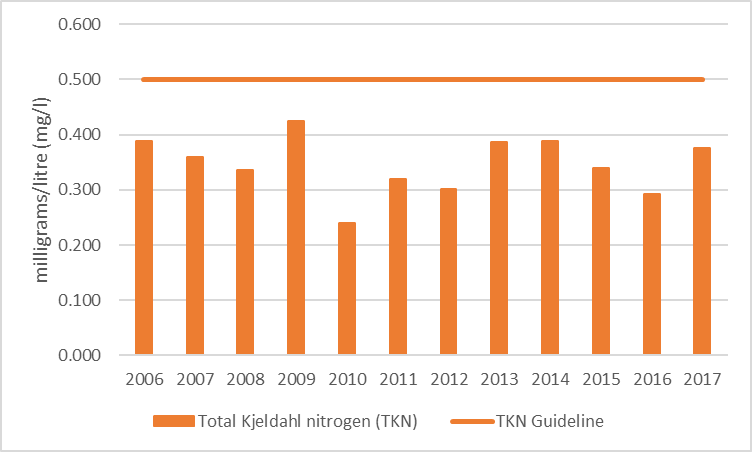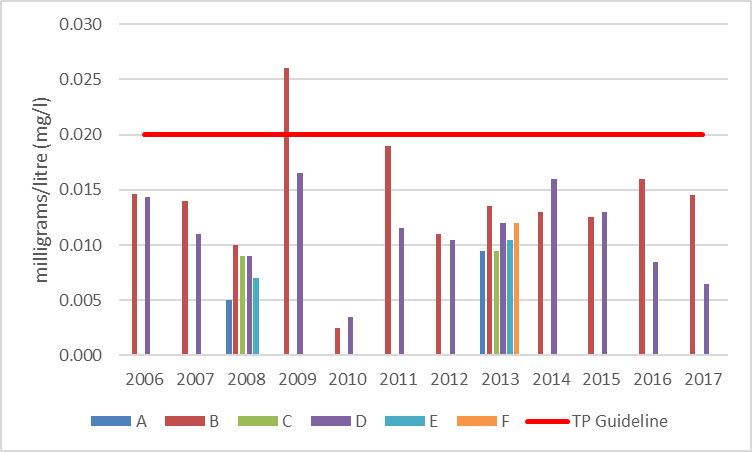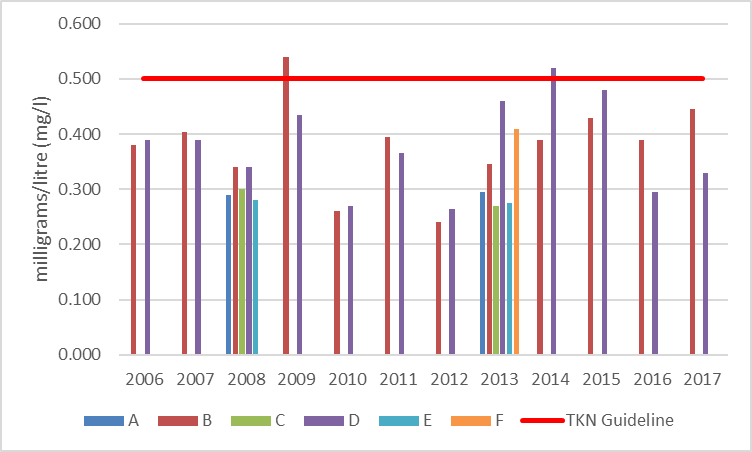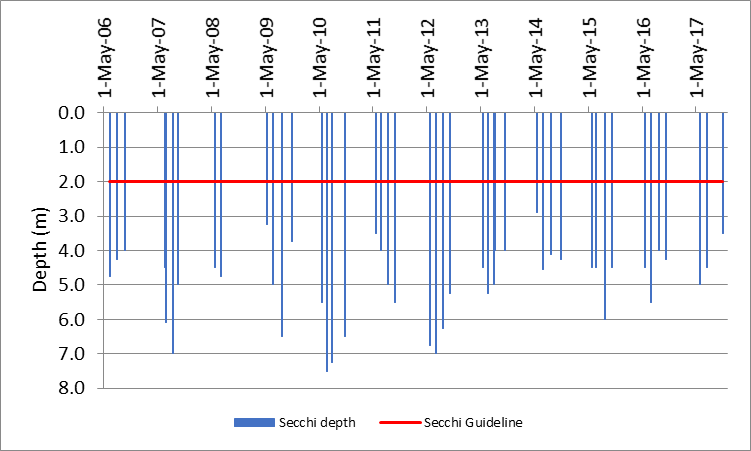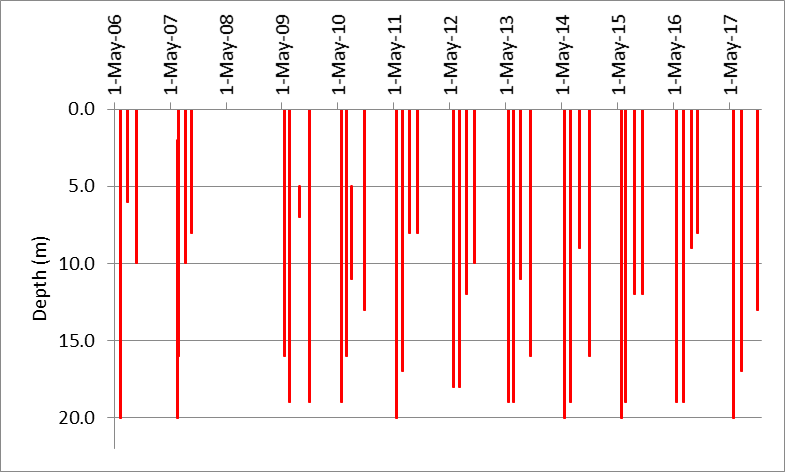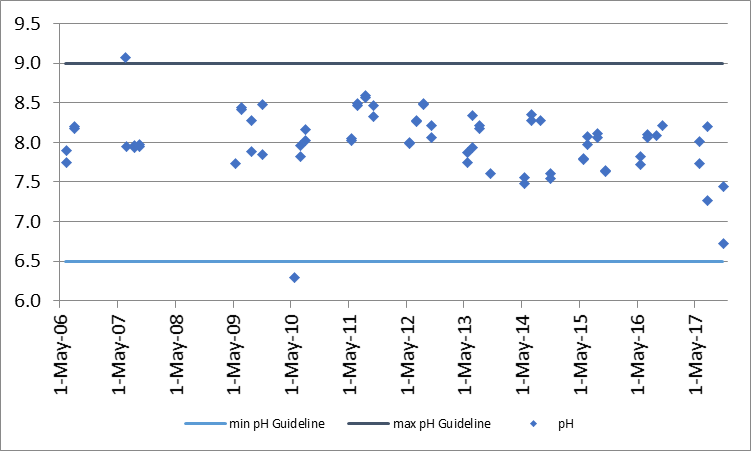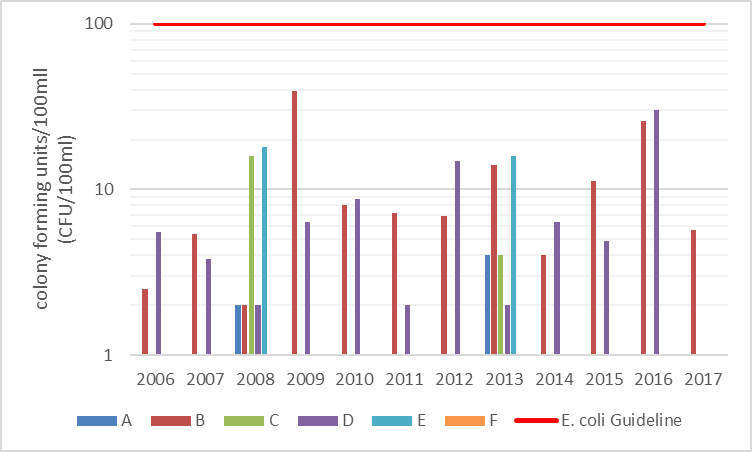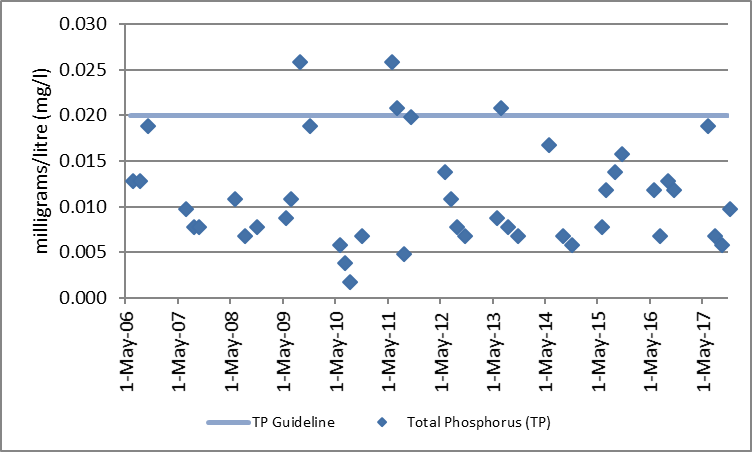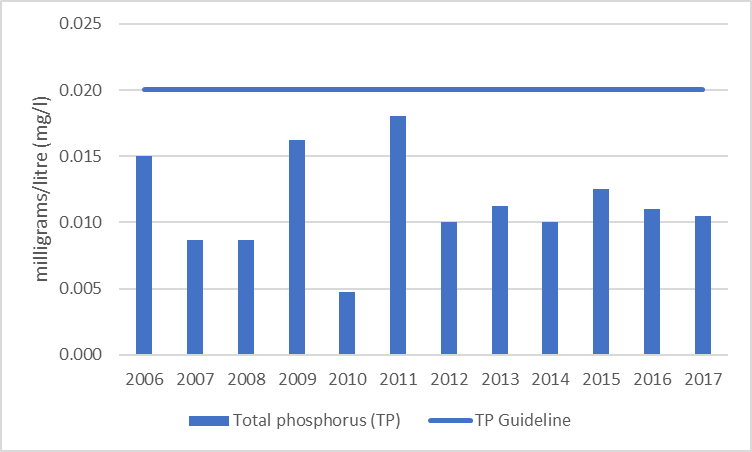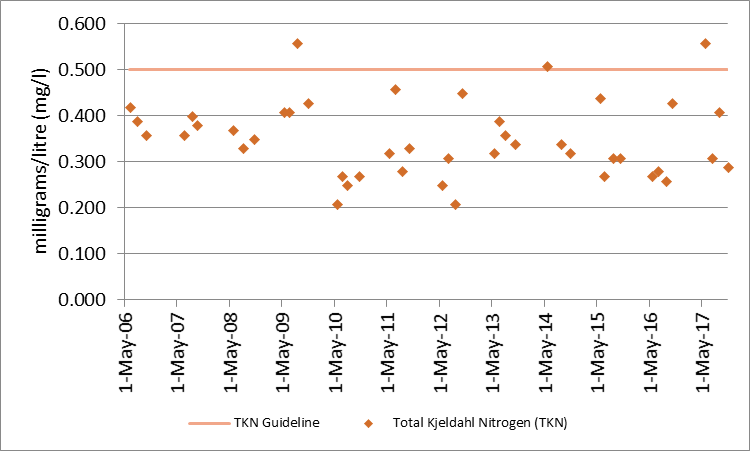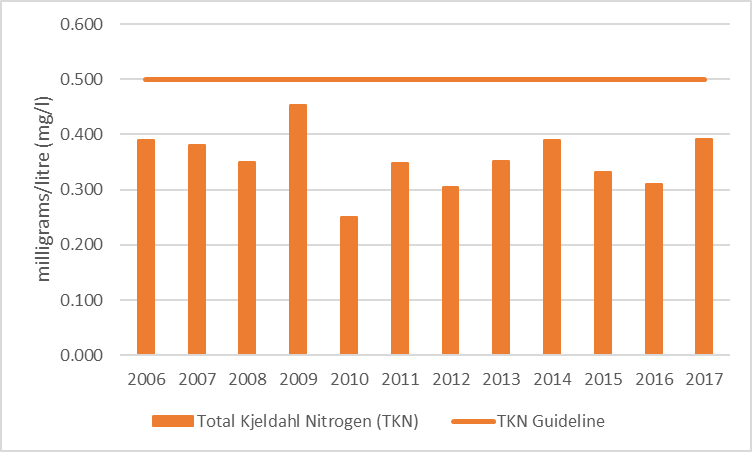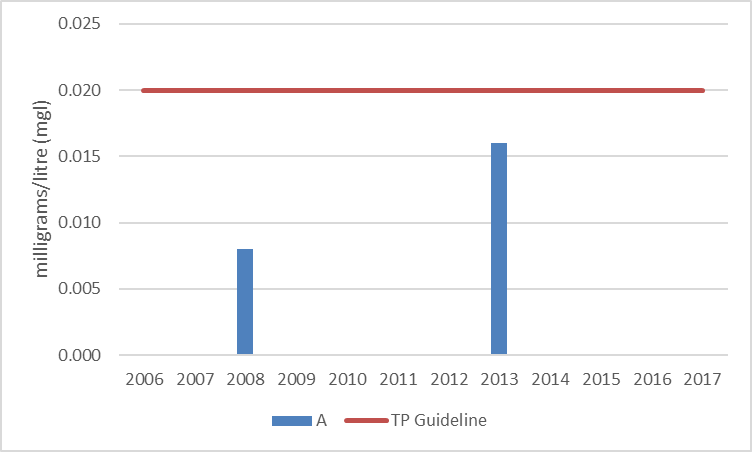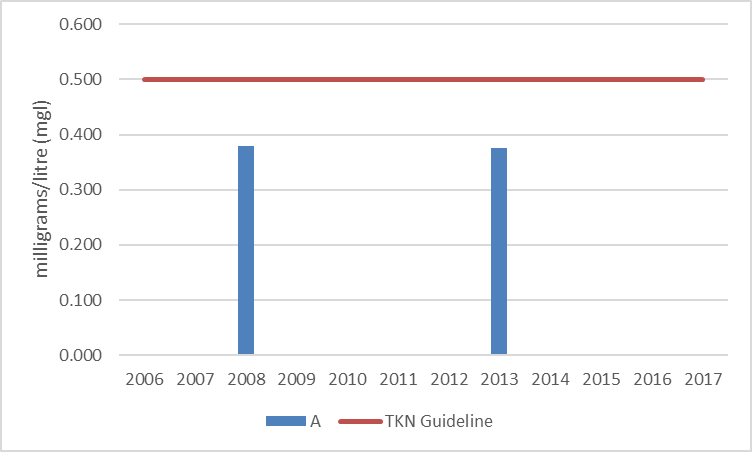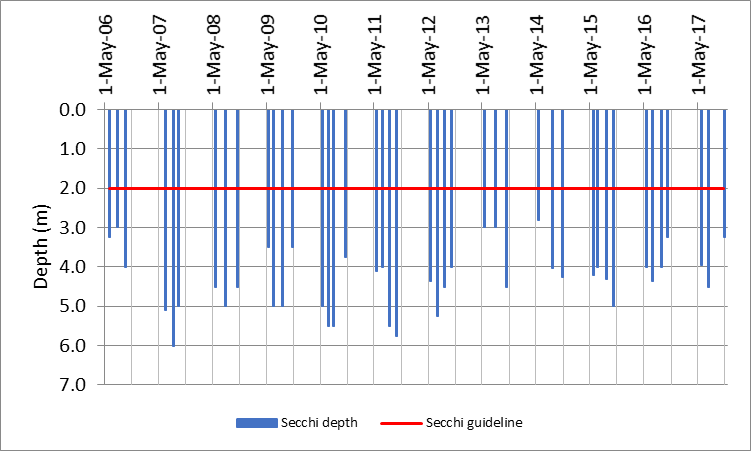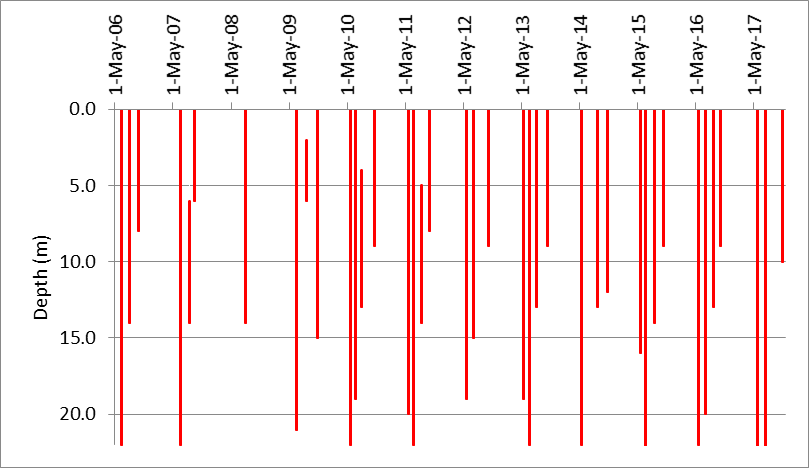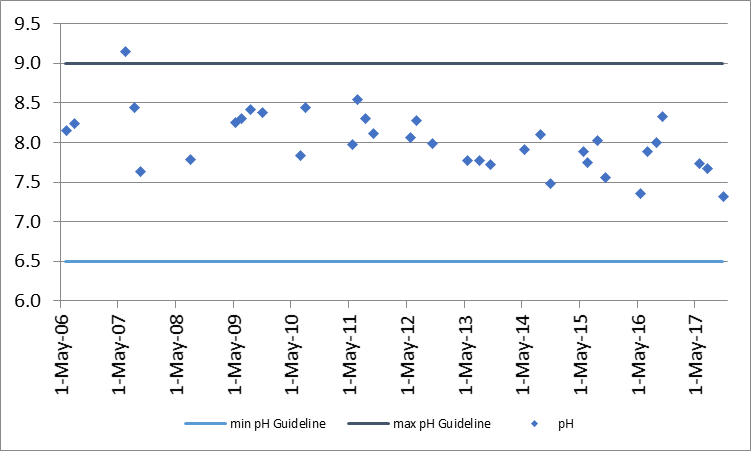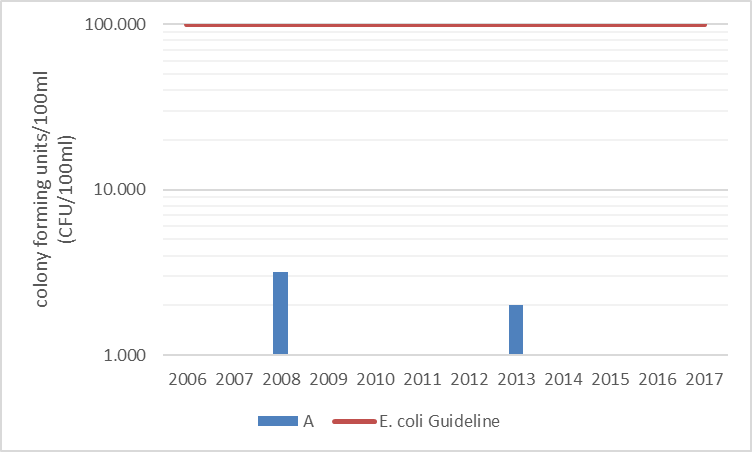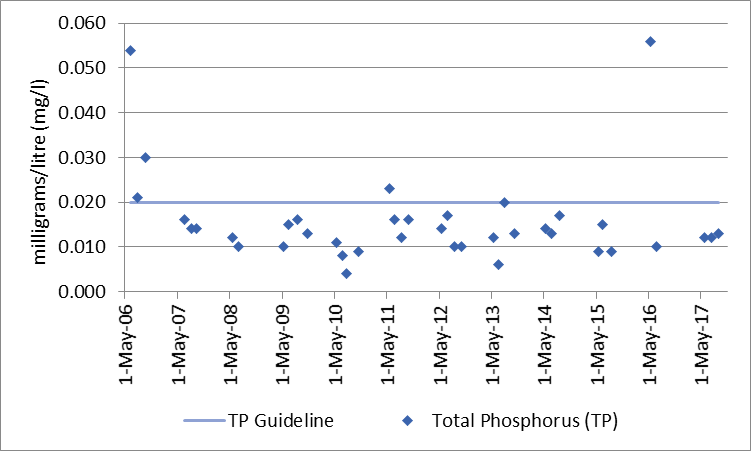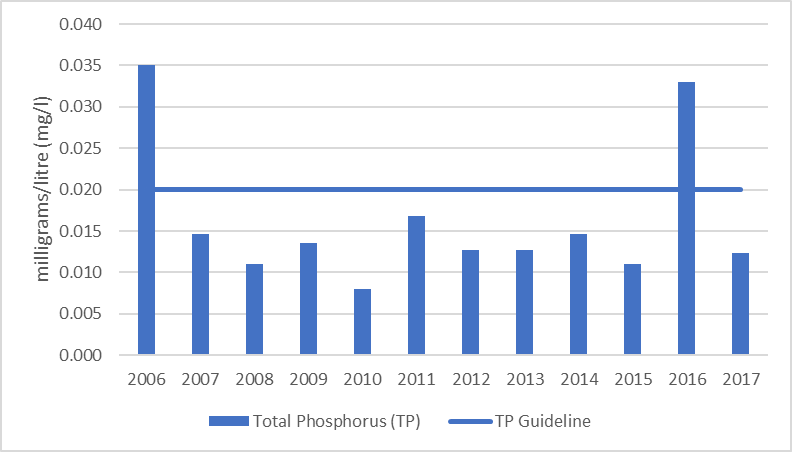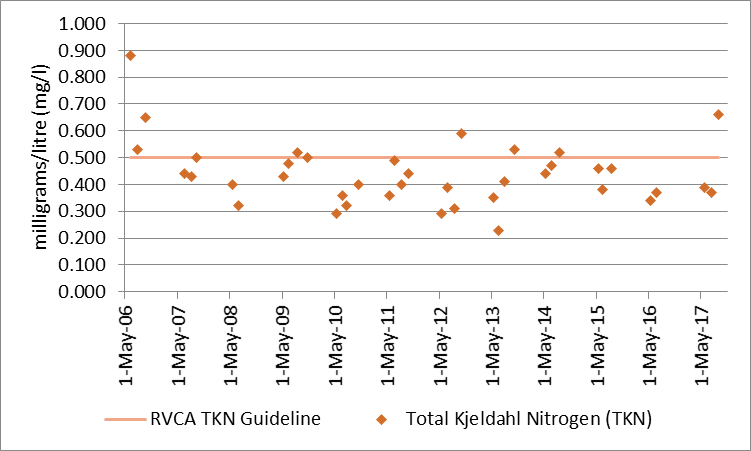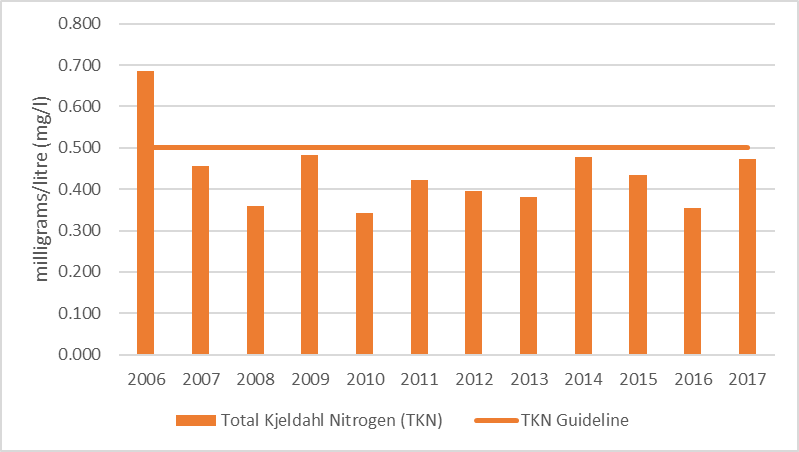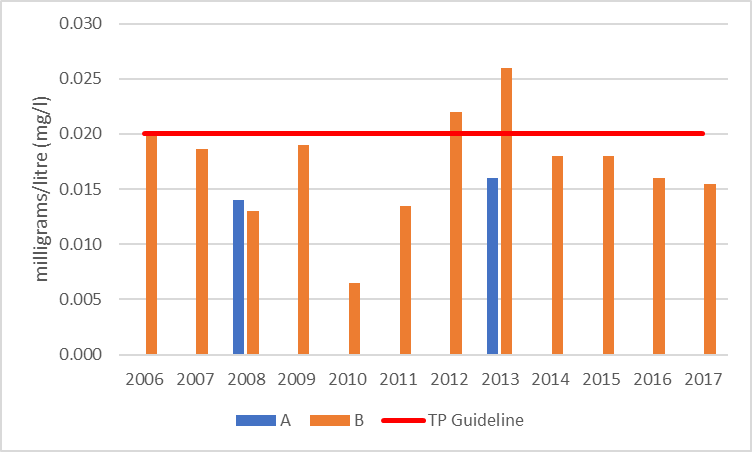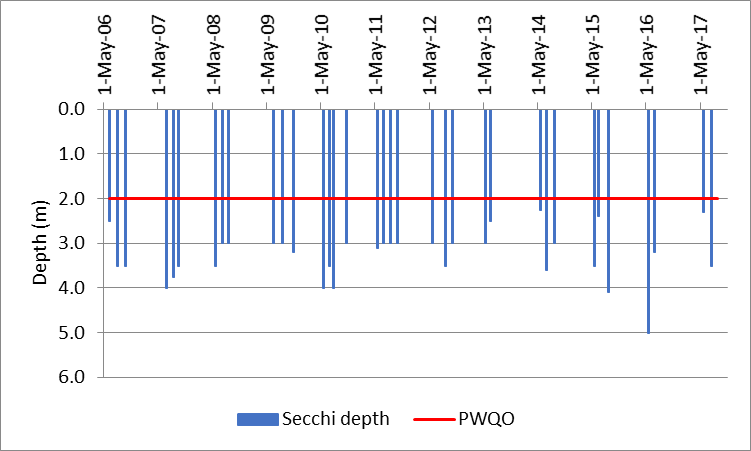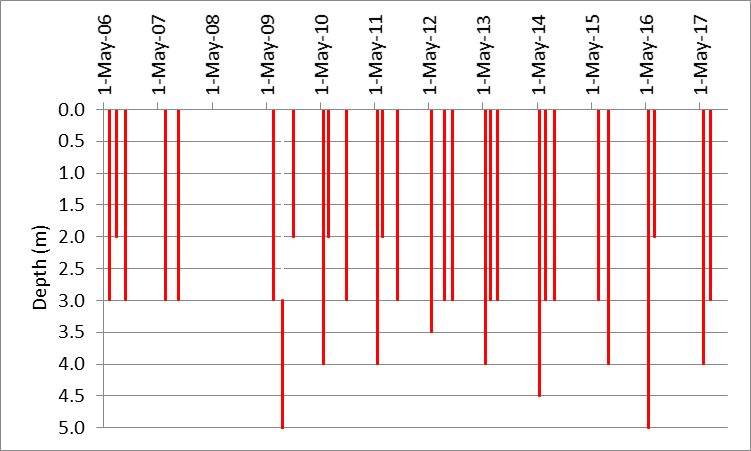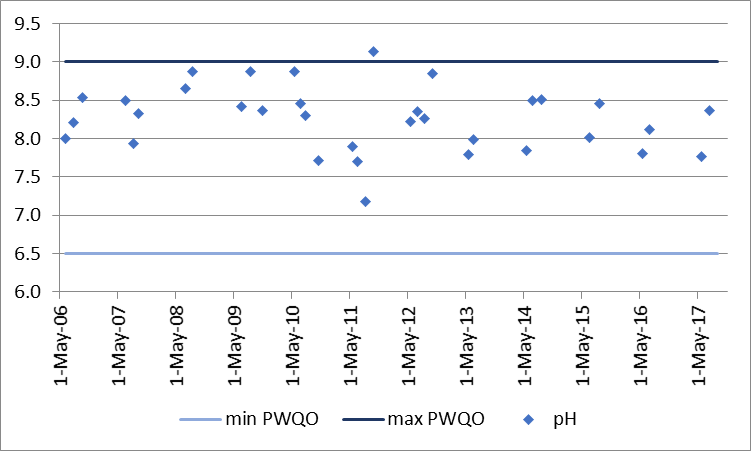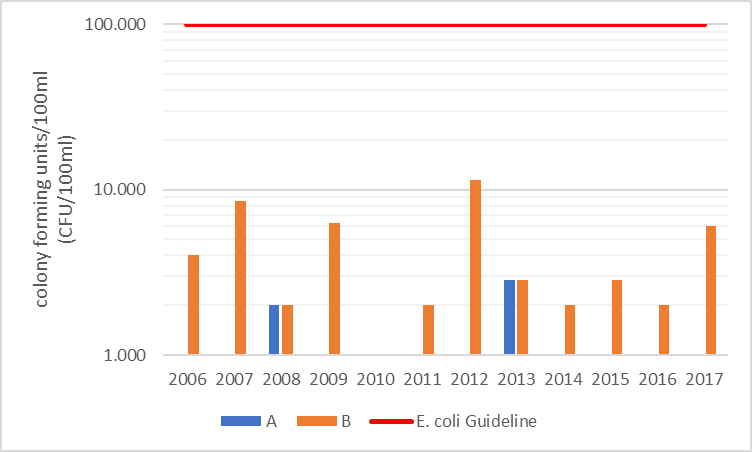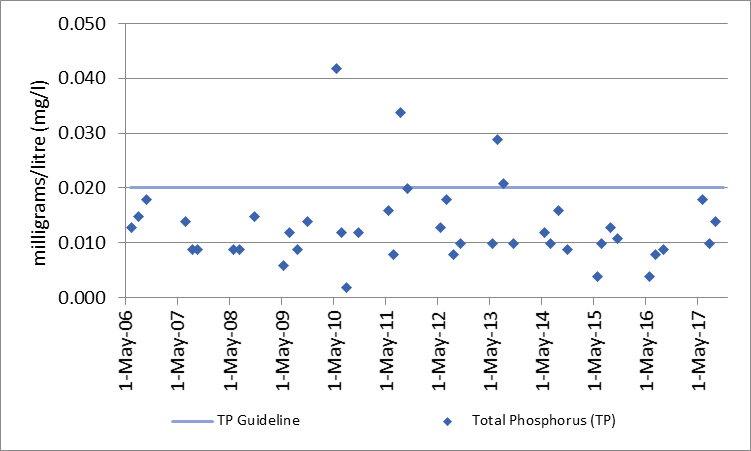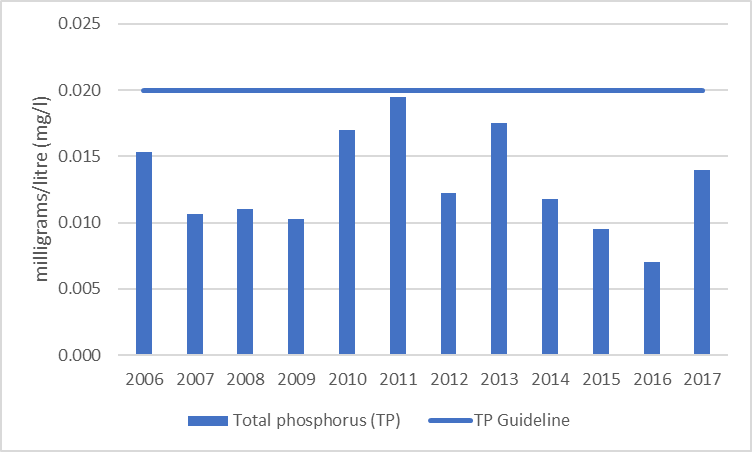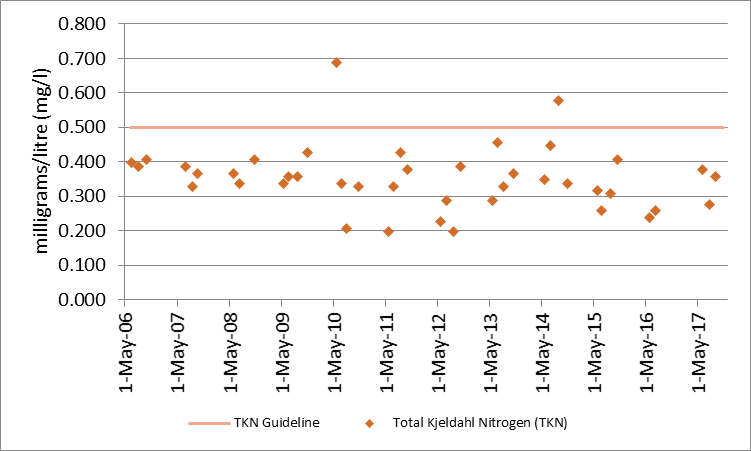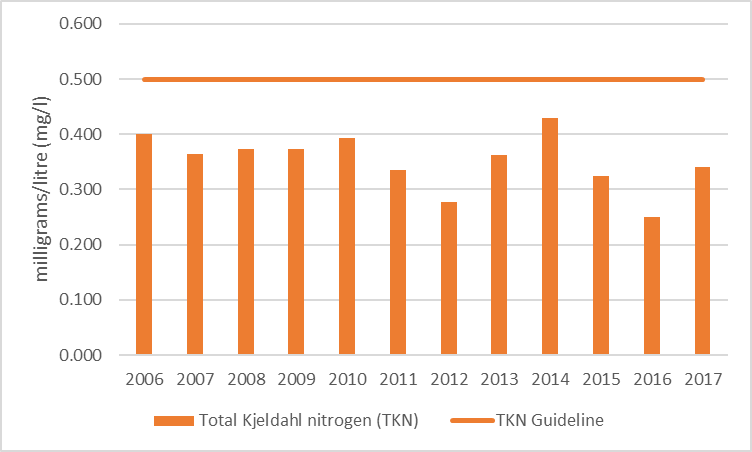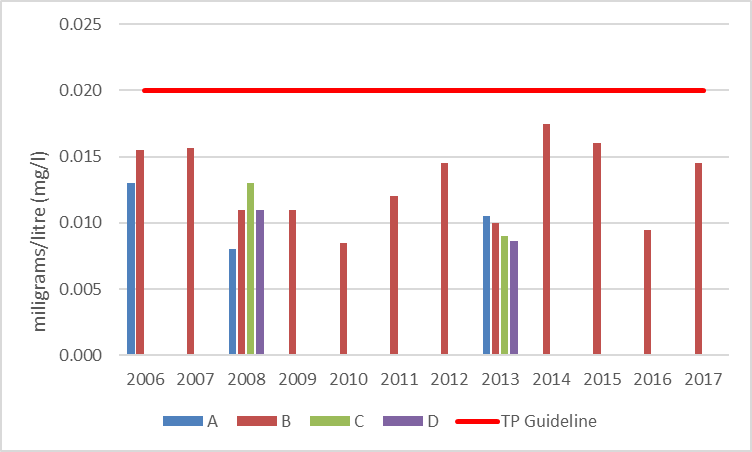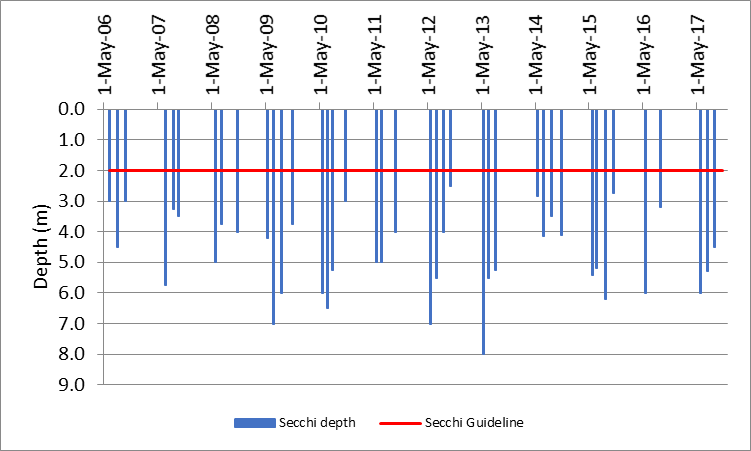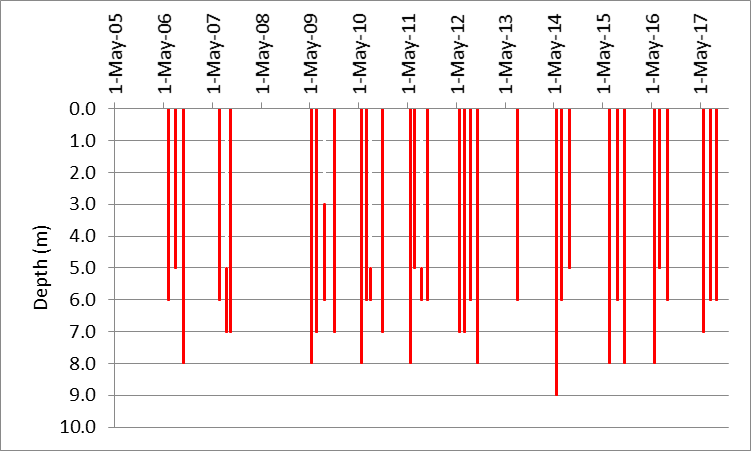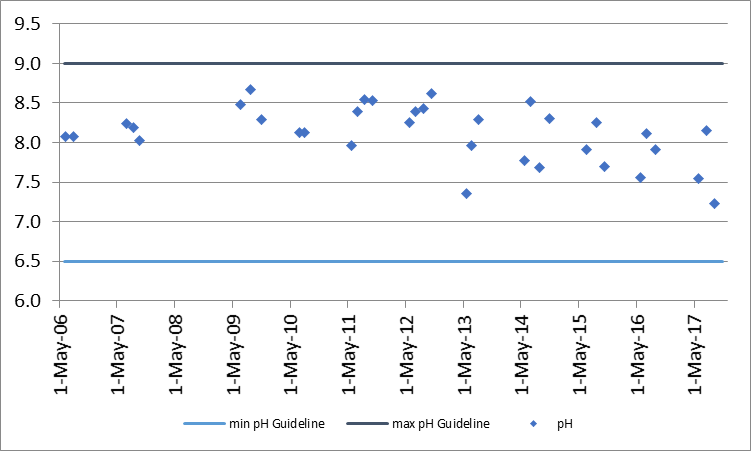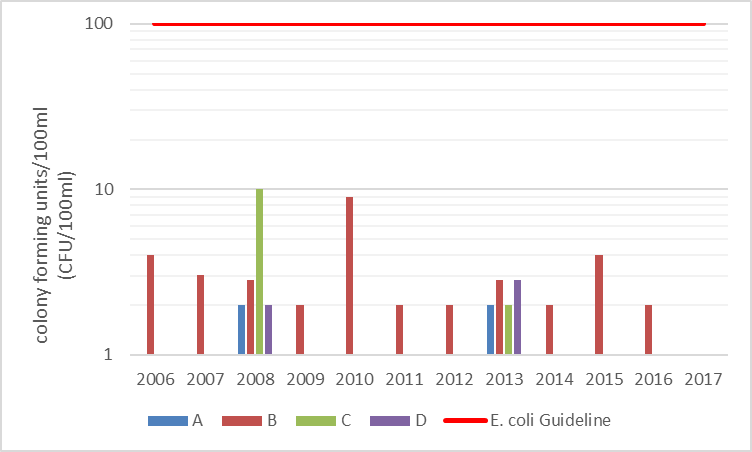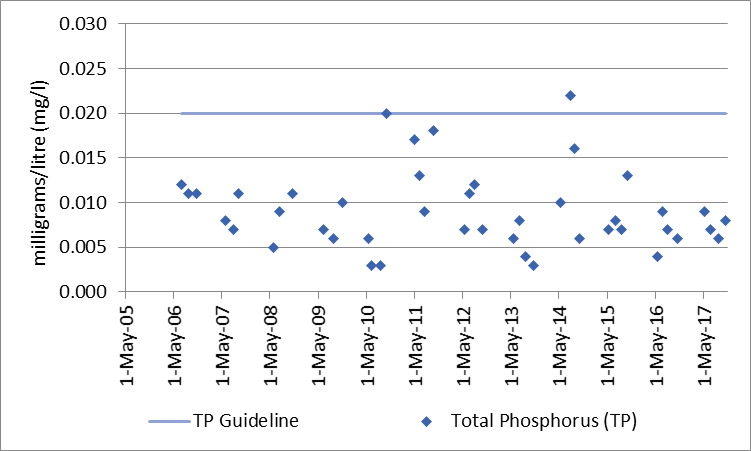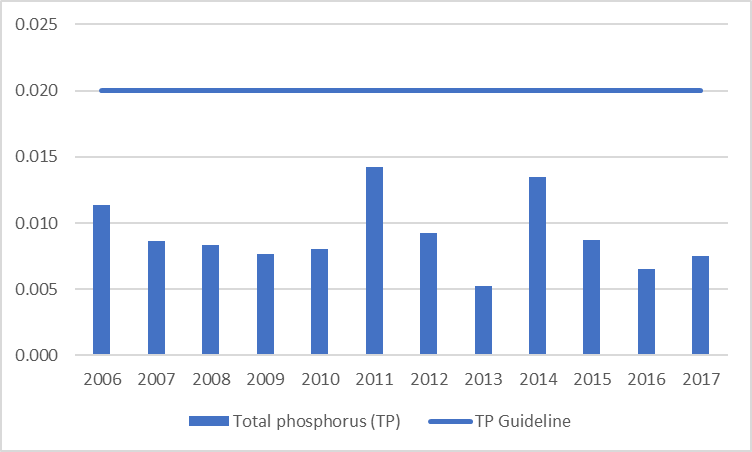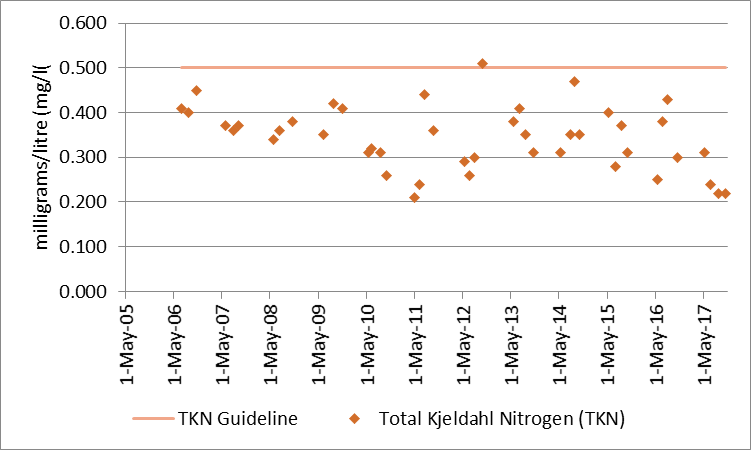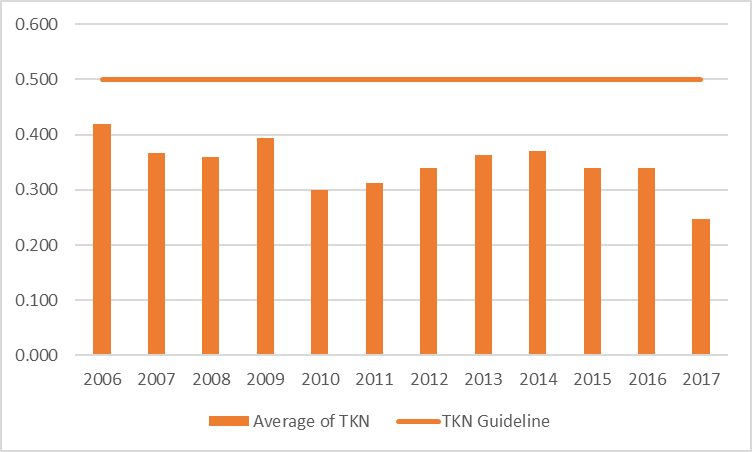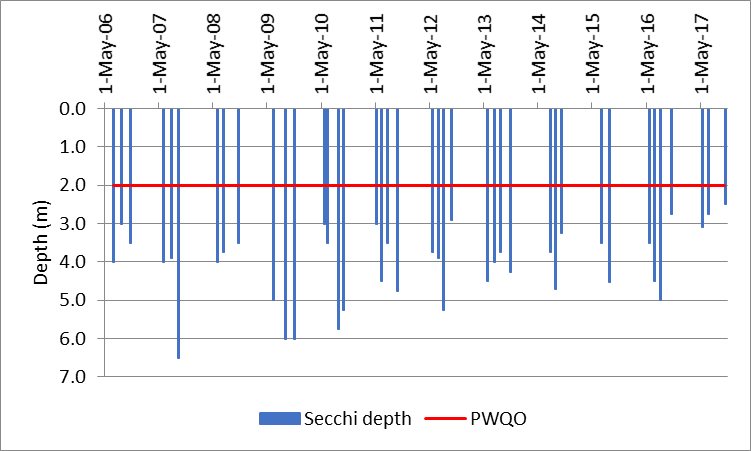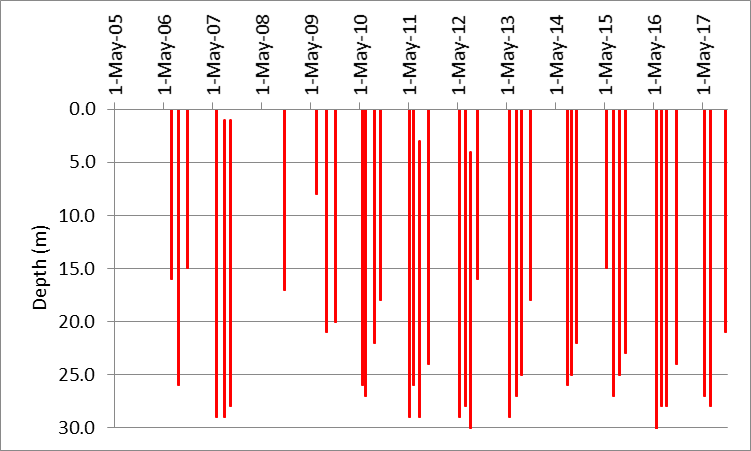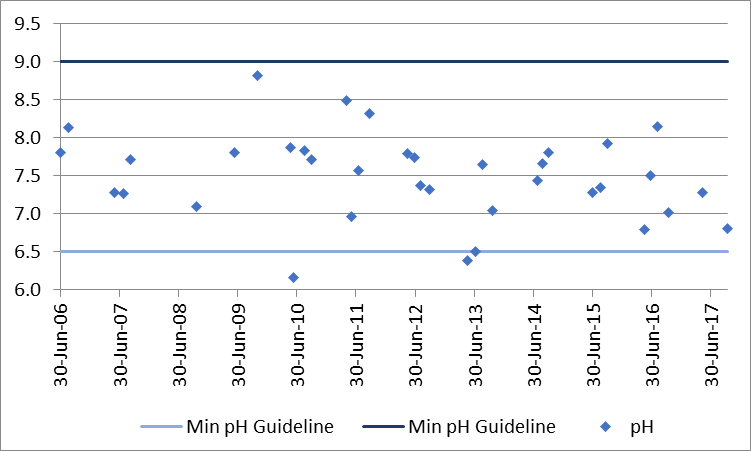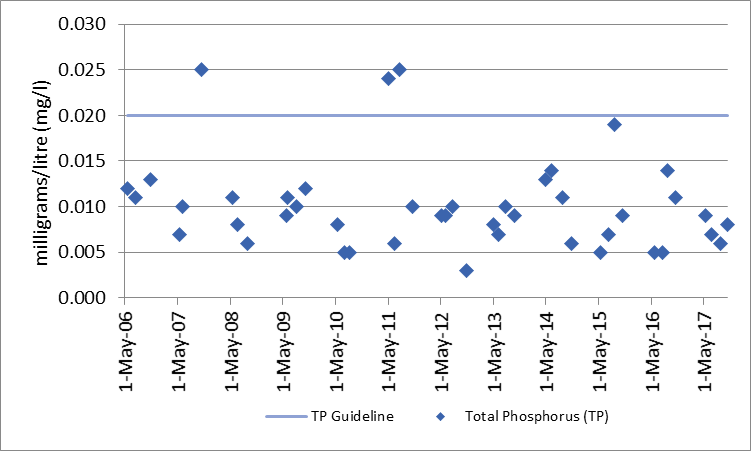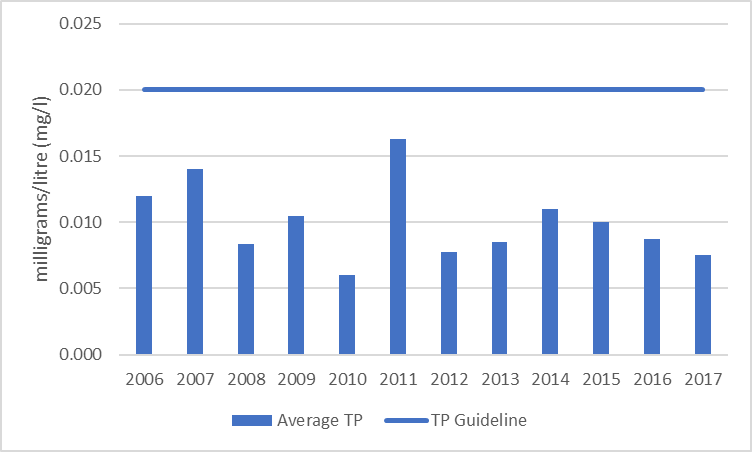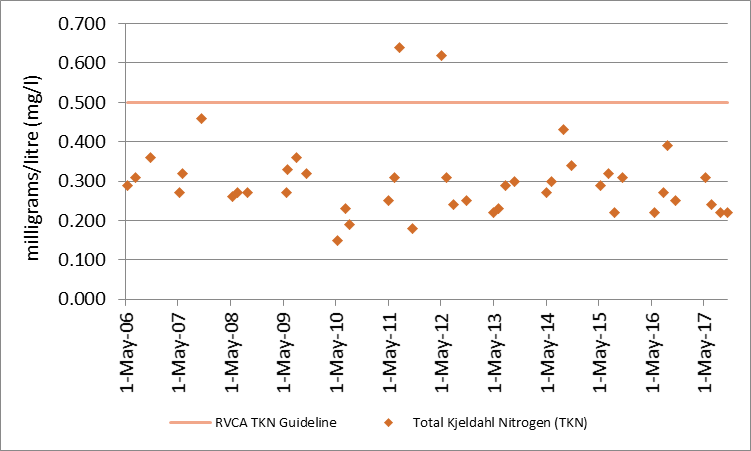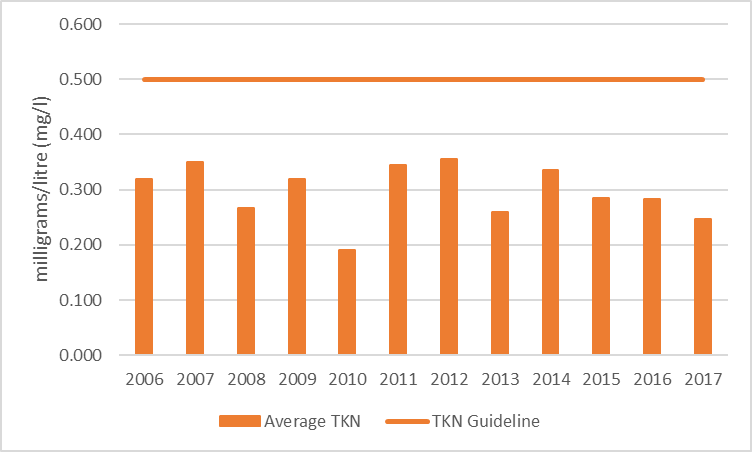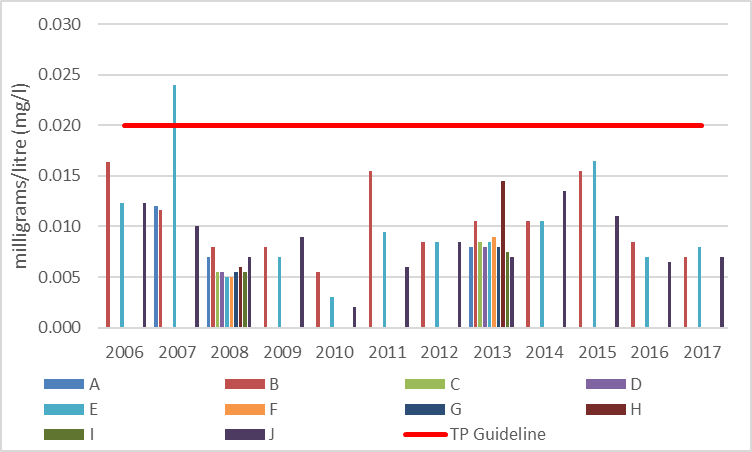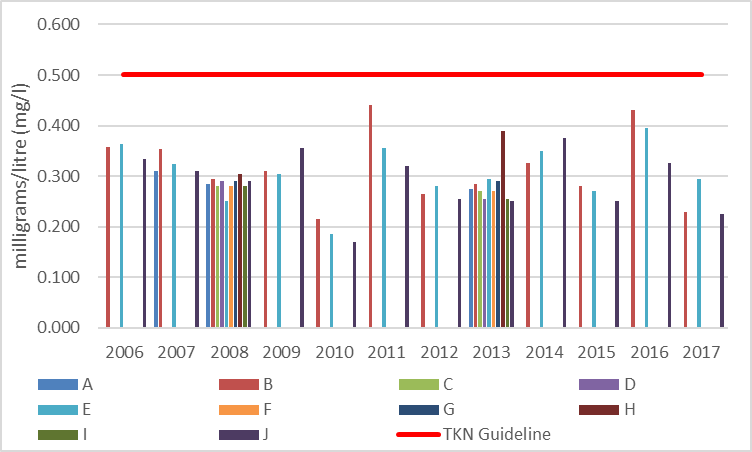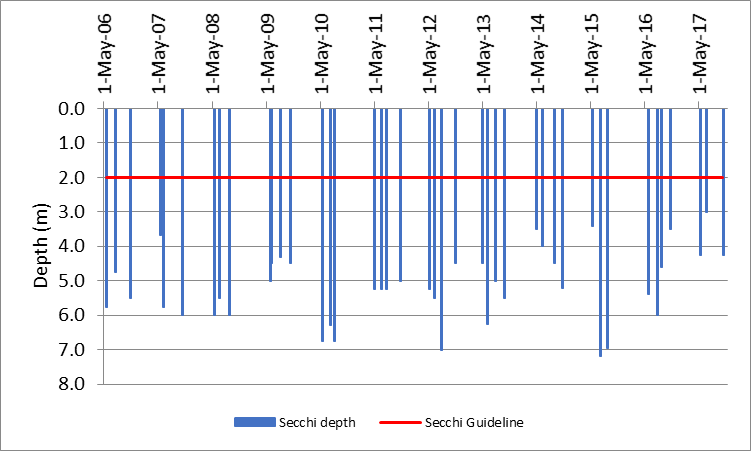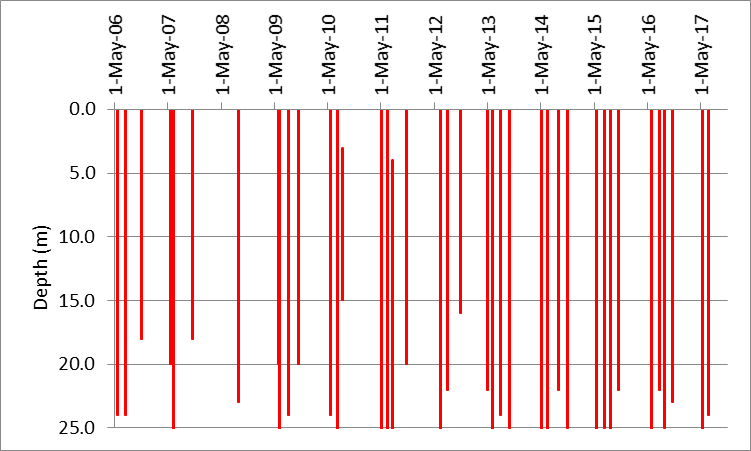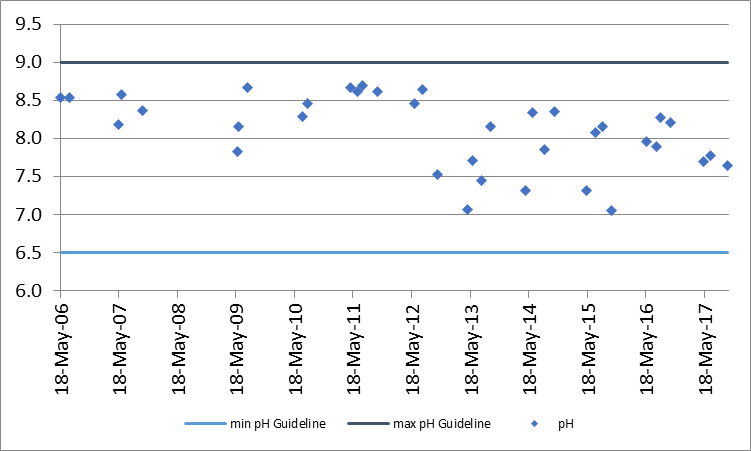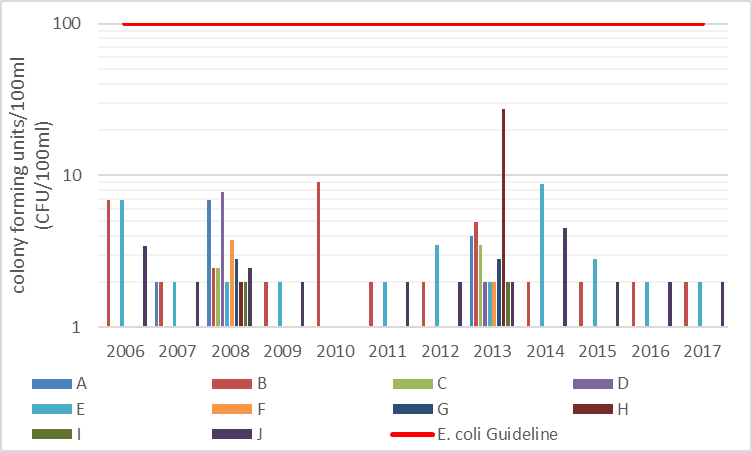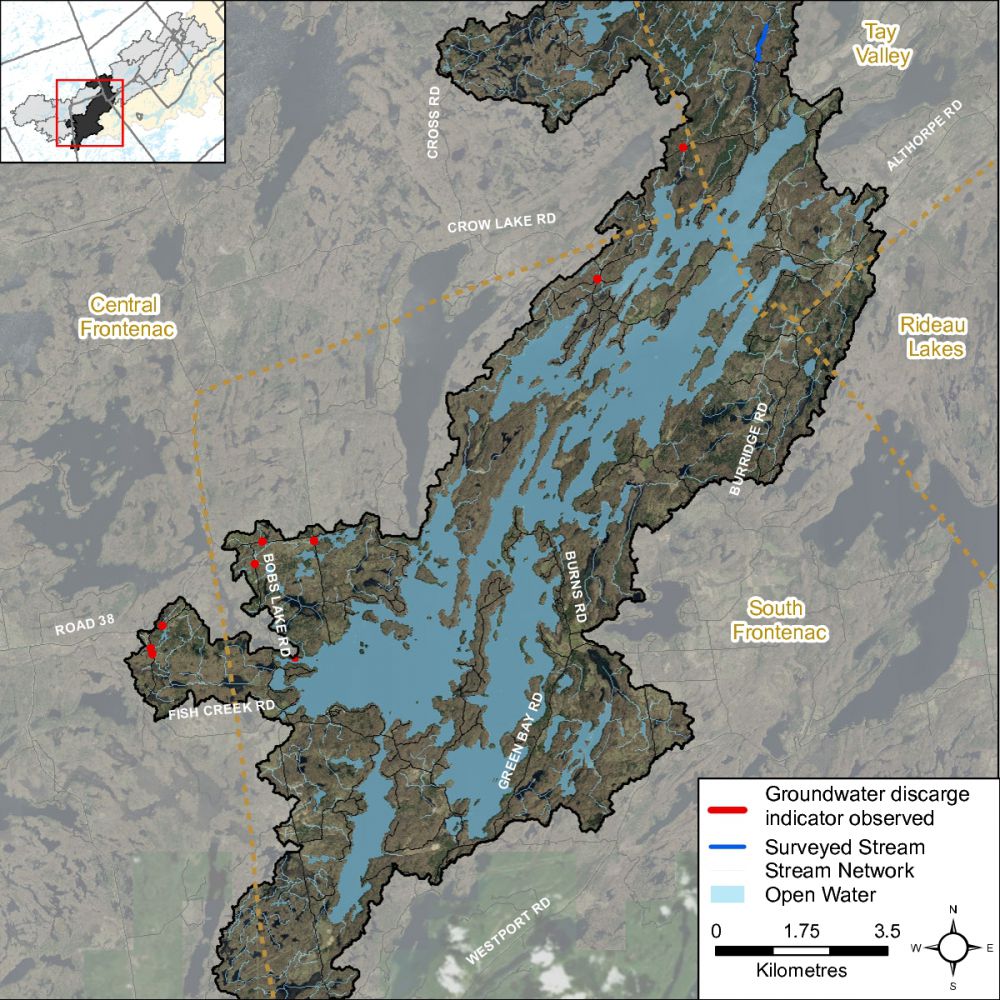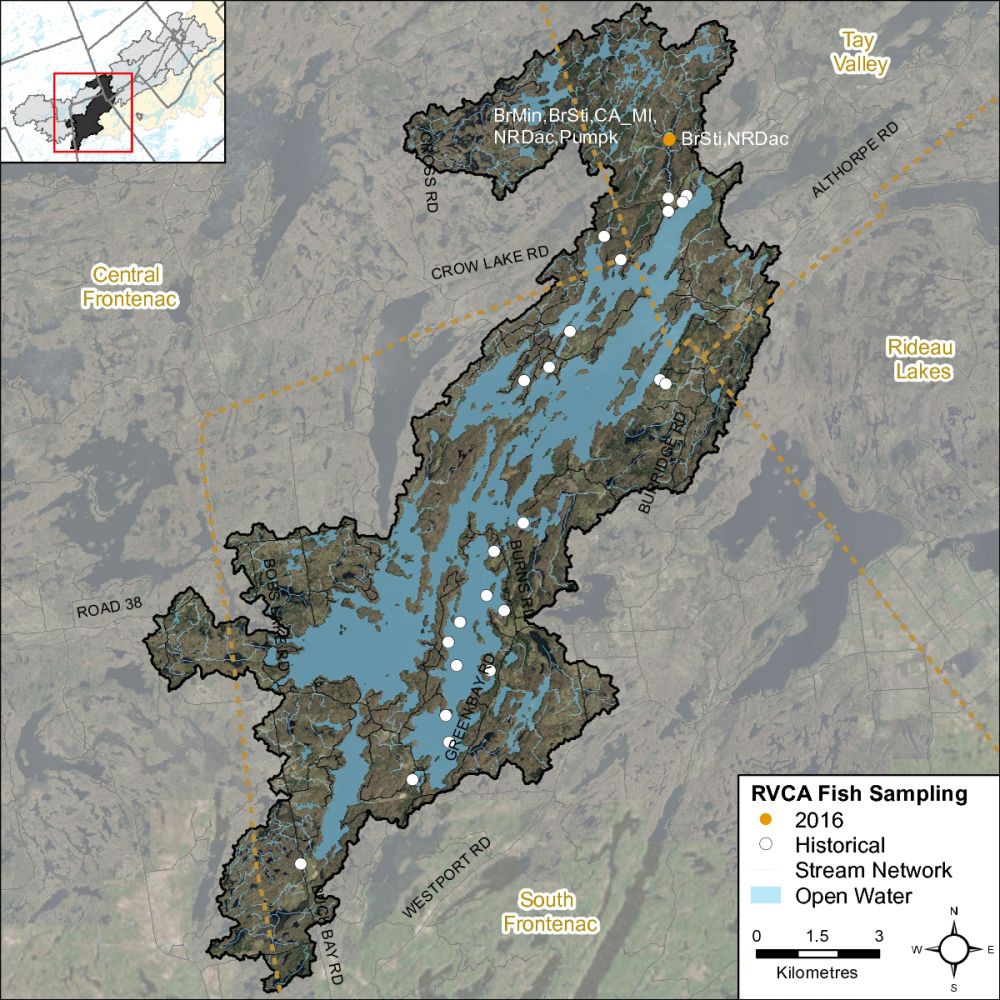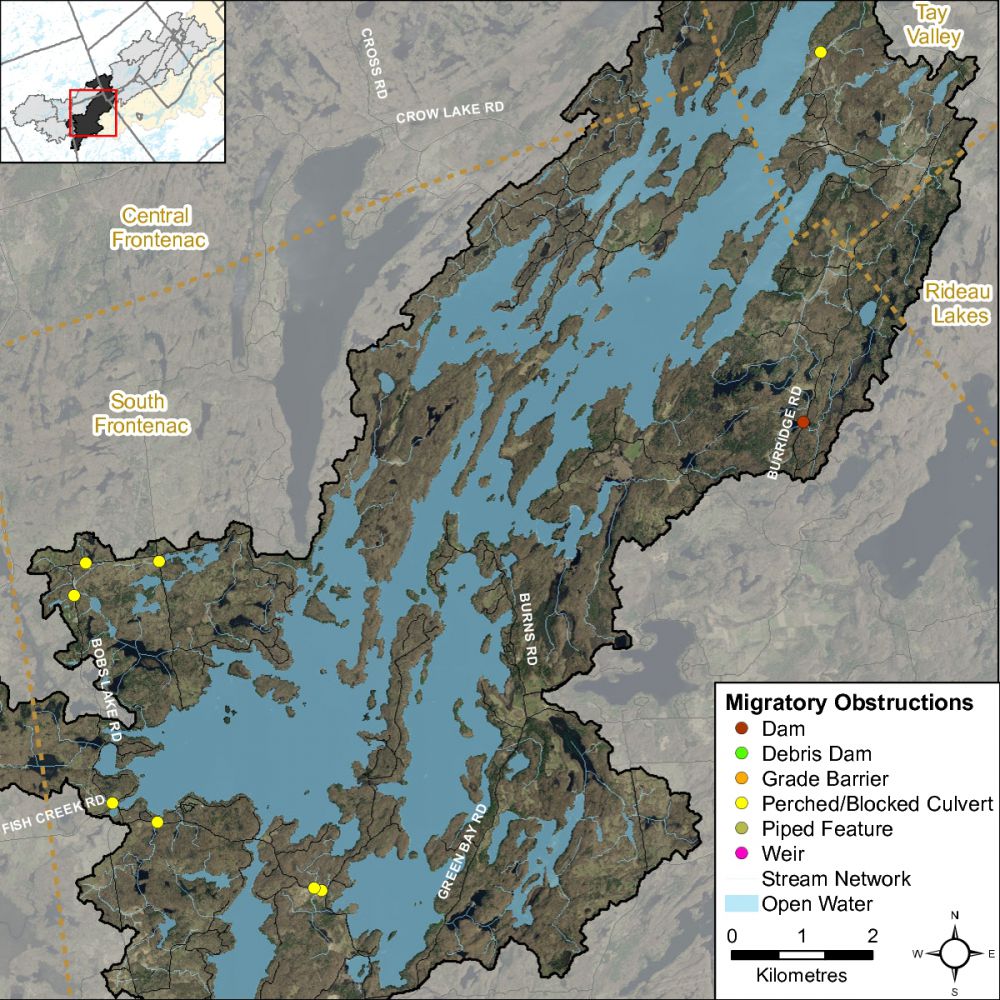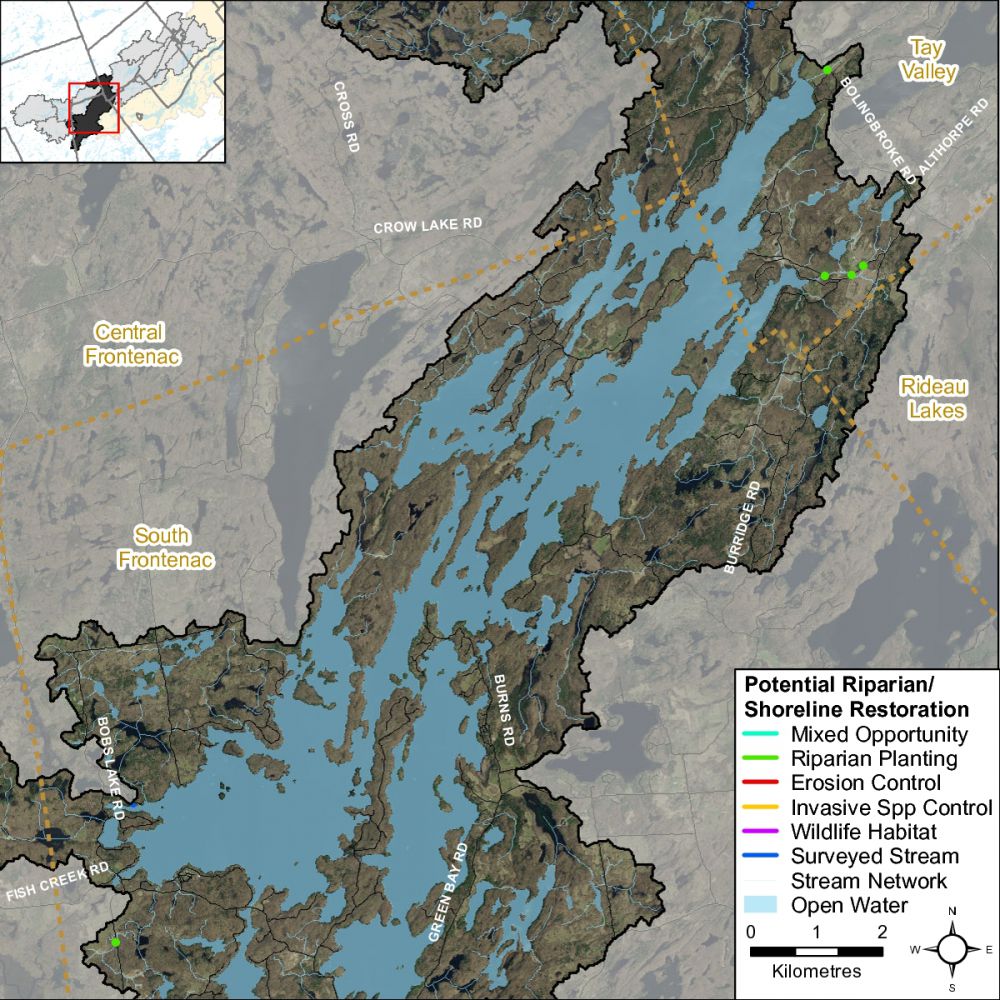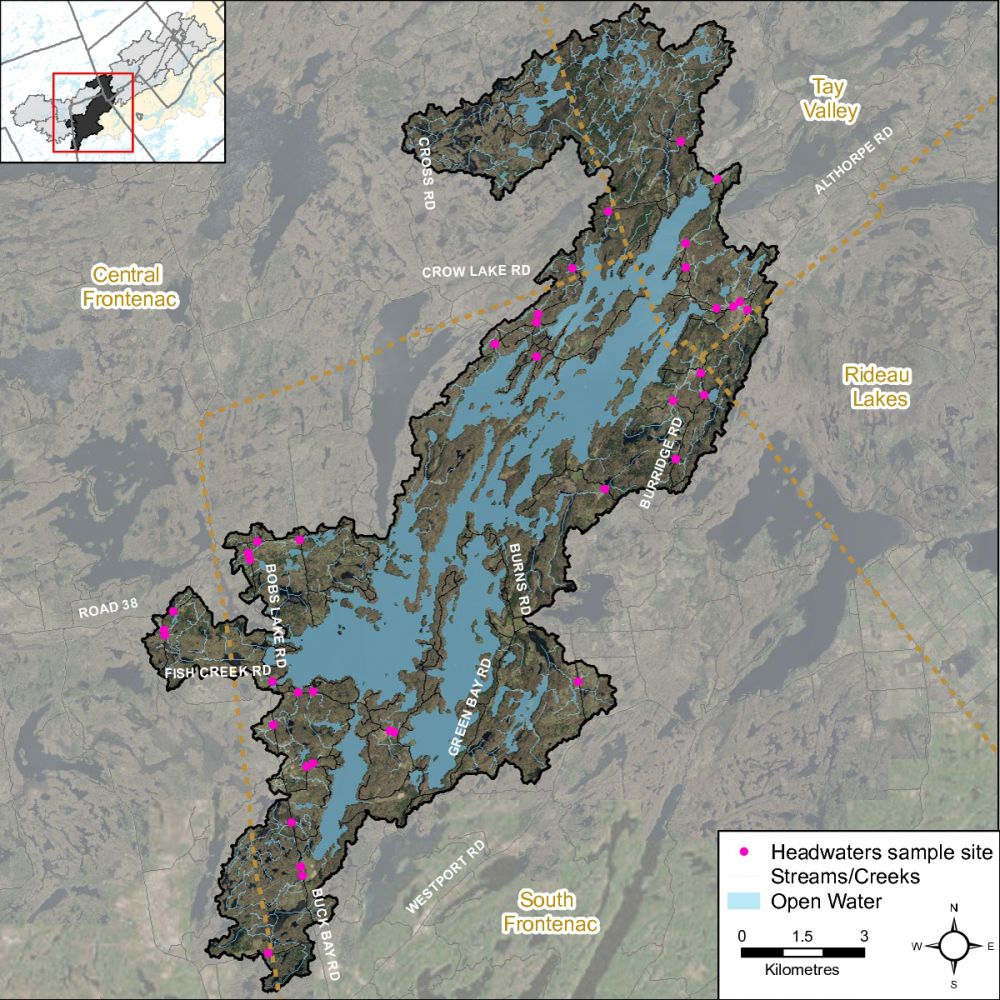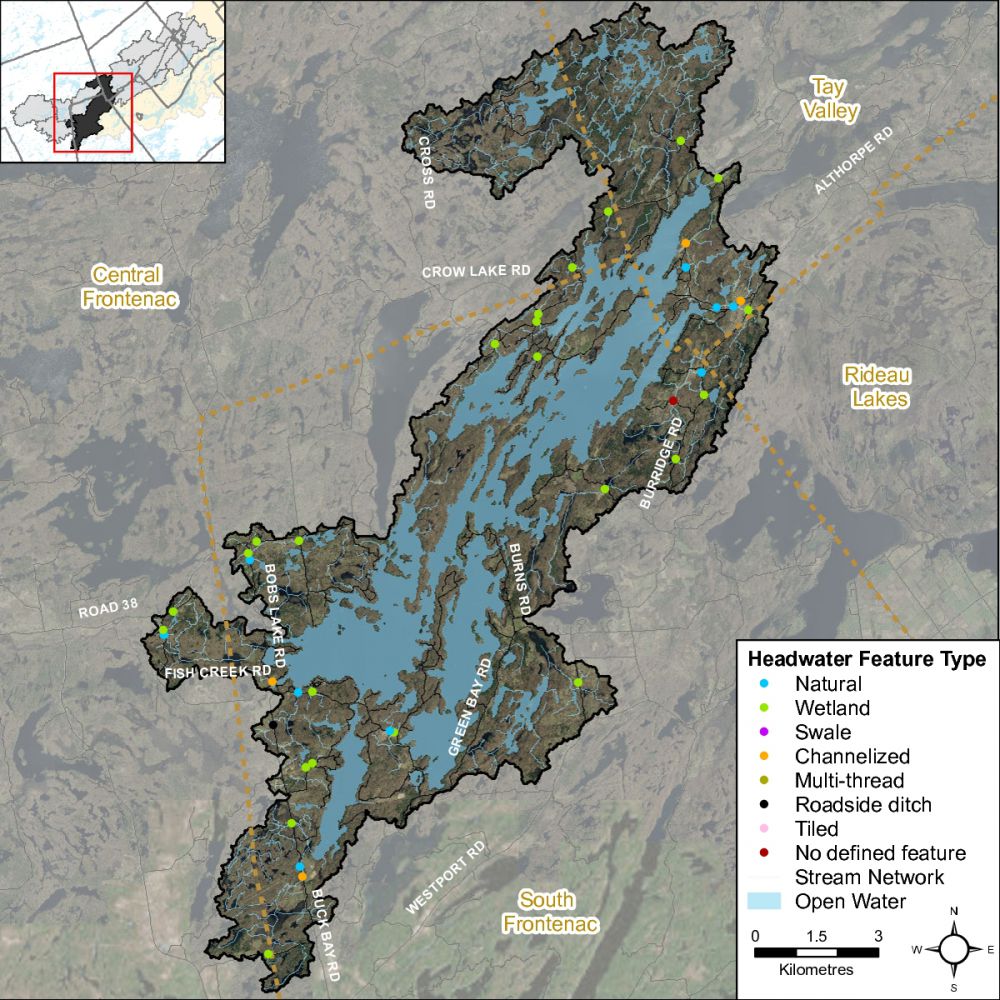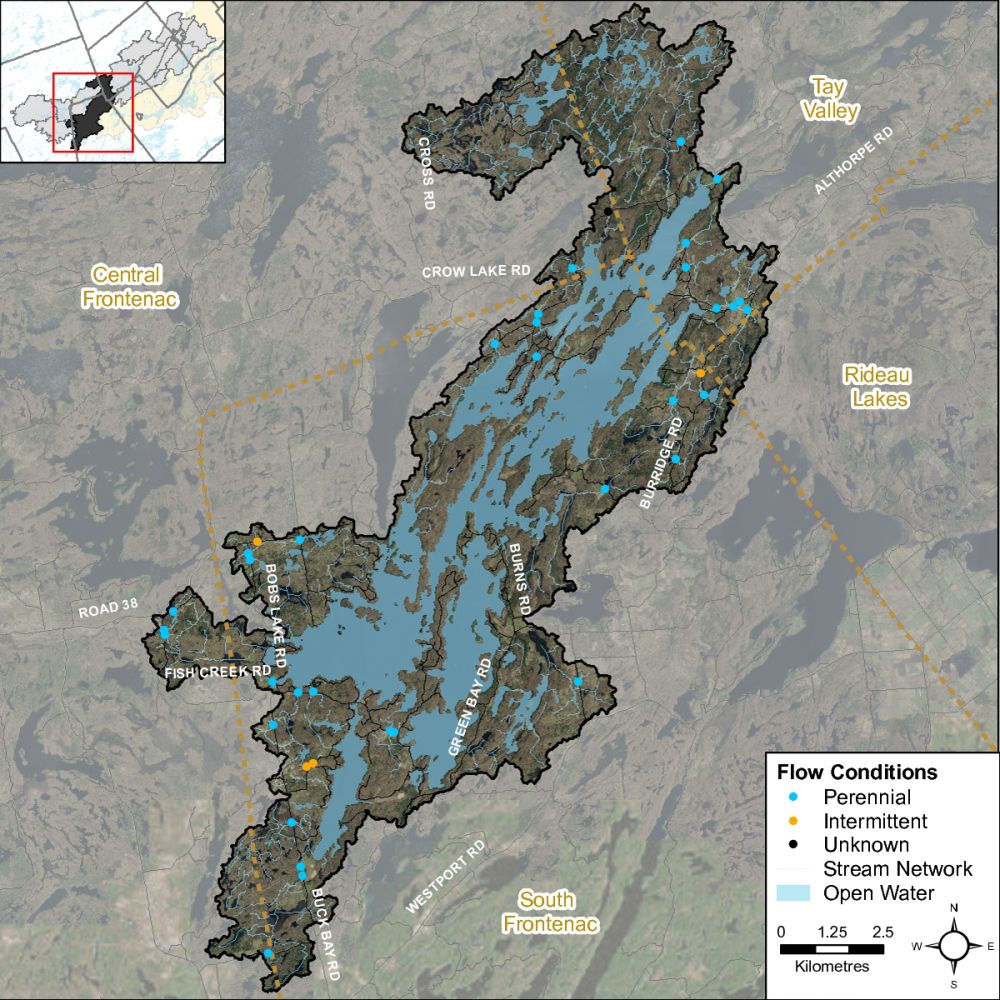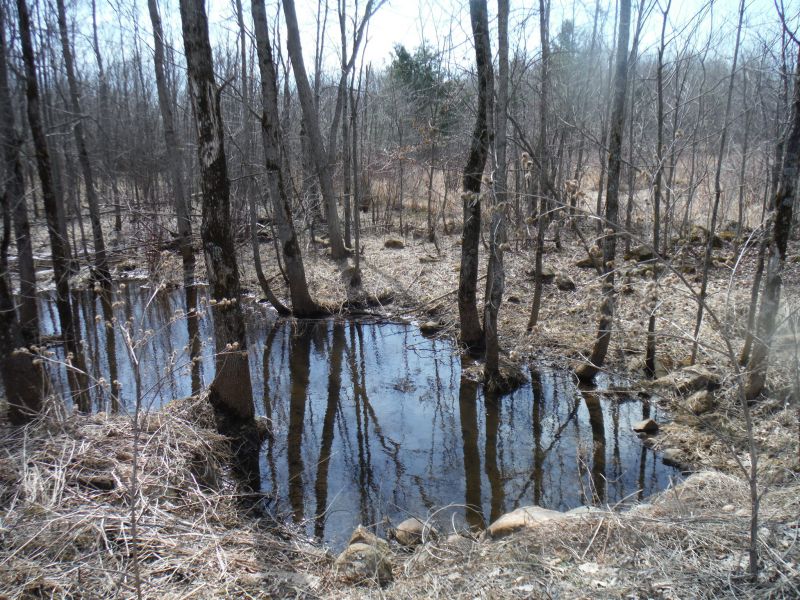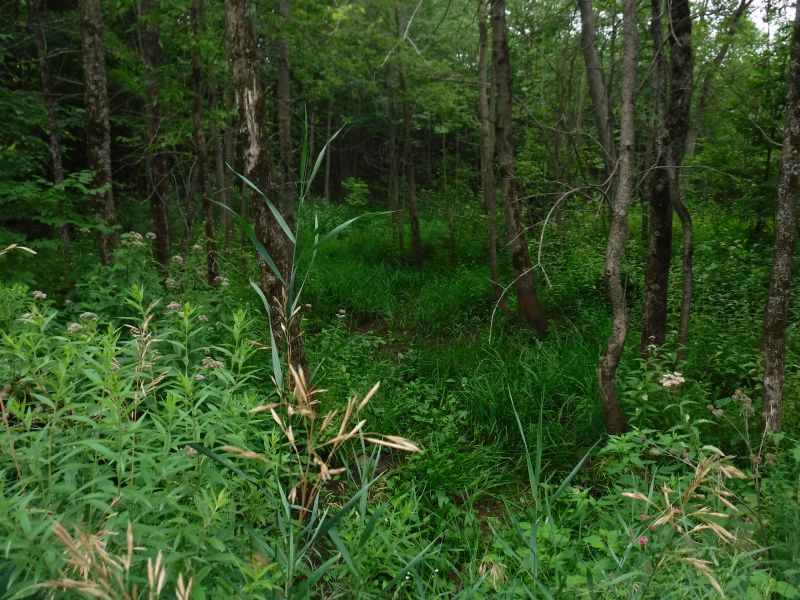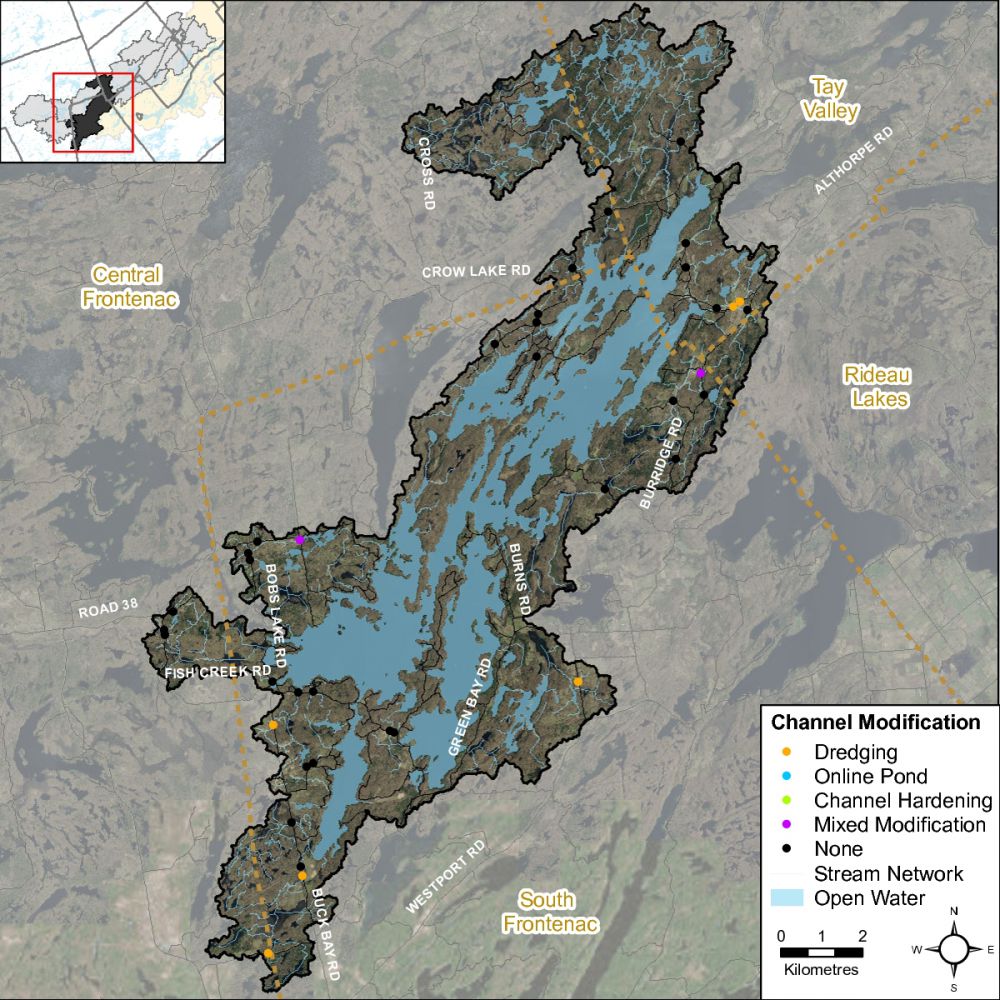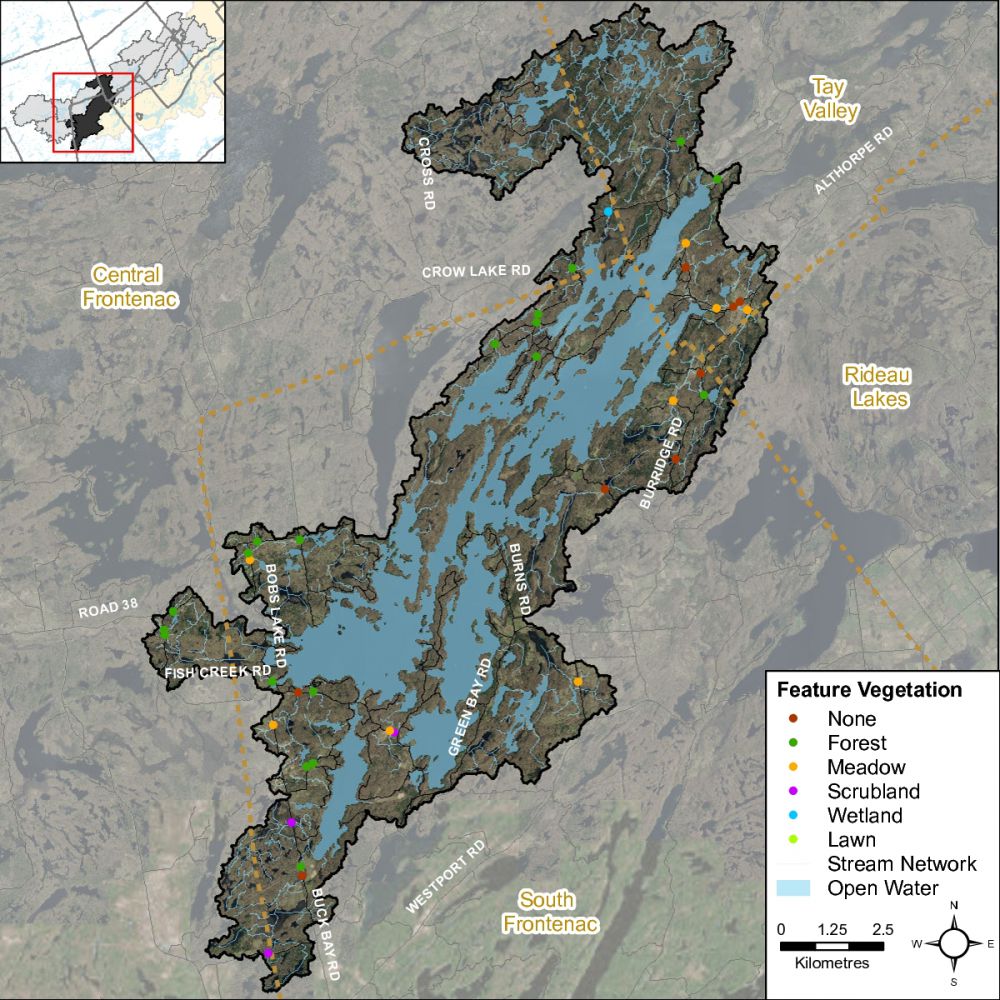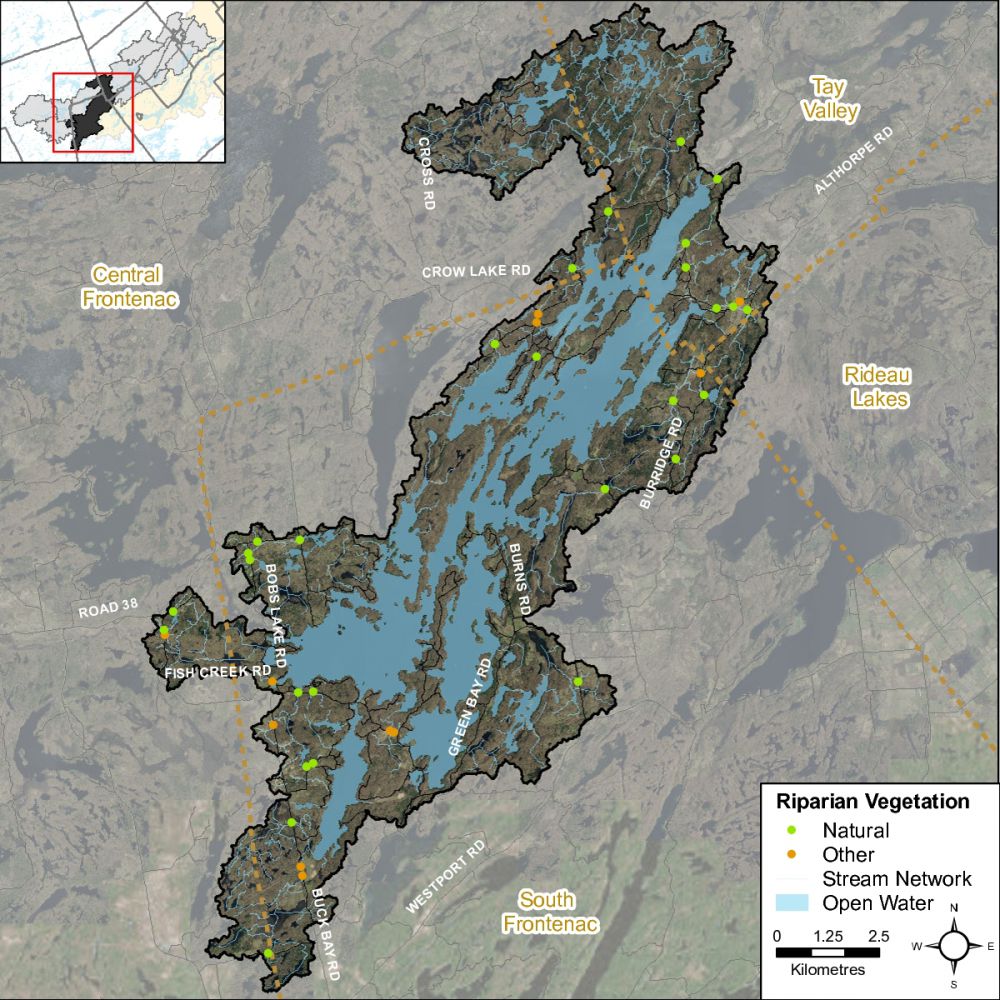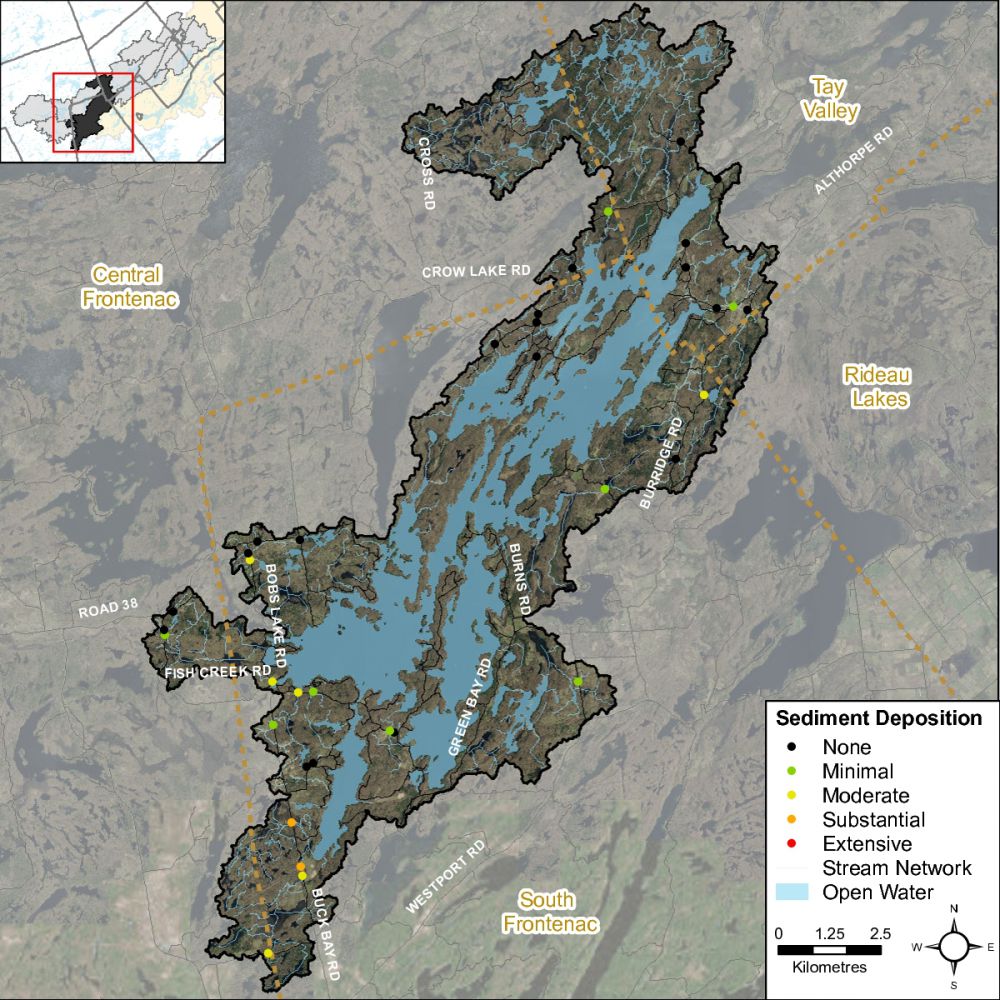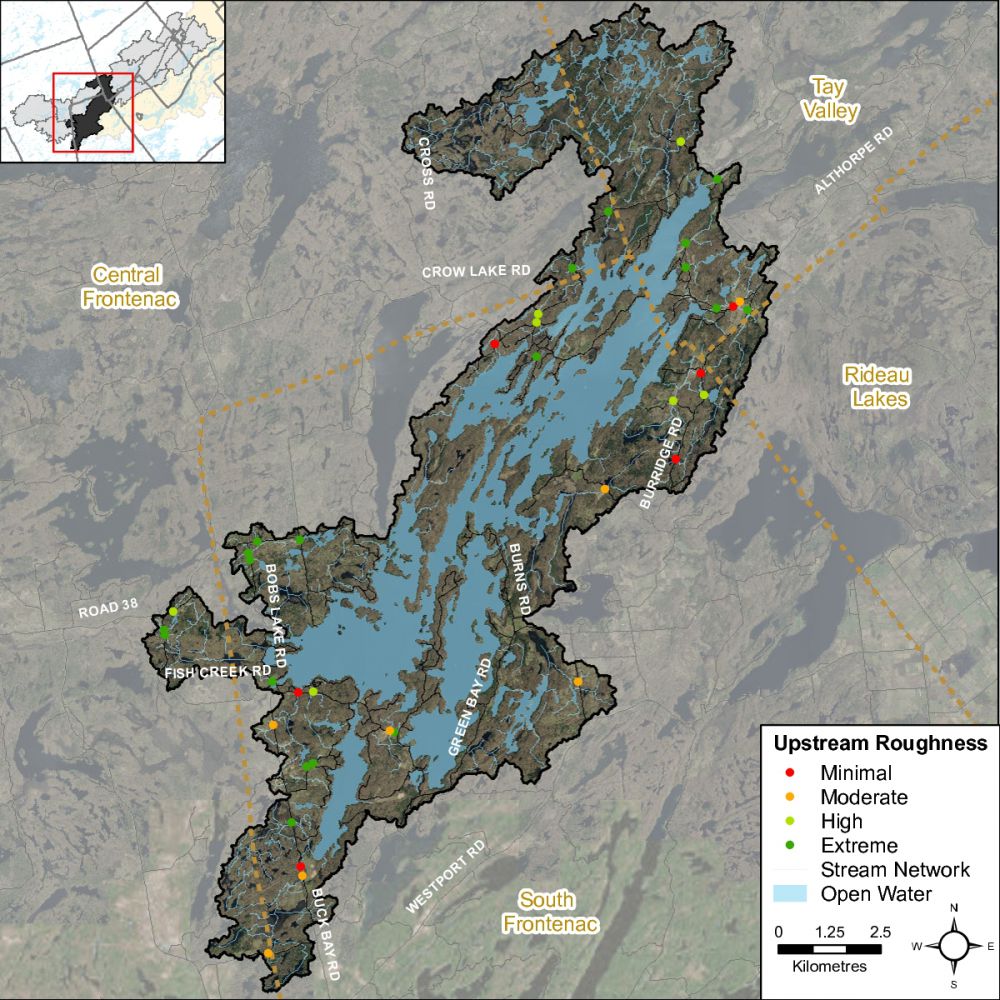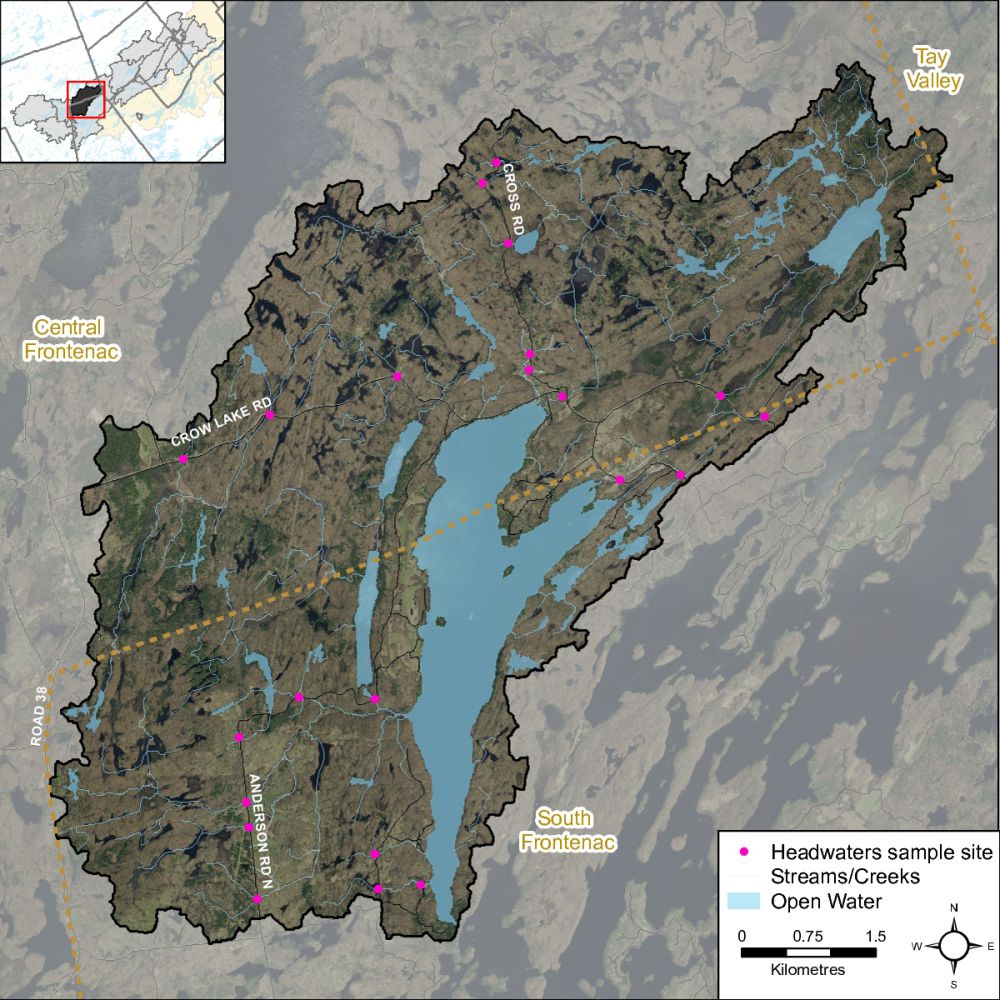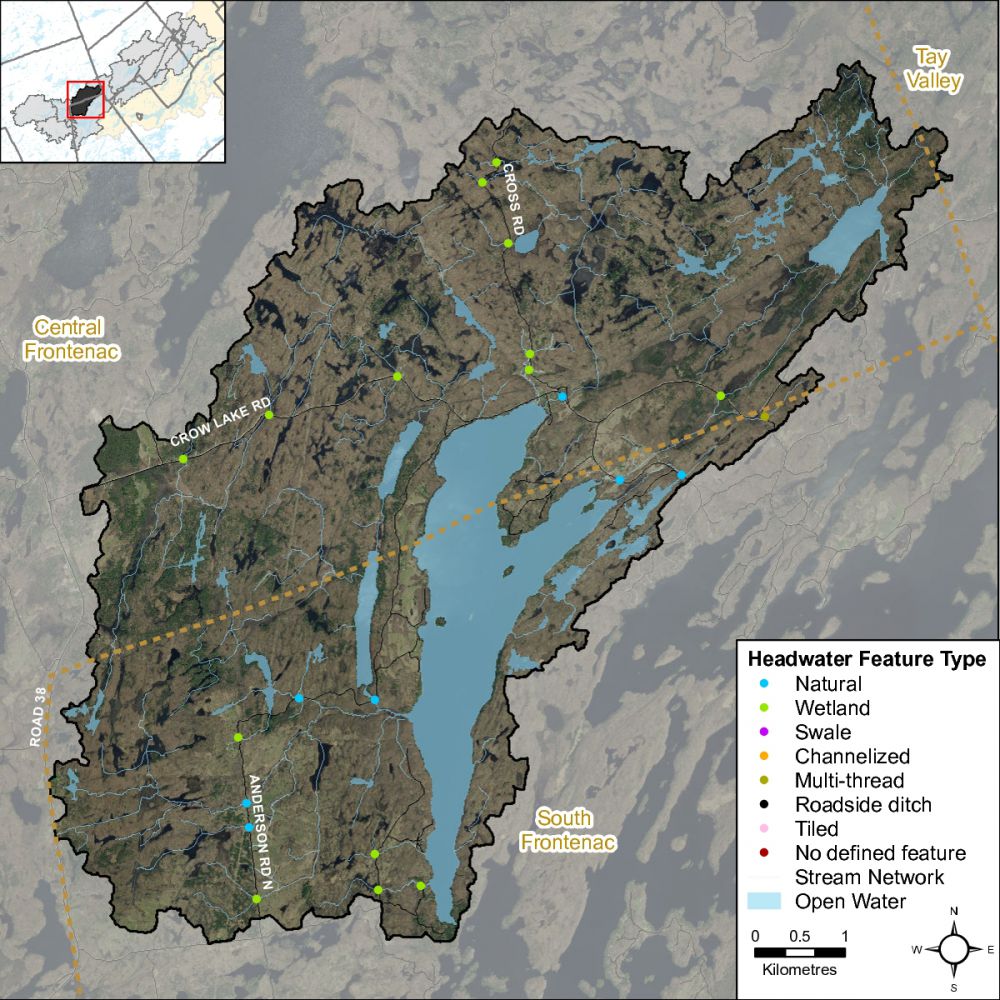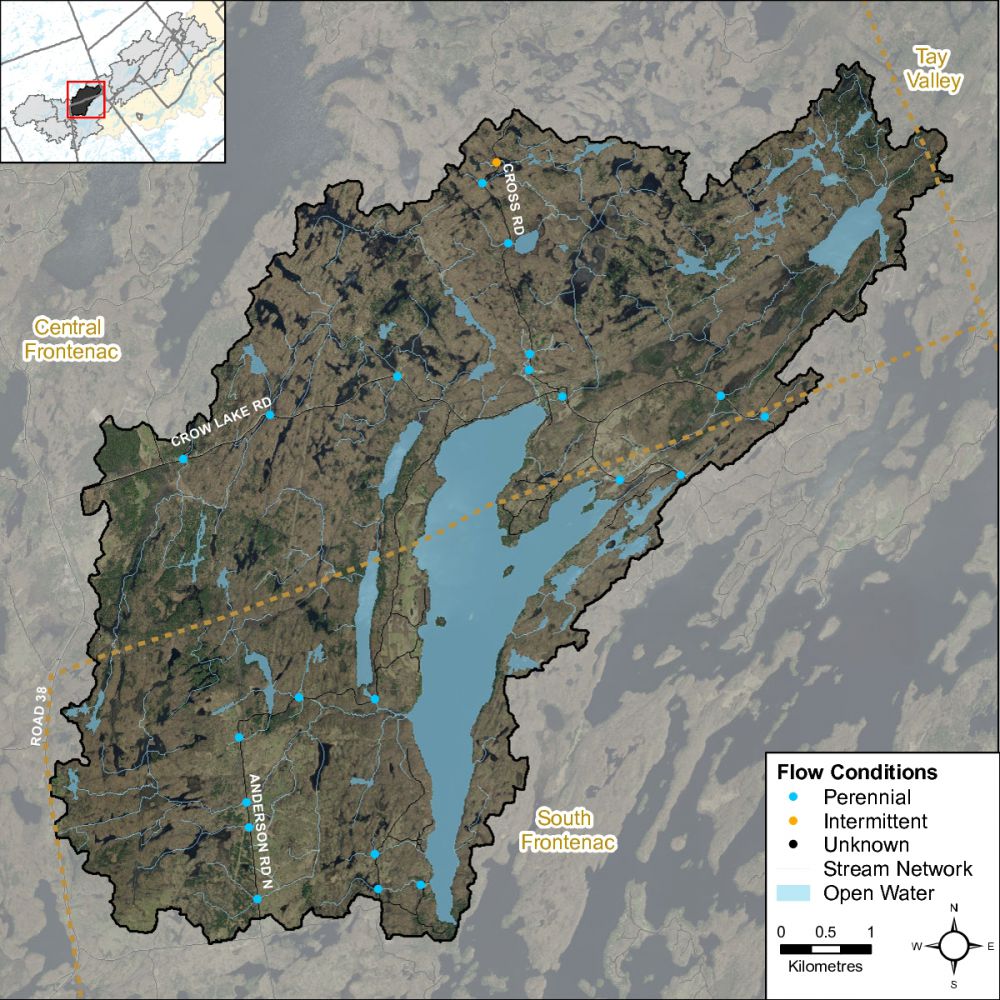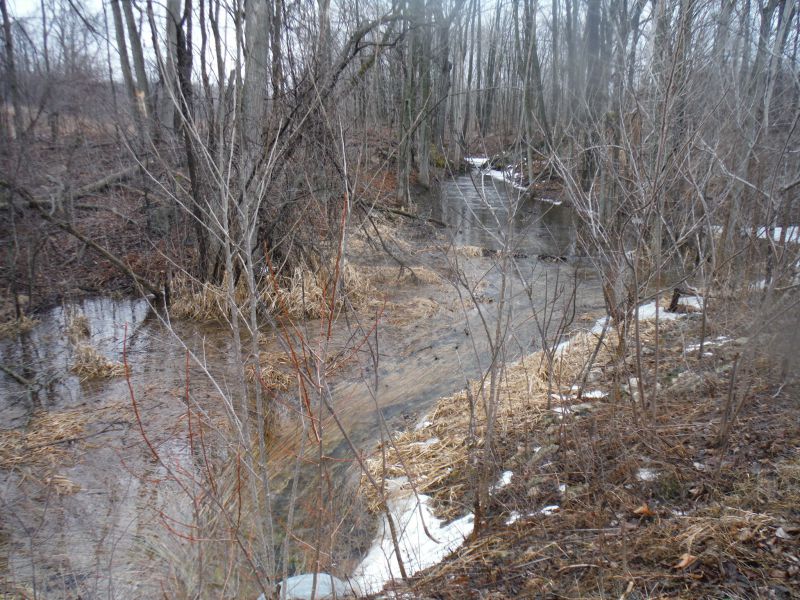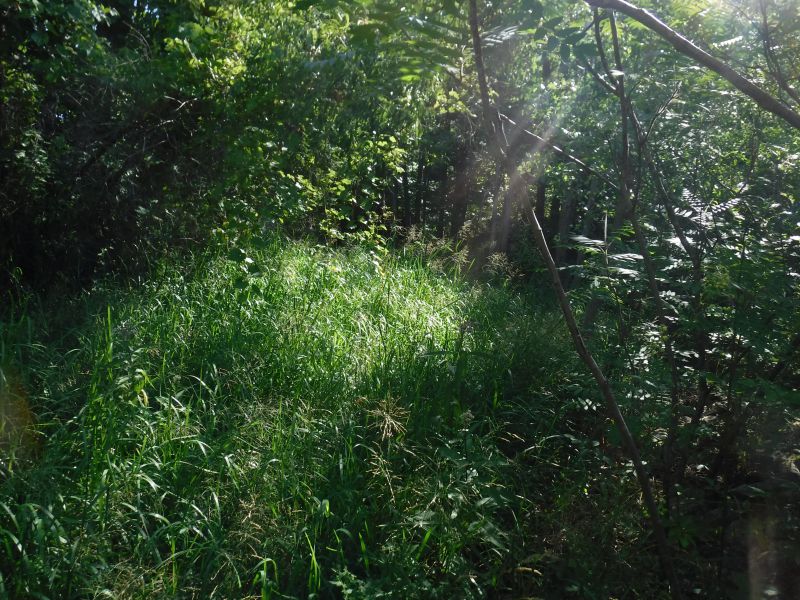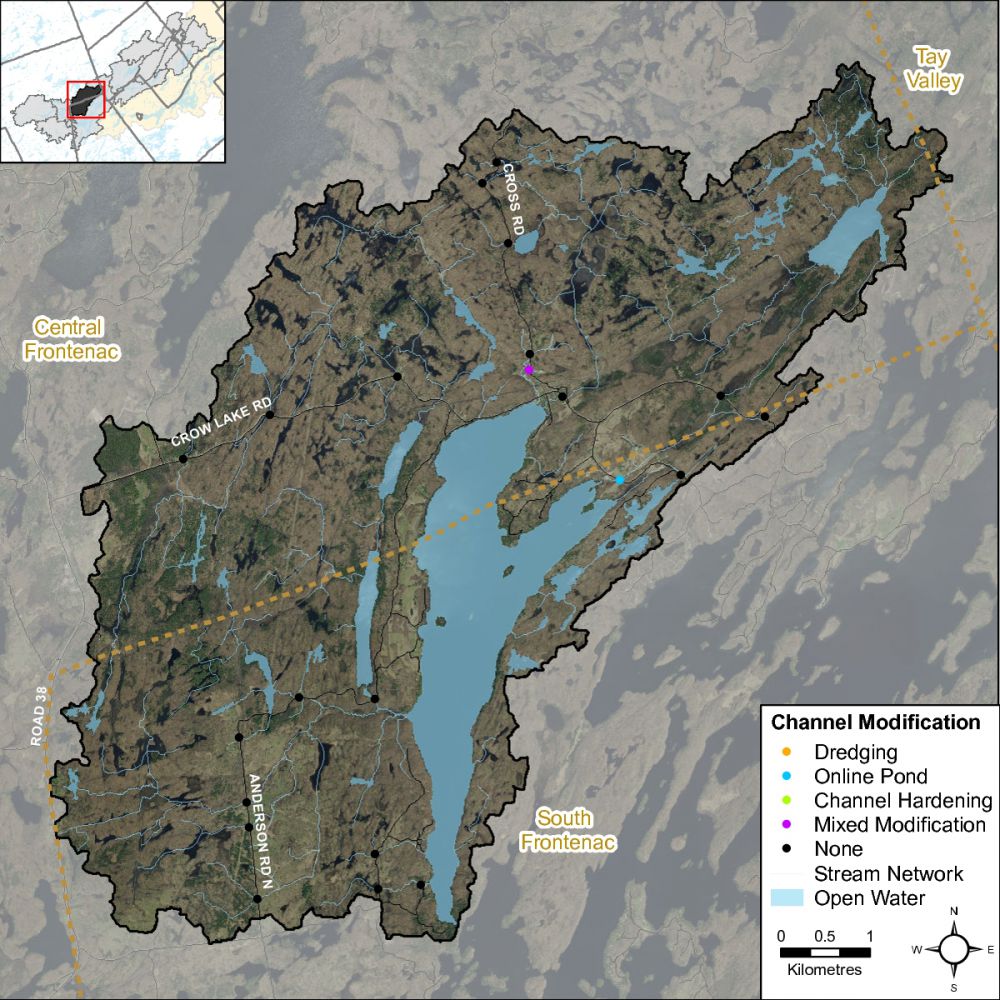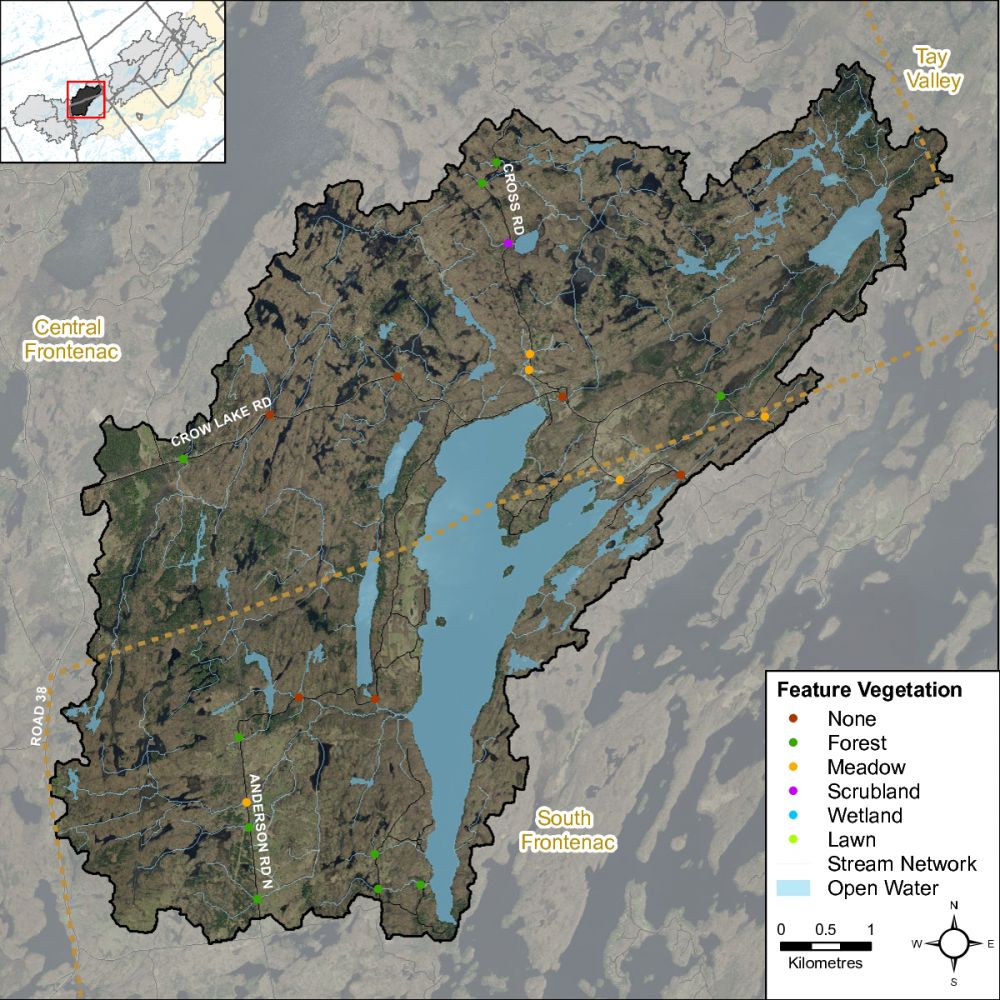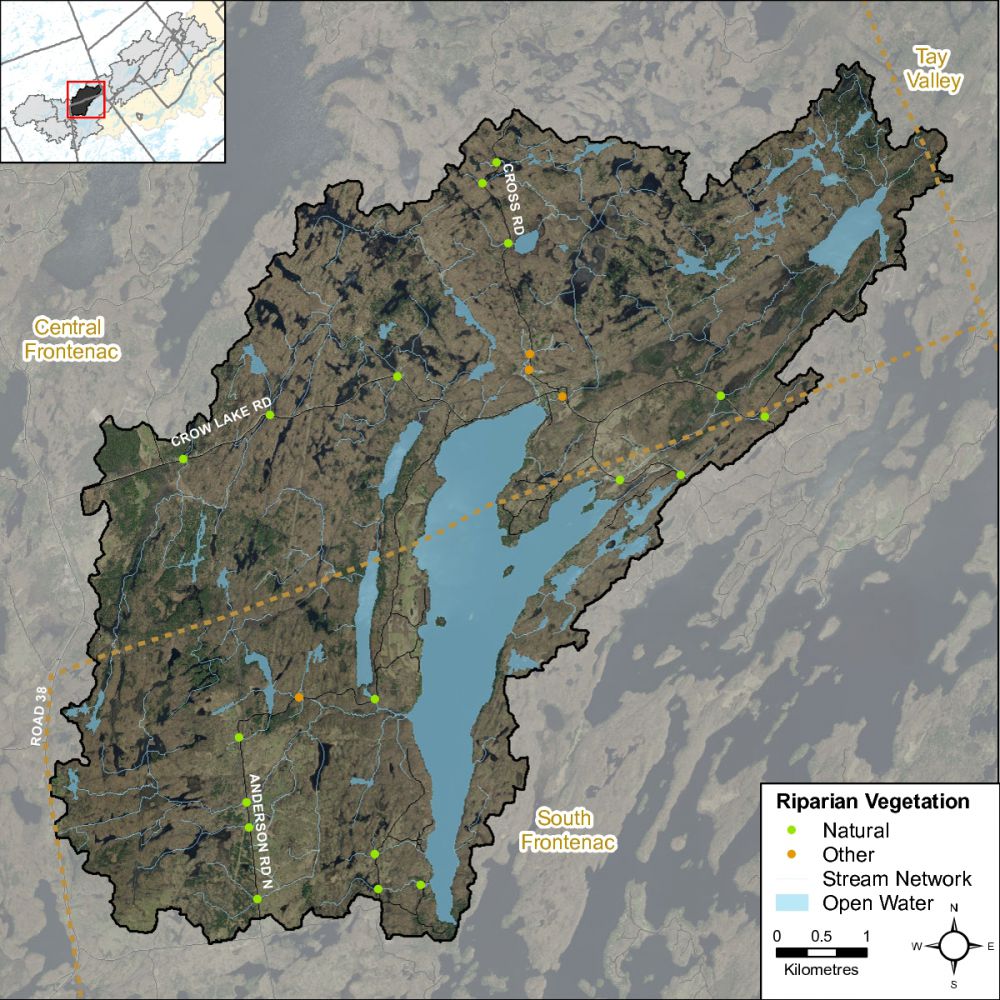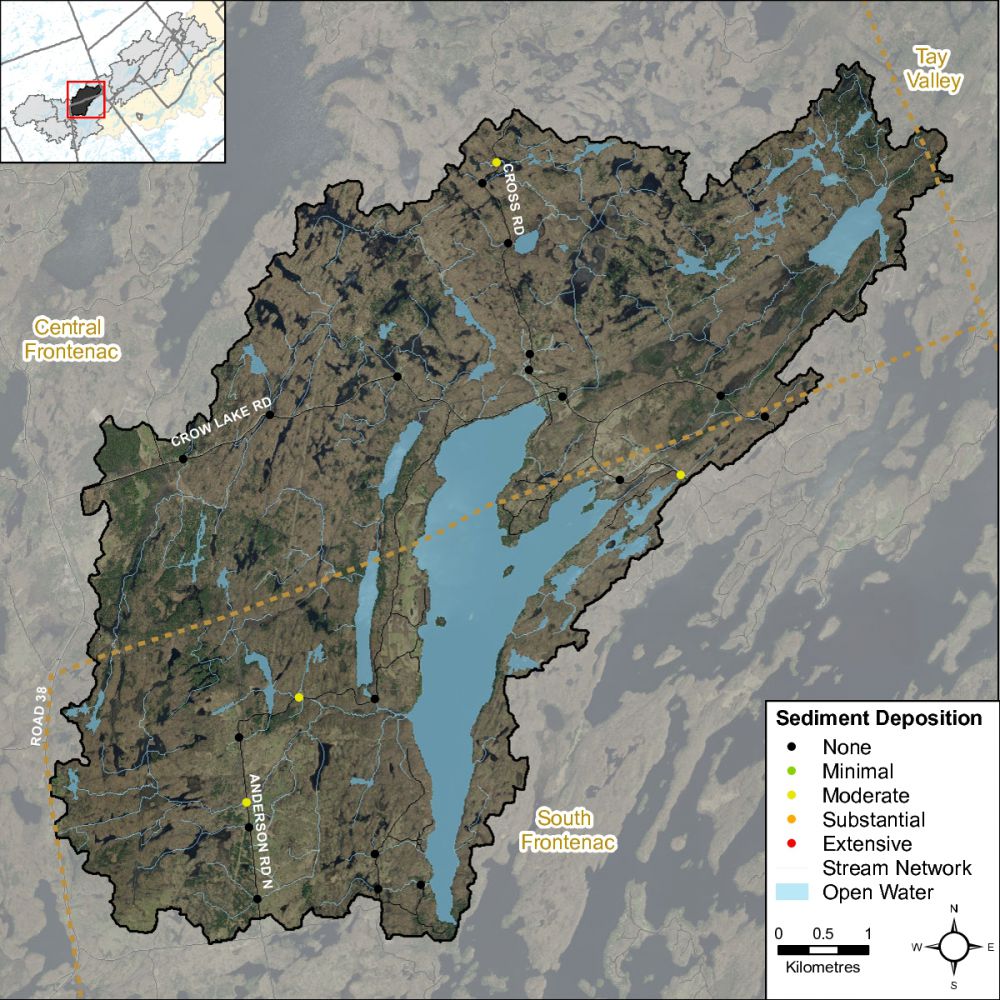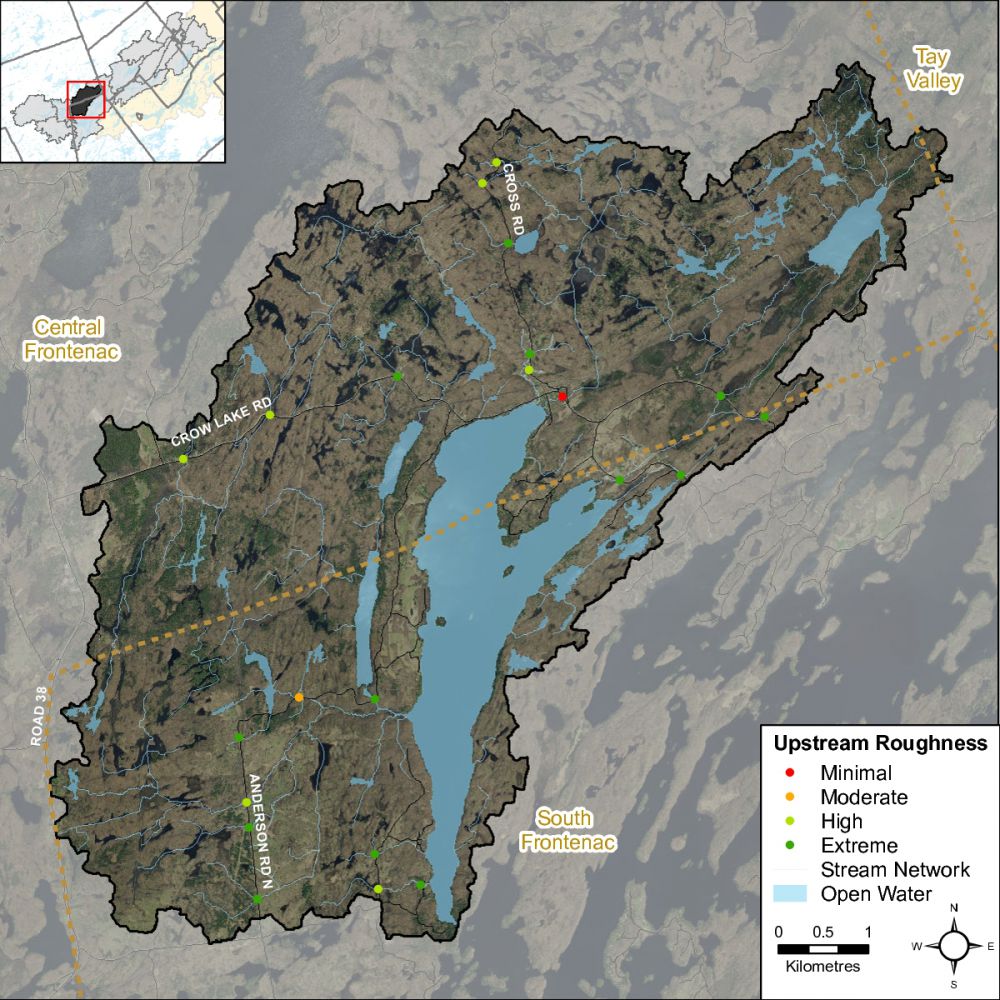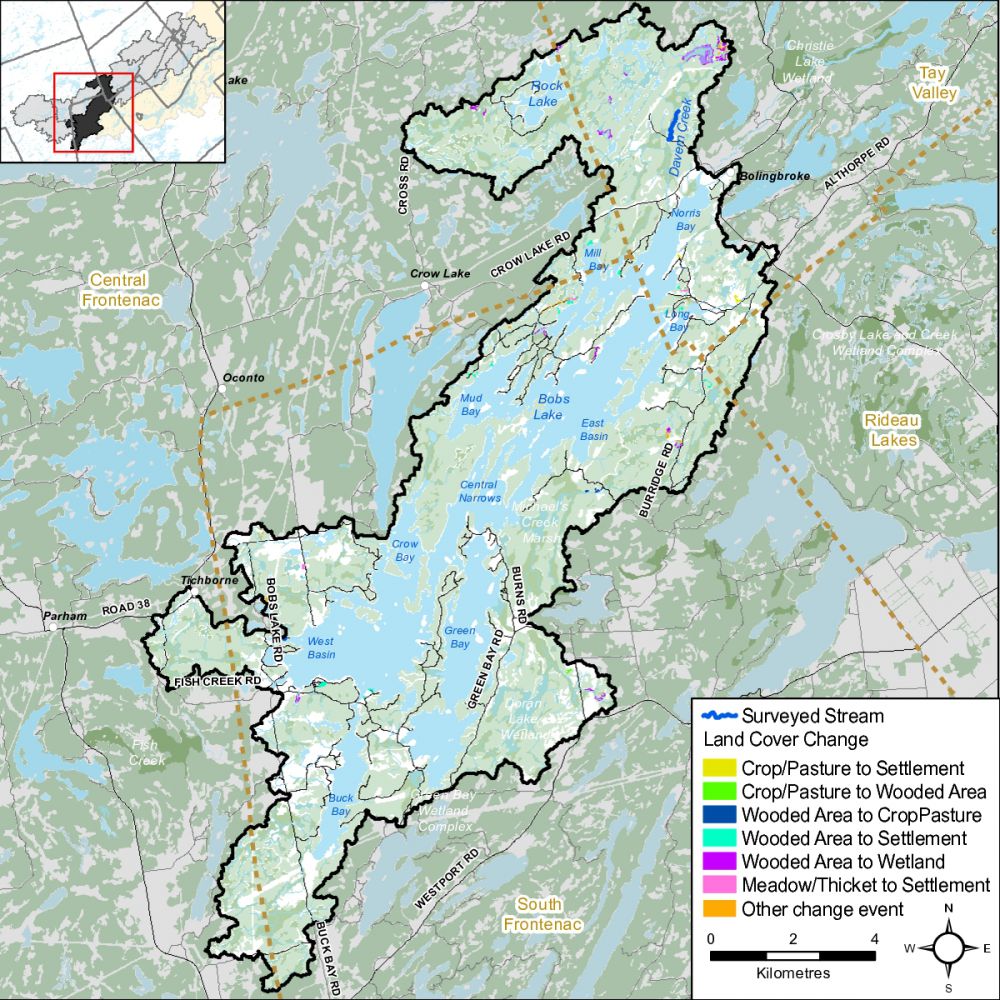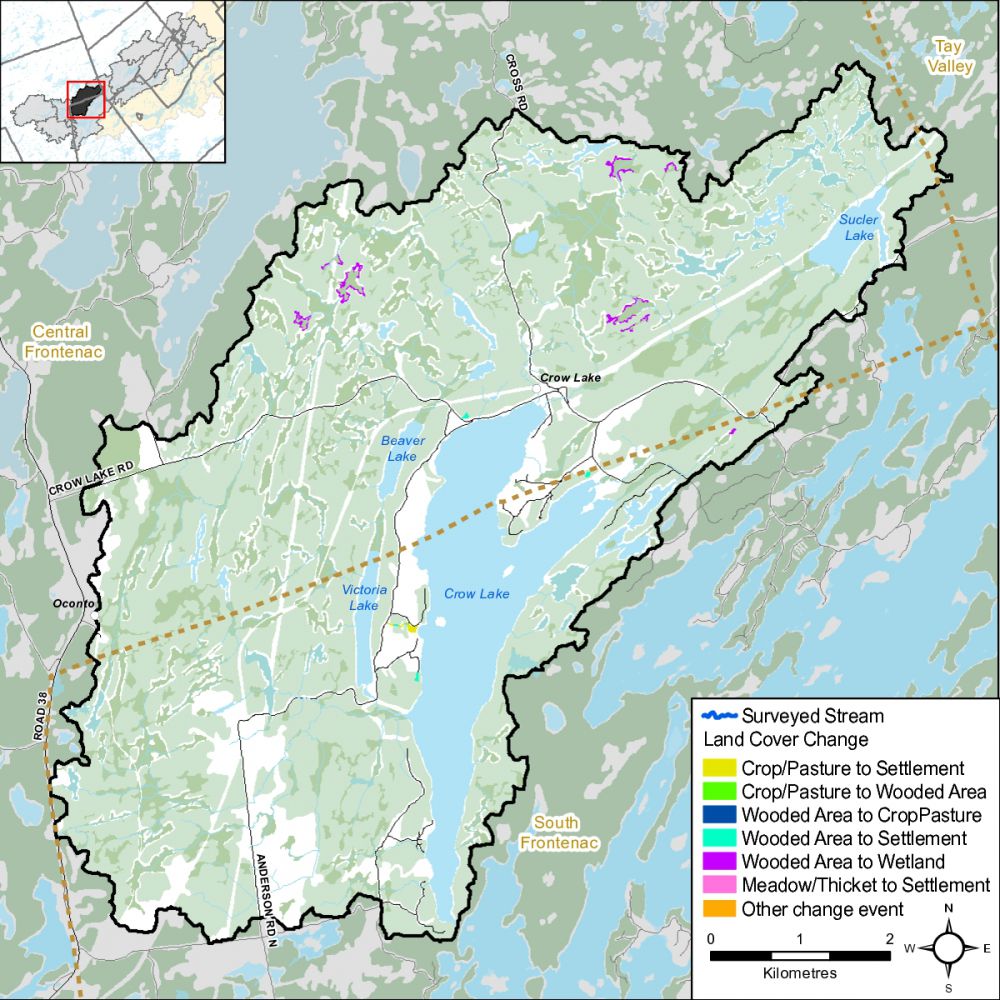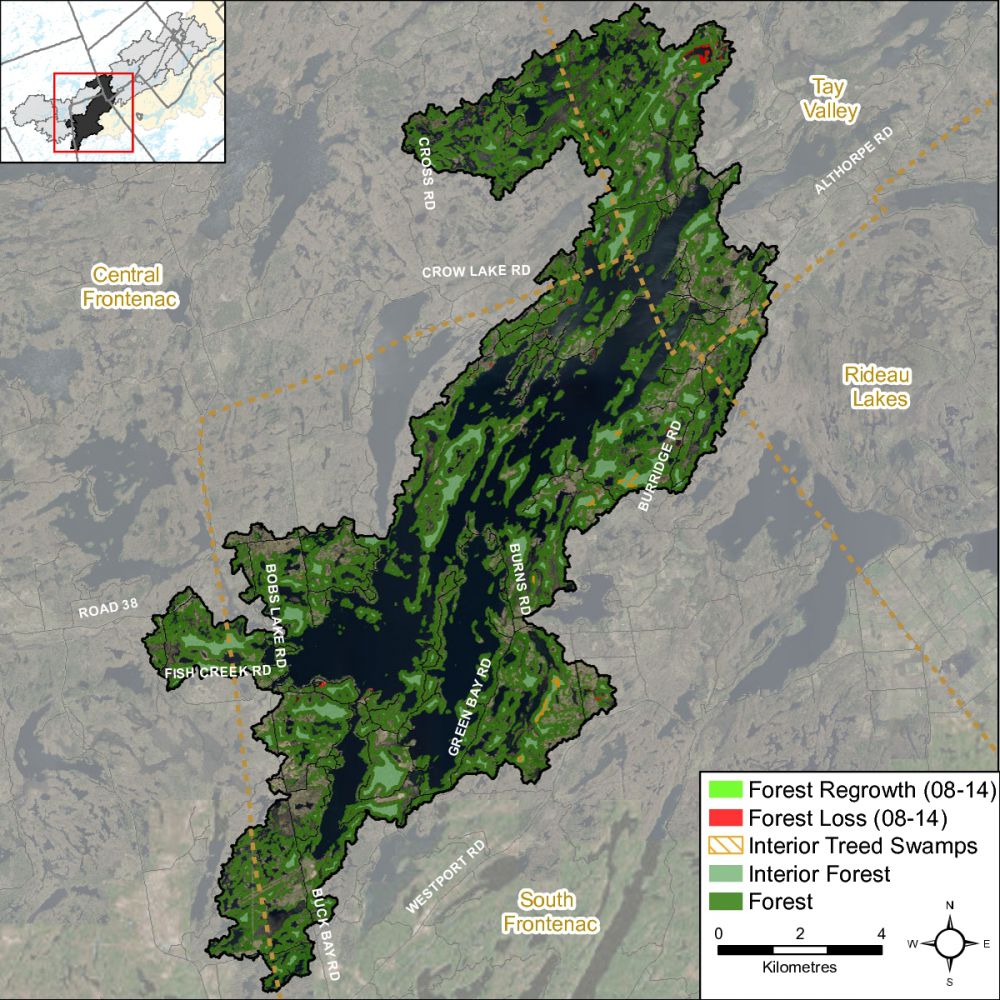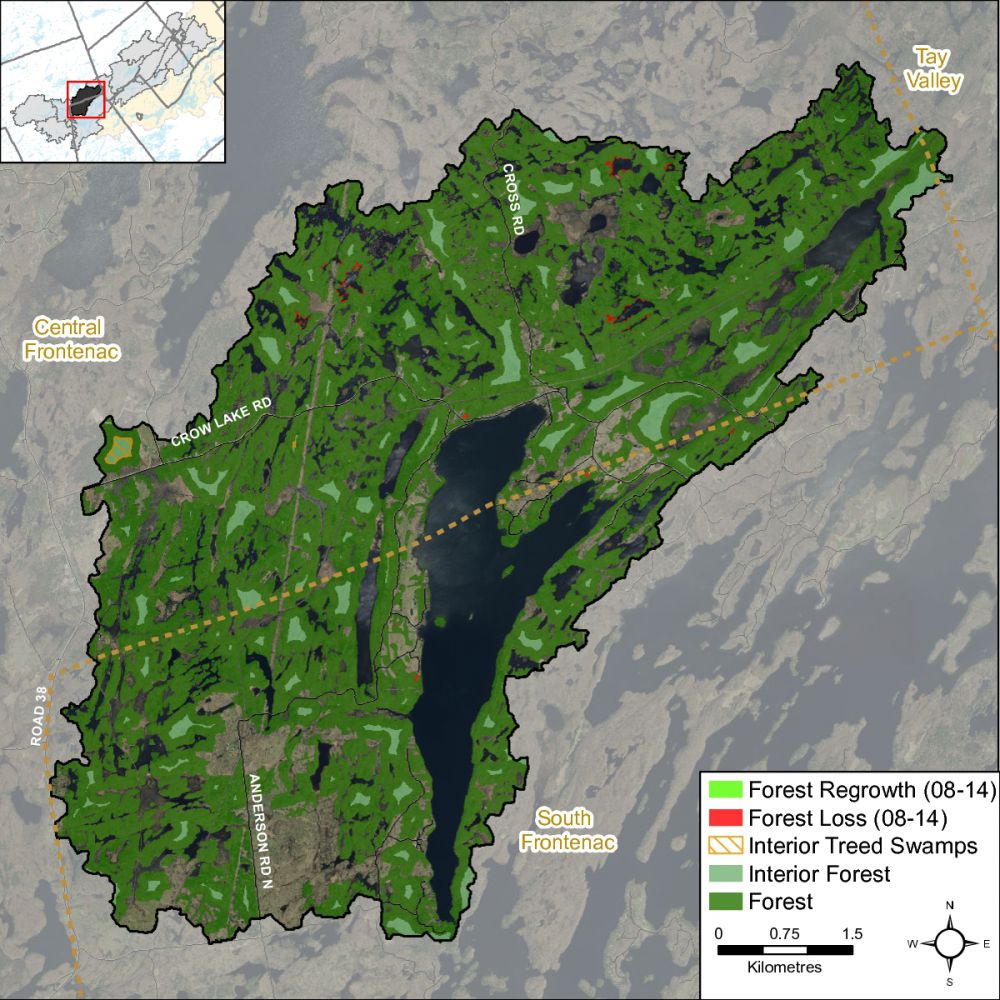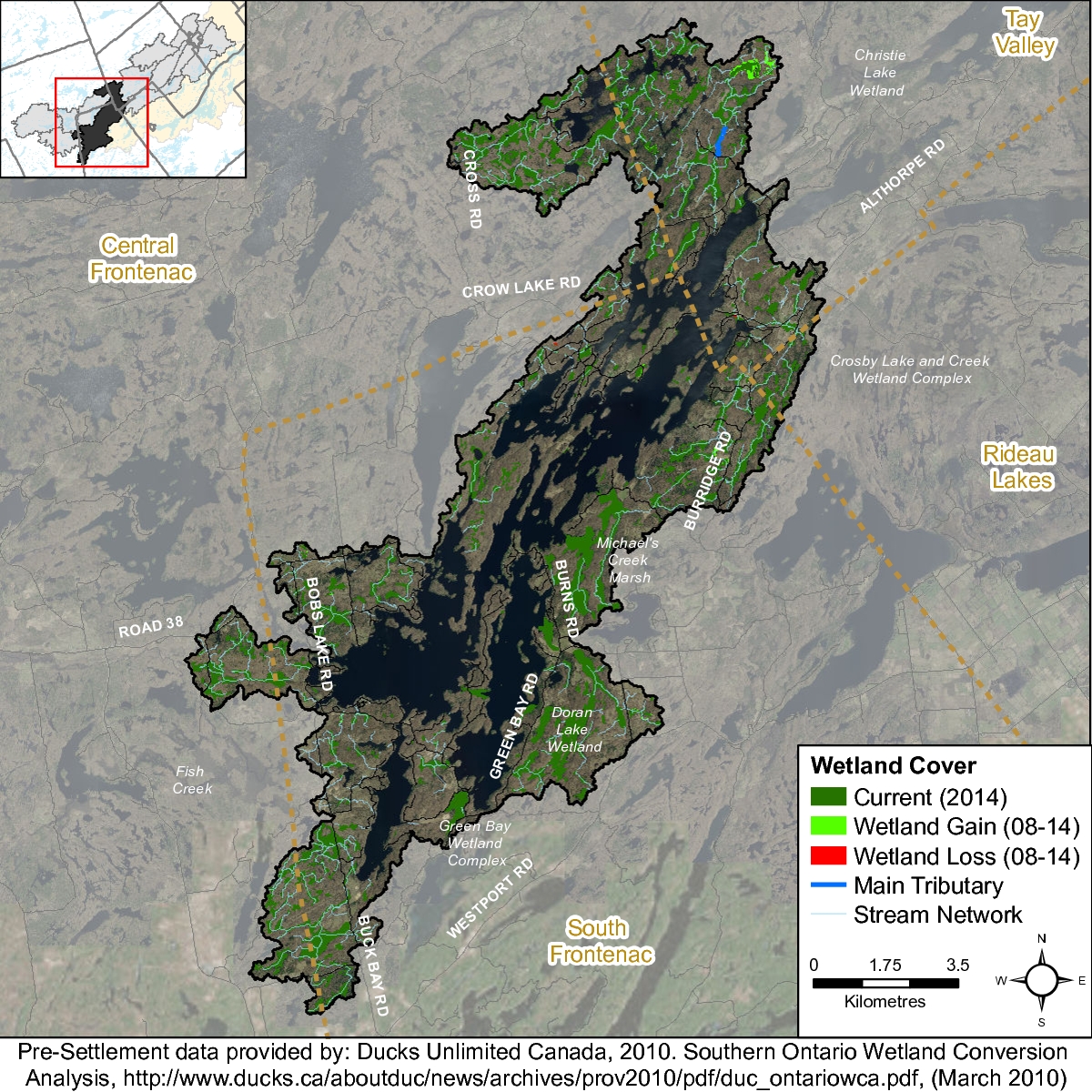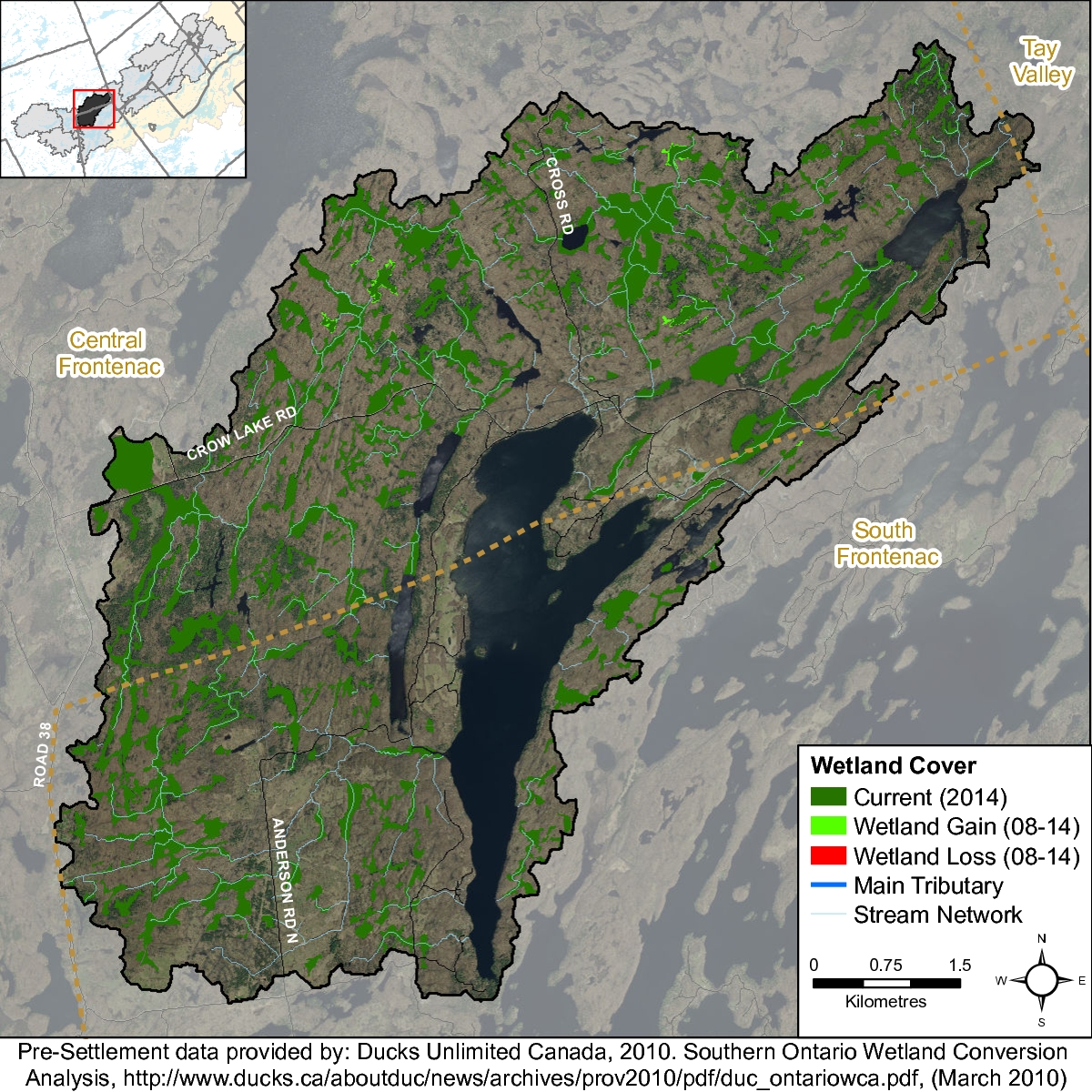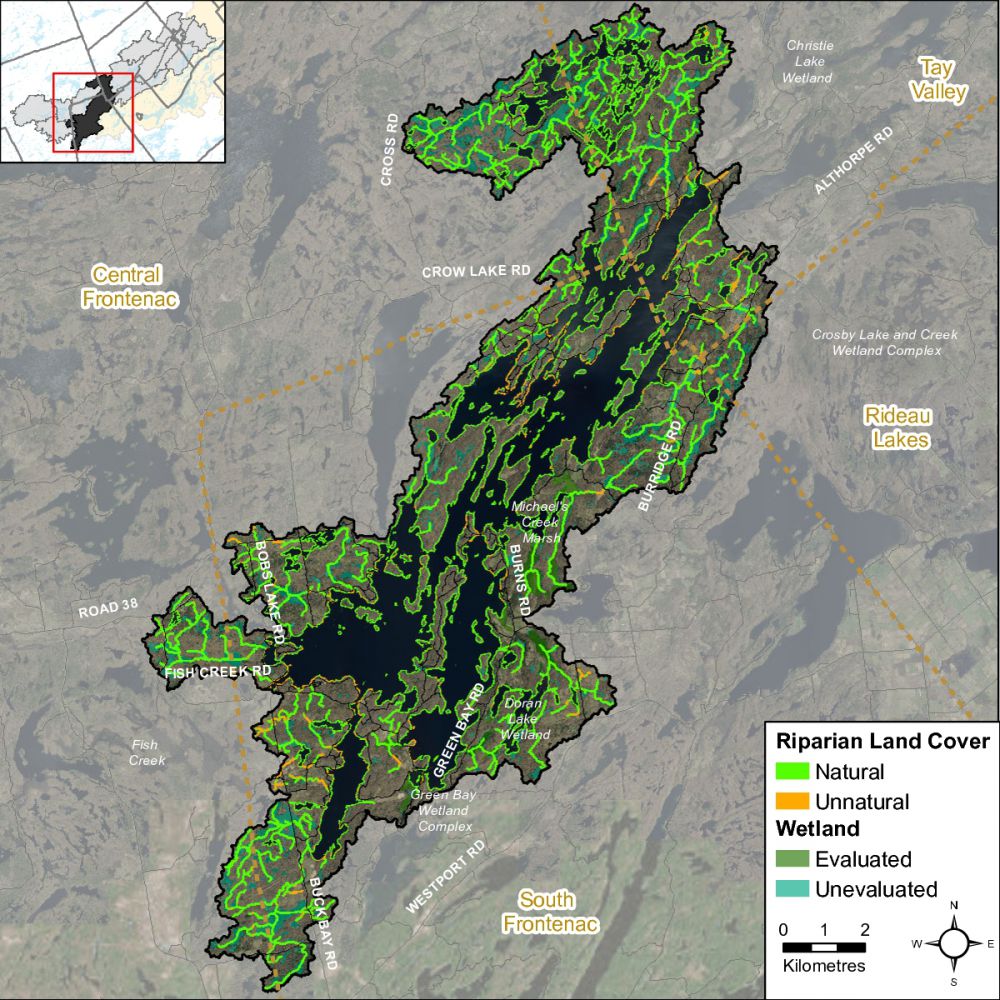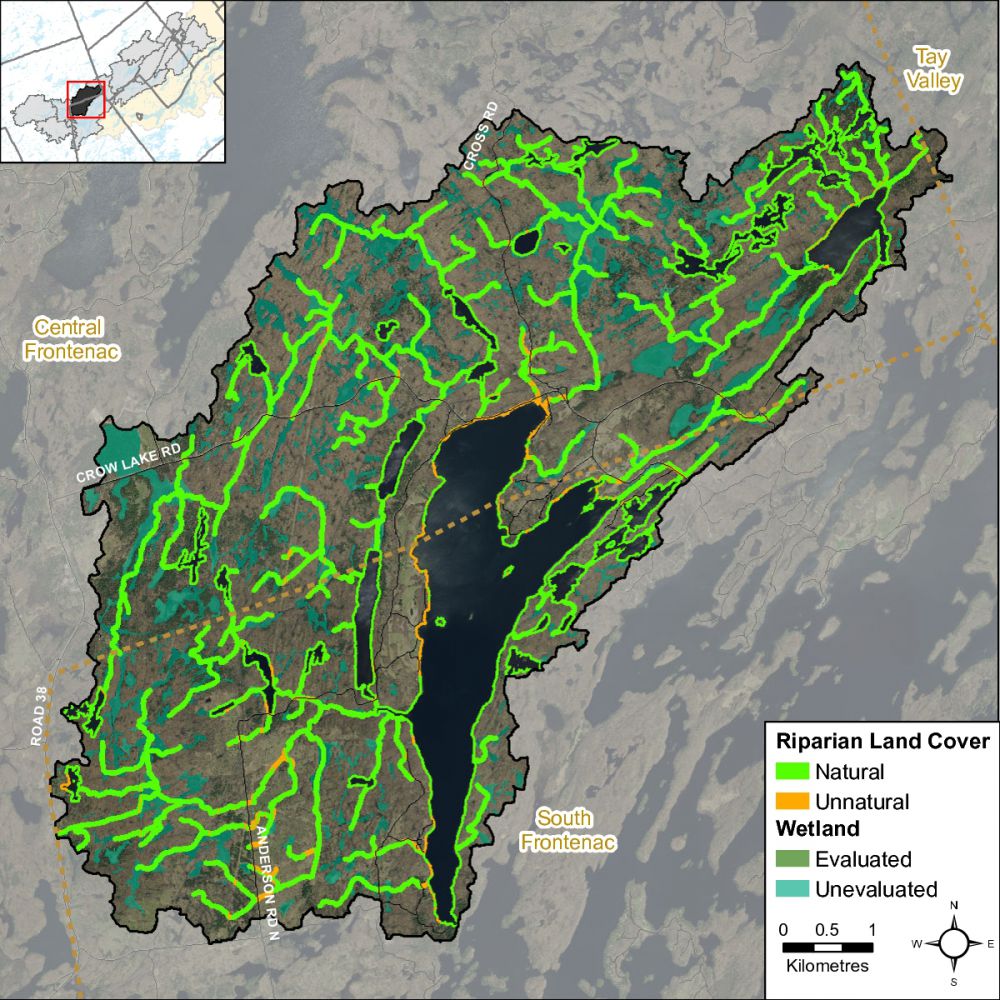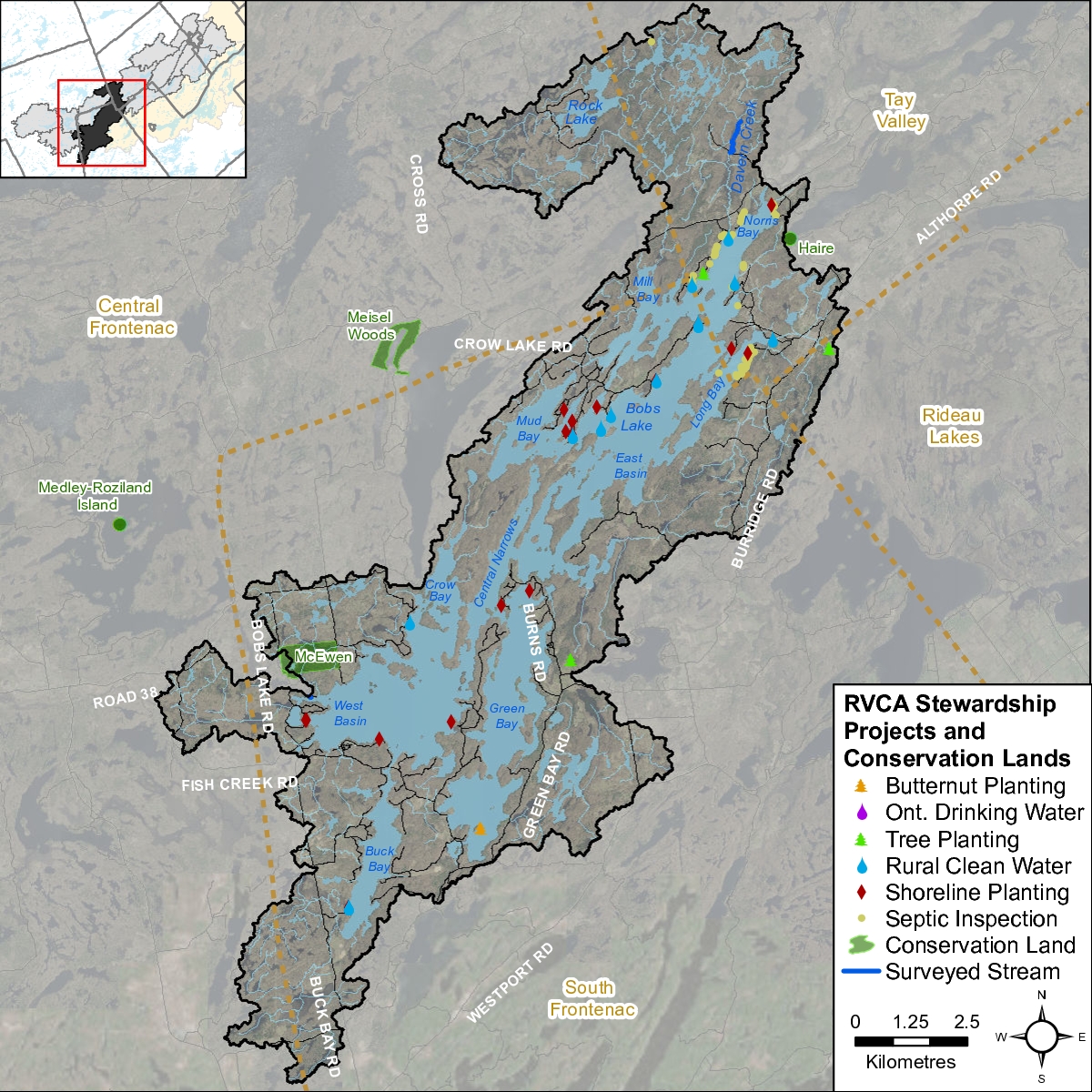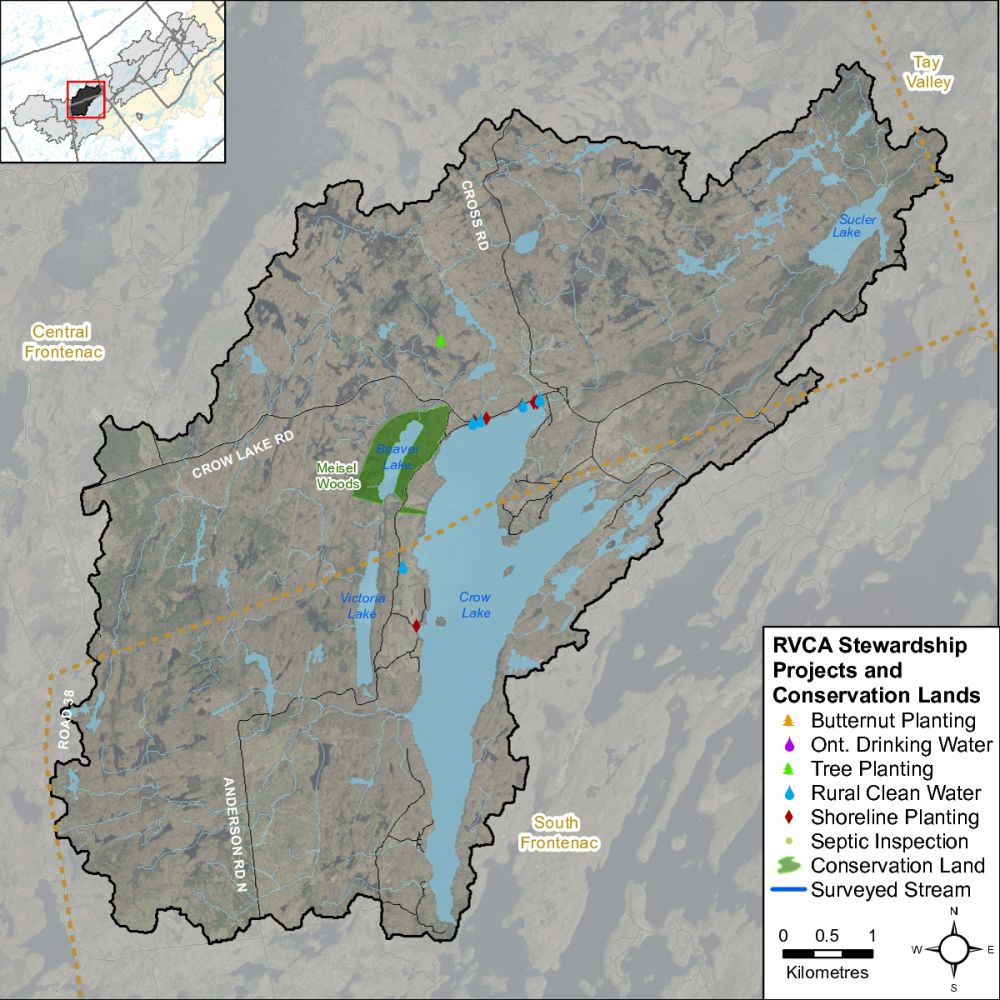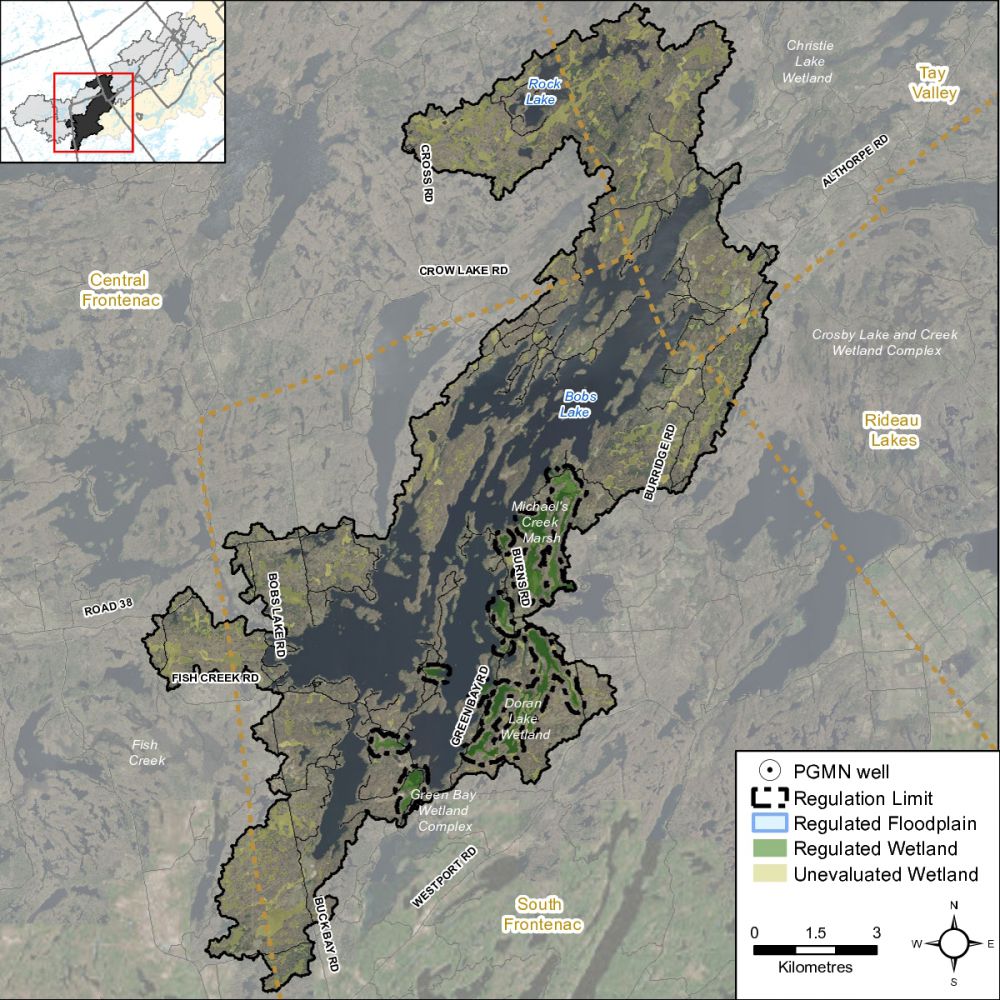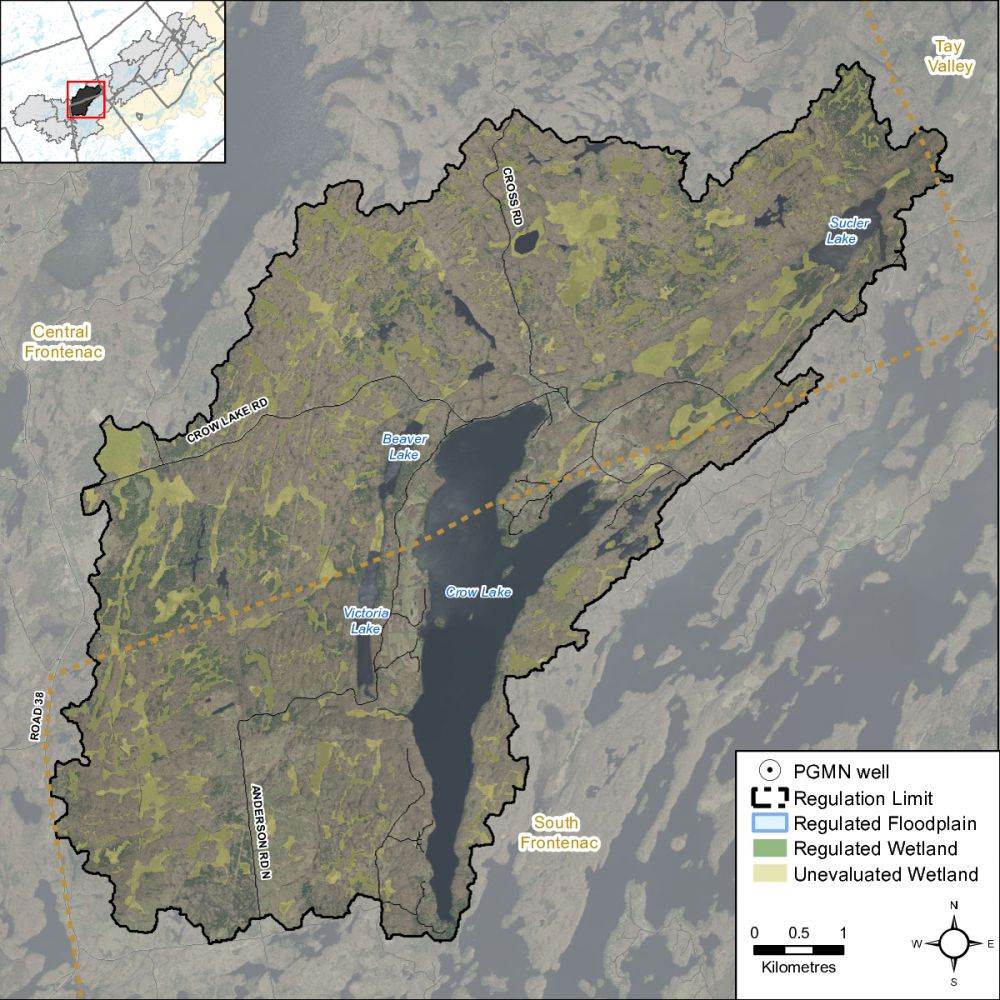2.0 Bobs and Crow Lake Catchments: Water Quality Conditions
Surface water quality conditions are monitored by the Rideau Valley Conservation Authority’s (RVCA) Watershed Watch Program, which monitors watershed lakes to assess nutrient concentrations, water clarity, dissolved oxygen availability and pH. Figure 2 shows the locations of monitoring sites in the Bobs Lake catchment and Figure 3 shows the locations of monitoring sites in the Crow Lake catchment.
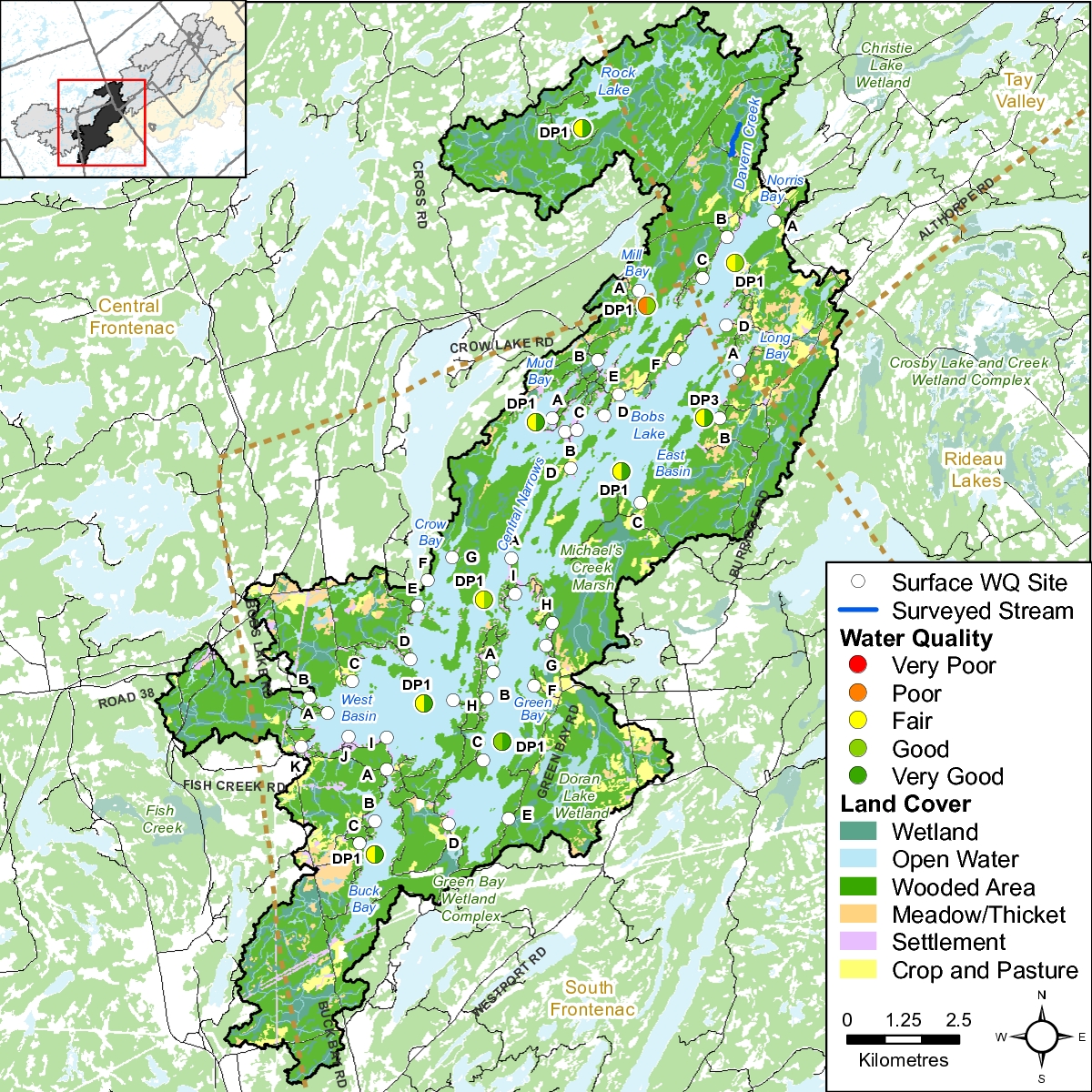
Figure 2 Water quality monitoring sites on Bobs and Rock Lakes
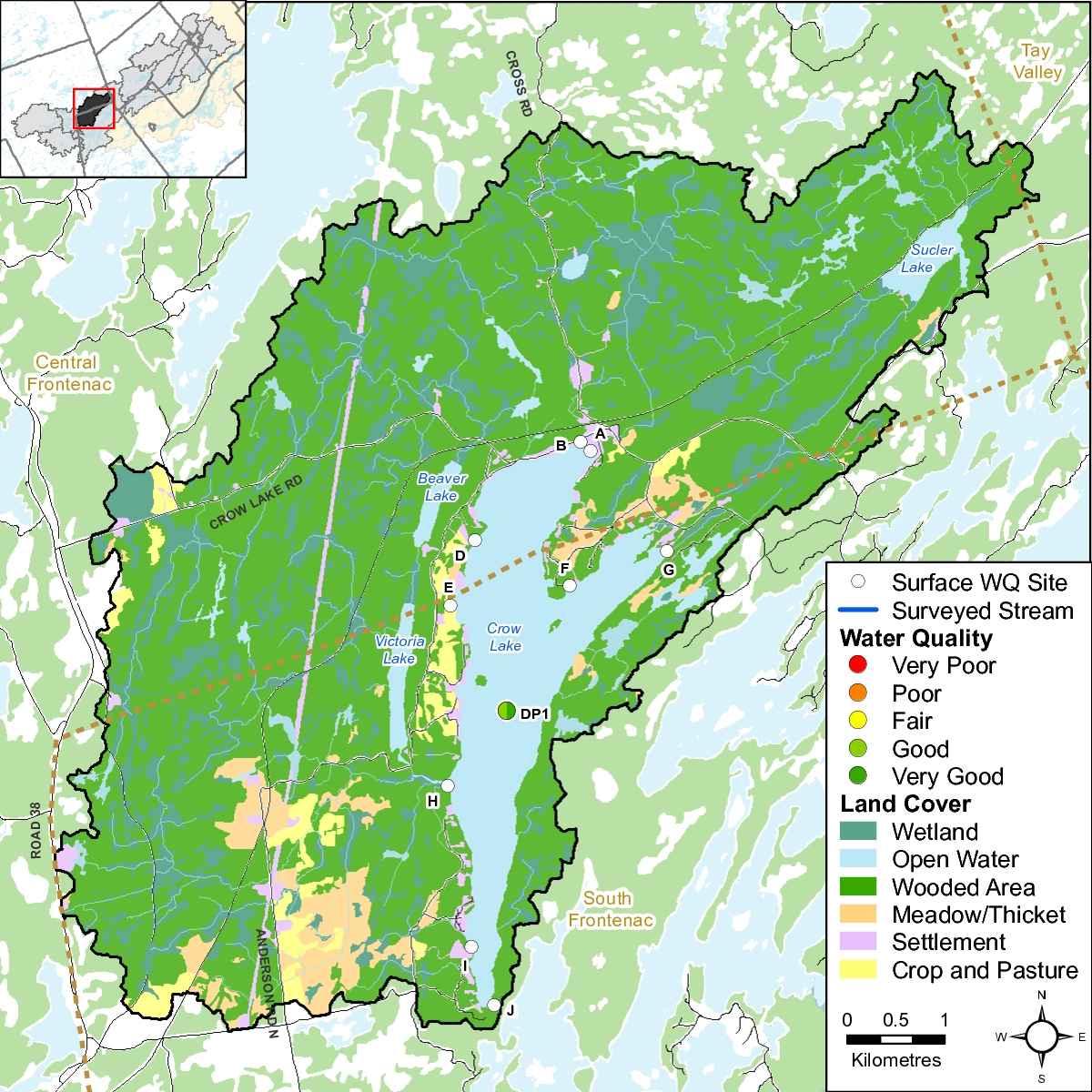
Figure 3 Water quality monitoring sites on Crow Lake
Water Quality Rating in the Bobs Lake Catchment
"Poor" indicates that water quality is frequently threatened or impaired with conditions that often depart from natural or desirable levels. A "Fair" rating indicates that water quality is usually protected but is occasionally threatened or impaired; conditions sometimes depart from natural or desirable levels. A rating of "Good" indicates that only a minor degree of threat or impairment is observed and conditions rarely depart from natural or desirable levels. ” Very Good” describes water quality as protected with virtual absence of threat or impairment; conditions are very close to natural or pristine levels. Each parameter is evaluated against established guidelines to determine water quality conditions. Those parameters that frequently exceed guidelines are presented below. Data has been analyzed over the 2006-2017 period for general trends and conditions. Table 1 shows the overall rating for the monitored surface water quality sites within the catchment and Table 2 outlines the Water Quality Index (WQI) scores and their corresponding ratings.
Table 1 Water Quality Index ratings for Bobs and Rock Lakes
Table 2 Water Quality Index ratings and corresponding index scores (RVCA terminology, original WQI category names in brackets)
2.1 Bobs Lake Water Quality
Surface water quality conditions in Bobs Lake have been monitored by RVCA’s Watershed Watch Program since 2006. Data from the deep point sites (DP1 & DP3) has been used to calculate the WQI ratings for Bobs Lake. In most basins (of which there are nine in Bobs Lake that are monitored), conditions were influenced by moderate nutrient concentrations, good oxygen availability and clear water. The following discussion explains how each of the monitored water quality parameters contributes to the water quality in each basin.
This report also considers data from additional shoreline sites that are monitored around the lake. These sites have not been included in the calculation of the CCME WQI rating, as they are not monitored with the same frequency as the deep point site. However, they do provide important information on water quality conditions in the near shore areas. For locations of shoreline sites please see Figure 2.
2.1.1 Bobs Lake: Buck Bay Water Quality
2.1.1.1 Buck Bay Nutrients
Total phosphorus (TP) is used as a primary indicator of excessive nutrient loading and contributes to abundant aquatic vegetation growth and depleted dissolved oxygen levels. The Provincial Water Quality Objective (PWQO) is used as the TP Guideline and states that in lakes, concentrations greater than 0.020 mg/l indicate an excessive amount of TP within the water column. Concentrations below 0.010 mg/l are generally considered to be minimal and unlikely to have problems associated with nutrient loading. Total Kjeldahl nitrogen (TKN) is used as a secondary indicator of nutrient loading. RVCA uses a guideline of 0.500 mg/l to assess TKN within surface waters1.
Nutrients at the Buck Bay Deep Point
TP and TKN sampling results collected by the RVCA are presented in Figures 3 to 6. Variability has occurred in the sampled TP concentrations at this site (Figure 3 and 4), however no significant trend2 was observed in the 2006-2017 dataset. Eighty-nine percent of samples analyzed for TP were less than the TP guideline and the average concentration was 0.013 mg/l (Table 3). TKN concentration also showed variability and an overall decline in concentrations was observed (Figures 5 and 6). Ninety-three percent of reported results were below the TKN guideline and the average TKN concentration was 0.362 mg/l (Table 3).
Figure 3 Total phosphorous sampling results at deep point site (DP1) on Buck Bay, 2006-2017
Figure 4 Average total phosphorus results at the deep point site (DP1) on Buck Bay, 2006-2017.
Figure 5 Total Kjeldahl nitrogen sampling results at deep point site (DP1) on Buck Bay, 2006-2017
Figure 6 Average total Kjeldahl nitrogen sampling results at the deep point site (DP1) on Buck Bay, 2006-2017.
Table 3 Summary of nutrient results for Buck Bay over the monitoring period, 2006-2017.
Overall, the data presented indicates that nutrient concentrations may be considered moderate with few instances of exceedance in the mid-lake, deep water site on Buck Bay.
Nutrients around Buck Bay
The average nutrient concentrations at monitored shoreline sites around the lake vary from year to year (Figures 7 and 8). Please note that in the 2006-2017 monitoring period only site A was sampled yearly; sites B, C and D were sampled in 2008 and 2013.
Average total phosphorous concentrations are below the TP guideline at all sites for all years monitored. The opposite is true for average TKN concentrations that exceed the guideline at all monitored sites. Site A is in a busy area near the entrance to Buck Bay from West Basin where increased boat traffic and sediment disturbance may contribute to the elevated results.
Figure 7 Average total phosphorous concentrations at shoreline monitoring sites on Buck Bay, 2006-2017.
Figure 8 Average total Kjeldahl nitrogen concentrations at shoreline monitoring sites on Buck Bay, 2006-2017
Summary of Buck Bay Nutrients
Buck Bay nutrient concentrations are generally below the guidelines, with few exceedances. It is possible that occasional problems with nutrient enrichment (i.e. algal blooms or excessive plant growth) may be observed in shallow, sheltered bays.
Efforts such as the diversion of runoff and enhanced shoreline buffers are important to continue to protect and enhance water quality and reduce future nutrient increases. This is particularly important for roadways and dwellings that boarder the lake. Nutrient exceedances may be partially attributed to the natural aging of a lake and basin characteristics. All residents can help minimize their impact on the lake by reducing nutrient inputs through practices such as proper maintenance of septic systems, keeping shorelines natural and using phosphate free soaps and detergents. Promotion of sound stewardship and protection around lake are important to maintain and protect water quality conditions into the future.
2.1.1.2 Buck Bay Water Clarity
Water clarity is measured using a Secchi disk during each deep point sample. Table 4 summarizes the recorded depths with an average depth of 4.7 m and shows that all readings have exceeded the minimum PWQO of 2 m indicating that algae in the water column is not at excessive levels (good water clarity). Less than 2 m will indicate overproduction in a lake or significant inputs to the water column that are limiting light availability. Figure 9 shows that no individual reading has been below the guideline and measured depths range from 2.1 m to 7.25 m. No trend was observed within the 2006-2017 data set, indicating that Secchi depths have not changed significantly over this period.
Table 4 Summary of Secchi depths recorded at the deep point (DP1) on Buck Bay, 2006-2017.
Figure 9 Recorded Secchi depths at the deep point site (DP1) on Buck Bay, 2006-2017.
Summary of Buck Bay Water Clarity
Waters in Buck Bay are very clear and sufficient sunlight is able to penetrate the water column to support aquatic life and provide sufficient visibility for safe recreational use (boating, swimming).
2.1.1.3 Buck Bay Fish Habitat
Two other factors, dissolved oxygen/temperature and pH were also assessed to provide an overall sense of the health of Buck Bay from a fish habitat perspective.
2.1.1.3.1 Buck Bay Dissolved Oxygen and Temperature
The red bars in Figure 10 show the depths where suitable conditions exist for warm water fish species (temperature less than 25°C and dissolved oxygen greater than 4 mg/l) at the deep point site. The vertical axis represents the total lake depth at each site where the profile is taken. Suitable conditions typically decline throughout the summer to about 11 m of the water column. Overall, no significant change was noted in conditions through the 2006-2017 period.
Figure 10. Depths suitable for warm water fish species at the deep point site (DP1) on Buck Lake, 2006-2017.
2.1.1.3.2 Buck Bay pH
pH is a basic water quality parameter used to assess the acidity of water, an important factor for aquatic life. Figure 11 shows monitored pH values over the 2006-2017 period.
Figure 11. pH concentrations at the deep point site (DP1) on Buck Bay, 2006-2017.
The majority of samples for both time periods were within guidelines established by the Canadian Council of Minister's of the Environment which state that pH should be between 6.5 and 9 to protect aquatic life (Table 5). Surface water’s that are found to be more alkaline (higher pH) are common in many regions of the Tay River subwatershed and can generally be attributed to the geology rather than anthropogenic activities. Biological activities such as increased photosynthesis from algal blooms and plant growth may also influence pH.
Table 5 Summary of pH results at the deep point site (DP1) on Buck Bay, 2006-2017
Summary of Water Quality for Fish Habitat in Buck Bay
Overall the water chemistry data at the deep point describes suitable habitat conditions for fish species such as bass, walleye and pike. There is some evidence that the warming of the water column in the late summer/fall and limited oxygen availability at deeper depths may minimize the amount of habitat for some more sensitive species. pH conditions are within the end of the range recommended for the protection of aquatic life. Overall, the data indicates a healthy environment for aquatic species.
2.1.1.4 Buck Bay E. Coli
E. coli is sampled at monitored shoreline sites twice each sampling season. E. coli data was not used in the calculations of the WQI rating for the lake due to differences in sampling frequency and site locations, the results are summarized in Table 6. Throughout the 2006-2017 period 97 percent of samples were below the E. coli guideline of 100 colony forming units (CFU) per 100 ml set by the PWQO; across the lake the count at the geometric mean3 was 6 CFU/100ml (Table 6).
Table 6 Summary of E. coli results for Buck Bay, 2006-2017
Figure 12 show the distribution of counts across all shoreline sites. Site A is the only site monitored each year and typically has minimal counts and indicates that bacterial pollution should not be a concern. All sites fell well below the guideline of 100 CFU/100ml.
Figure 12 Geometric mean of shoreline sites monitored on Buck Bay, 2006-2017
Summary of Buck Bay Bacterial Contamination
The results presented above provide evidence that bacterial contamination is not a significant concern in Buck Bay and the water should be safe for recreational use such as swimming and boating.
2.1.2 Bobs Lake: Green Bay Water Quality
2.1.2.1 Green Bay Nutrients
Total phosphorus (TP) is used as a primary indicator of excessive nutrient loading and contributes to abundant aquatic vegetation growth and depleted dissolved oxygen levels. The Provincial Water Quality Objective (PWQO) is used as the TP Guideline and states that in lakes, concentrations greater than 0.020 mg/l indicate an excessive amount of TP within the water column. Concentrations below 0.010 mg/l are generally considered to be minimal and unlikely to have problems associated with nutrient loading. Total Kjeldahl nitrogen (TKN) is used as a secondary indicator of nutrient loading. RVCA uses a guideline of 0.500 mg/l to assess TKN within surface waters.
Nutrients at the Green Bay Deep Point
TP and TKN sampling results collected by the RVCA are presented in Figures 13 to 16. Variability has occurred in the sampled TP concentrations at this site (Figure 13 and 14), however no significant trend was observed in the 2006-2017 dataset. TP results for Green Bay are consistently low, all samples analyzed for TP were less than the TP guideline and the average concentration was 0.009 mg/l (Table 7). TKN concentration also showed variability; however, similar to TP results no trend was observed (Figures 15 and 16). Ninety-five percent of reported results were below the TKN guideline and the average TKN concentration was 0.314 mg/l (Table 7).
Figure 13 Total phosphorus samples results at the deep point site (DP1) on Green Bay, 2006-2017
Figure 14 Average total phosphorus results at the deep point site (DP1) on Green Bay, 2006-2017.
Figure 15 Total Kjeldahl nitrogen sampling results at deep point site (DP1) on Green Bay, 2006-2017
Figure 16 Average total Kjeldahl nitrogen results at the deep point site (DP1) on Green Bay, 2006-2017.
Table 7 Summary of nutrient results for Green Bay over the monitoring period, 2006-2017.
Overall, the data presented indicates that nutrient concentrations may be considered very low with few instances of exceedance in the mid-lake, deep water site on Green Bay.
Nutrients around Green Bay
The average nutrient concentrations at monitored shoreline sites around the lake vary from year to year (Figures 17 and 18). Please note that in the 2006-2017 monitoring period only sites D, F, and H were sampled yearly; sites A, B, C, E, G and I were sampled in 2008 and 2013.
Average total phosphorous concentrations are below the TP guideline at all sites; site D tends to have elevated results relative to other sites though results can still be considered low to moderate (Figure 17). Average TKN concentrations were also below the guideline at all monitored sites; as with TP concentrations, TKN is also slightly elevated at site D relative to other monitored sites (Figure 18). Site D is in a shallow portion of the bay in close proximity to a roadway, it is possible that runoff from this road is contributing to elevated nutrient concentrations at this site.
Figure 17 Average total phosphorous concentrations at shoreline monitoring sites on Green Bay, 2006-2017.
Figure 18 Average total Kjeldahl nitrogen concentrations at shoreline monitoring sites on Green Bay, 2006-2017.
Summary of Green Bay Nutrients
Green Bay nutrient concentrations are generally below the guidelines, with very instances of elevated results. It is possible that occasional problems with nutrient enrichment (i.e. algal blooms or excessive plant growth) may be observed in shallow, sheltered bays or following periods of heavy runoff.
Green Bay nutrient concentrations are generally below the guidelines, with very instances of elevated results. It is possible that occasional problems with nutrient enrichment (i.e. algal blooms or excessive plant growth) may be observed in shallow, sheltered bays or following periods of heavy runoff.
Efforts such as the diversion of runoff and enhanced shoreline buffers are important to continue to protect and enhance water quality and reduce future nutrient increases. This is particularly important for roadways and dwellings that boarder the lake. Nutrient exceedances may be partially attributed to the natural aging of a lake and basin characteristics. All residents can help minimize their impact on the lake by reducing nutrient inputs through practices such as proper maintenance of septic systems, keeping shorelines natural and using phosphate free soaps and detergents. Promotion of sound stewardship and protection around lake are important to maintain and protect water quality conditions into the future.
2.1.2.2 Green Bay Water Clarity
Water clarity is measured using a Secchi disk during each deep point sample. Table 8 summarizes the recorded depths with an average depth of 5.1 m and shows that all readings have exceeded the minimum PWQO of 2m indicating that algae in the water column is not at excessive levels (good water clarity). Less than 2 m will indicate overproduction in a lake or significant inputs to the water column that are limiting light availability. Figure 19 shows that no individual reading has been below the guideline and measured depths range from 2.9 m to 7.9 m. No trend was observed within the 2006-2017 data set, indicating that Secchi depths have not change significantly over this period.
Table 8 Summary of Secchi depths recorded at the deep point (DP1) on Green Bay, 2006-2017.
Figure 19 Recorded Secchi depths at the deep point site (DP1) on Green Bay, 2006-2017.
Summary of Green Bay Water Clarity
Waters in Green Bay are very clear and sufficient sunlight is able to penetrate the water column to support aquatic life and provide sufficient visibility for safe recreational use (boating, swimming).
2.1.2.3 Green Bay Fish Habitat
Two other factors, dissolved oxygen/temperature and pH were also assessed to provide an overall sense of the health of Green Bay from a fish habitat perspective.
2.1.2.3.1 Green Bay Dissolved Oxygen and Temperature
The red bars in Figure 20 show the depths where suitable conditions exist for warm water fish species (temperature less than 25°C and dissolved oxygen greater than 4 mg/l) at the deep point site. The vertical axis represents the total lake depth at each site where the profile is taken. Suitable conditions typically decline throughout the summer to about 21 m of the water column. Overall, no significant change was noted in conditions through the 2006-2017 period.
Figure 20 Depths suitable for warm water fish species at the deep point site (DP1) on Green Bay, 2006-2017.
2.1.2.3.2 Green Bay pH
pH is a basic water quality parameter used to assess the acidity of water, an important factor for aquatic life. Figure 21 shows monitored pH values over the 2006-2017 period.
Figure 21 pH concentrations at the deep point sites (DP1) on Green Bay, 2006-2017.
The majority of samples (95%, table 9) for both time periods were within guidelines established by the Canadian Council of Minister's of the Environment which state that pH should be between 6.5 and 9 to protect aquatic life. Surface water’s that are found to be more alkaline (higher pH) are common in many regions of the Tay River subwatershed and can generally be attributed to the geology rather than anthropogenic activities. Biological activities such as increased photosynthesis from algal blooms and plant growth may also influence pH.
Table 9 Summary of pH results at the deep point site (DP1) on Green Bay 2006-2017
Summary of Water Quality for Fish Habitat in Green Bay
Overall the water chemistry data at the deep point describes suitable habitat conditions for fish species such as bass, walleye and pike. There is some evidence that the warming of the water column in the late summer/fall and limited oxygen availability at deeper depths may minimize the amount of habitat for some more sensitive species. pH conditions are within the end of the range recommended for the protection of aquatic life. Overall, the data indicates a healthy environment for aquatic species.
2.1.2.4 Green Bay E. Coli
E. coli is sampled at monitored shoreline sites twice each sampling season. E. coli data was not used in the calculations of the WQI rating for the lake due to differences in sampling frequency and site locations, the results are summarized in Table 10. Throughout the 2006-2017 period 99 percent of samples were below the E. coli guideline of 100 colony forming units (CFU) per 100 ml set by the PWQO; across the lake the count at the geometric mean was only 3 CFU/100ml (Table 10).
Table 10 Summary of E. coli results for Green Bay, 2006-2017
Figure 22 Geometric mean of shoreline sites monitored on Green Bay, 2006-2017
Figure 22 shows the distribution of counts across all shoreline sites. All sites fall well below the guideline of 100 CFU/100ml; site F does have elevated results relative to other monitored locations. However, counts have been variable from year to year and as previously noted the geometric mean in any year does not exceed the guideline, therefore these results do not indicate reason for concern. Given the proximity of agricultural lands to this site it is possible that runoff from livestock or manure application may be contributing to the occasional periods of elevated results. Improving natural shoreline cover, buffers and fencing along this shore may help reduce runoff from surrounding land uses.
Summary of Green Bay Bacterial Contamination
The results presented above provide evidence that bacterial contamination is not a significant concern in Green Bay and the water should be safe for recreational use such as swimming and boating.
2.1.3 Bobs Lake: West Basin Water Quality
2.1.3.1 West Basin Nutrients
Total phosphorus (TP) is used as a primary indicator of excessive nutrient loading and contributes to abundant aquatic vegetation growth and depleted dissolved oxygen levels. The Provincial Water Quality Objective (PWQO) is used as the TP Guideline and states that in lakes, concentrations greater than 0.020 mg/l indicate an excessive amount of TP within the water column. Concentrations below 0.010 mg/l are generally considered to be minimal and unlikely to have problems associated with nutrient loading. Total Kjeldahl nitrogen (TKN) is used as a secondary indicator of nutrient loading. RVCA uses a guideline of 0.500 mg/l to assess TKN within surface waters.
Nutrients at the West Basin Deep Point
TP and TKN sampling results collected by the RVCA are presented in Figures 23 to 26. Variability has occurred in the sampled TP concentrations at this site (Figure 23 and 24), however no significant trend was observed in the 2006-2017 dataset. TP results for West Basin may be considered minimal, 96 percent of samples analyzed for TP were less than the TP guideline and the average concentration was 0.010 mg/l (Table 11). TKN concentration also showed variability; however similar to TP results no trend was observed (Figures 25 and 26). Ninety-three percent of reported results were below the TKN guideline and the average TKN concentration was 0.360 mg/l (Table 11).
Figure 23 Total phosphorus sampling results at deep point site (DP1) in the West Basin, 2006-2017
Figure 24 Average total phosphorus results at the deep point site (DP1) in the West Basin, 2006-2017.
Figure 25 Total Kjeldahl nitrogen sampling results at deep point site (DP1) in the West Basin, 2006-2017
Figure 26 Average total Kjeldahl nitrogen results at the deep point site (DP1) in the West Basin, 2006-2017.
Table 11 Summary of nutrient results for West Basin over the monitoring period, 2006-2017.
Overall, the data presented indicates that nutrient concentrations may be considered very low with few instances of elevated samples in the mid-lake, deep water site in the West Basin.
Nutrients around West Basin
The average nutrient concentrations at monitored shoreline sites around the lake vary from year to year (Figures 27 and 28). Please note that in the 2006-2017 monitoring period only sites A and B were sampled yearly; sites C, D, E, F, G, and H were sampled in 2008 and 2013, site K was sampled in 2008, 2013, 2015 and 2017.
Average total phosphorous concentrations are below the TP guideline at the majority of sites with instances of elevated concentrations at sites B and K (Figure 27). Average TKN concentrations were also below the guideline at all monitored sites; as with TP results elevated concentrations are also observed at sites B and K (Figure 28). Both of these sites are located at inflow locations and it is possible that runoff from surrounding areas is contributing to elevated concentrations.
Figure 27 Average total phosphorous concentrations at shoreline monitoring sites on West Basin, 2006-2017.
Figure 28 Average total Kjeldahl nitrogen concentrations at shoreline monitoring sites on West Basin, 2006-2017.
Summary of West Basin Nutrients
West Basin nutrient concentrations are generally below the guidelines, with few samples having elevated results. It is possible that occasional problems with nutrient enrichment (i.e. algal blooms or excessive plant growth) may be observed in shallow, sheltered bays or following periods of heavy runoff.
Efforts such as the diversion of runoff and enhanced shoreline buffers are important to continue to protect and enhance water quality and reduce future nutrient increases. This is particularly important for roadways and dwellings that boarder the lake. Nutrient exceedances may be partially attributed to the natural aging of a lake and basin characteristics. All residents can help minimize their impact on the lake by reducing nutrient inputs through practices such as proper maintenance of septic systems, keeping shorelines natural and using phosphate free soaps and detergents. Promotion of sound stewardship and protection around lake and throughout the catchment are important to maintain and protect water quality conditions into the future.
2.1.3.2 West Basin Water Clarity
Water clarity is measured using a Secchi disk during each deep point sample. Table 12 summarizes the recorded depths with an average depth of 4.2 m and shows that all readings have exceeded the minimum PWQO of 2m indicating that algae in the water column is not at excessive levels (good water clarity). Less than 2 m will indicate overproduction in a lake or significant inputs to the water column that are limiting light availability. Figure 29 shows that no individual reading has been below the guideline and measured depths range from 2.8 m to 6 m. No trend was observed within the 2006-2017 data set, indicating that Secchi depths have not change significantly over this period.
Table 12 Summary of Secchi depths recorded at the deep point (DP1) on West Basin, 2006-2017.
Figure 29 Recorded Secchi depths at the deep point site (DP1) on West Basin, 2006-2017.
Summary of West Basin Water Clarity
Waters in West Basin are very clear and sufficient sunlight is able to penetrate the water column to support aquatic life and provide sufficient visibility for safe recreational use (boating, swimming).
2.1.3.3 West Basin Fish Habitat
Two other factors, dissolved oxygen/temperature and pH were also assessed to provide an overall sense of the health of West Basin from a fish habitat perspective.
2.1.3.3.1 West Basin Dissolved Oxygen and Temperature
The red bars in Figure 30 show the depths where suitable conditions exist for warm water fish species (temperature less than 25°C and dissolved oxygen greater than 4 mg/l) at the deep point site. The vertical axis represents the total lake depth at each site where the profile is taken. Suitable conditions typically decline throughout the late summer/fall to about 17 m of the water column. Overall, no significant change was noted in conditions through the 2006-2017 period.
Figure 30 Depths suitable for warm water fish species at the deep point site (DP1) on West Basin, 2006-2017.
2.3.3.3.2 West Basin pH
pH is a basic water quality parameter used to assess the acidity of water, an important factor for aquatic life. Figure 31 shows monitored pH values over the 2006-2017 period.
Figure 31 pH concentrations at the deep point sites (DP1) on West Basin, 2006-2017.
All samples (100%, table 13) were within guidelines established by the Canadian Council of Minister's of the Environment which state that pH should be between 6.5 and 9 to protect aquatic life. A slight decline was noted in pH values. Anthropogenic and biological activities such as increased photosynthesis from algal blooms and plant growth may act to influence pH.
Table 13 Summary of pH results at the deep point site (DP1) on West Basin, 2006-2017
Summary of Water Quality for Fish Habitat in West Basin
Overall the water chemistry data at the deep point describes suitable habitat conditions for fish species such as bass, walleye and pike. There is some evidence that the warming of the water column in the late summer/fall and limited oxygen availability at deeper depths may minimize the amount of habitat for some more sensitive species. pH conditions are within the range recommended for the protection of aquatic life. Overall, the data indicates a healthy environment for aquatic species.
2.1.3.4 West Basin E. Coli
E. coli is sampled at monitored shoreline sites twice each sampling season. E. coli data was not used in the calculations of the WQI rating for the lake due to differences in sampling frequency and site locations, the results are summarized in Table 14. Throughout the 2006-2017 period 97 percent of samples were below the E. coli guideline of 100 colony forming units (CFU) per 100 ml set by the PWQO; across the lake the count at the geometric mean was 7 CFU/100ml (Table 14).
Table 14 Summary of E. coli results for West Basin, 2006-2017
Figure 32 Geometric mean of shoreline sites monitored on West Basin, 2006-2017
Figure 32 shows the distribution of counts across all shoreline sites. All sites fell well below the guideline of 100 CFU/100ml, site B does have elevated results relative to other monitored locations. However, counts have been variable from year to year and as previously noted the geometric mean in any year does not exceed the guideline. This same site also had elevated nutrient concentrations and is the inflow from Eagle Creek, it may be beneficial to examine if possible sources of nutrient/bacterial contamination could be minimized at this site to protect existing conditions and prevent against future deterioration.
Summary of West Basin E. Coli
The results presented above provide evidence that bacterial contamination is not a significant concern in West Basin and the water should be safe for recreational use such as swimming and boating.
2.1.4 Bobs Lake: Norris Bay Water Quality
2.1.4.1 Norris Bay Nutrients
Total phosphorus (TP) is used as a primary indicator of excessive nutrient loading and contributes to abundant aquatic vegetation growth and depleted dissolved oxygen levels. The Provincial Water Quality Objective (PWQO) is used as the TP Guideline and states that in lakes, concentrations greater than 0.020 mg/l indicate an excessive amount of TP within the water column. Concentrations below 0.010 mg/l are generally considered to be minimal and unlikely to have problems associated with nutrient loading. Total Kjeldahl nitrogen (TKN) is used as a secondary indicator of nutrient loading. RVCA uses a guideline of 0.500 mg/l to assess TKN within surface waters.
Nutrients at the Norris Bay Deep Point
TP and TKN sampling results collected by the RVCA are presented in Figures 33 to 36. Variability has occurred in the sampled TP concentrations at this site (Figure 33 and 34), however no significant trend was observed in the 2006-2017 dataset. TP results for Norris Bay are very low, 95 percent of samples analyzed for TP were less than the TP guideline and the average concentration was 0.011mg/l (Table 15). TKN concentration also showed variability; however similar to TP results no trend was observed (Figures 35 and 36). Ninety-eight percent of reported results were below the TKN guideline and the average TKN concentration was 0.344 mg/l (Table 15).
Figure 33 Total phosphorus sampling results at deep point site (DP1) on Norris Bay, 2006-2017
Figure 34 Average total phosphorus results at the deep point site (DP1) on Norris Bay, 2006-2017.
Figure 35 Total Kjeldahl nitrogen sampling results at deep point site (DP1) on Norris Bay, 2006-2017
Figure 36 Average total Kjeldahl nitrogen results at the deep point site (DP1) on Norris Bay, 2006-2017.
Table 15 Summary of nutrient results for Norris Bay over the monitoring period, 2006-2017.
Overall, the data presented indicates that nutrient concentrations may be considered very low with few instances of elevated samples in the deep water site in Norris Bay.
Nutrients around Norris Bay
The average nutrient concentrations at monitored shoreline sites around the lake vary from year to year (Figures 37 and 38). Please note that in the 2006-2017 shoreline sites A, B, C and D were only sampled in 2008 and 2013.
Average total phosphorous concentrations are below the TP guideline at all sites withe the exception of site A in both monitoring years (Figure 37), this site is out the outlet of the lake and elevated concentrations may result from increased loading periods. Average TKN concentrations were below the guideline at all monitored sites in 2008; in 2013 average results exceeded the guideline at all sites except C.
Figure 37 Average total phosphorous concentrations at shoreline monitoring sites on Norris Bay, 2006-2017.
Figure 38 Average total Kjeldahl nitrogen concentrations at shoreline monitoring sites on Norris Bay, 2006-2017.
Summary of Norris Bay Nutrients
Nutrient concentrations in Norris Bay are inconsistent, and results have had variability between the two monitoring years. It is possible that occasional problems with nutrient enrichment (i.e. algal blooms or excessive plant growth) may be observed in shallow, sheltered bays or following periods of heavy runoff.
Norris Bay includes the outlet to the lake it has increased potential for nutrient loading. Efforts such as the diversion of runoff and enhanced shoreline buffers are important to continue to protect and enhance water quality and reduce future nutrient increases. It is particularly important for roadways and dwellings that boarder the lake. Nutrient exceedances may be partially attributed to the natural aging of a lake and basin characteristics. All residents can help minimize their impact on the lake by reducing nutrient inputs through practices such as proper maintenance of septic systems, keeping shorelines natural and using phosphate free soaps and detergents. Promotion of sound stewardship and protection around lake and throughout the catchment are important to maintain and protect water quality conditions into the future.
2.1.4.2 Norris Bay Water Clarity
Water clarity is measured using a Secchi disk during each deep point sample. Table 16 summarizes the recorded depths with an average depth of 4.5 m and shows that all readings have exceeded the minimum PWQO of 2m indicating that algae in the water column is not at excessive levels (good water clarity). Less than 2 m will indicate overproduction in a lake or significant inputs to the water column that are limiting light availability. Figure 39 shows that no individual reading has been below the guideline and measured depths range from 2.5 m to 7.5 m. No trend was observed within the 2006-2017 data set, indicating that Secchi depths have not change significantly over this period.
Table 16 Summary of Secchi depths recorded at the deep point (DP1) on Norris Bay, 2006-2017.
Figure 39 Recorded Secchi depths at the deep point site (DP1) on Norris Bay, 2006-2017.
Summary of Norris Bay Water Clarity
Waters in Norris Bay are very clear and sufficient sunlight is able to penetrate the water column to support aquatic life and provide sufficient visibility for safe recreational use (boating, swimming).
2.1.4.3 Norris Bay Fish Habitat
Two other factors, dissolved oxygen/temperature and pH were also assessed to provide an overall sense of the health of Norris Bay from a fish habitat perspective.
2.1.4.3.1 Norris Bay Dissolved Oxygen and Temperature
The red bars in Figure 40 show the depths where suitable conditions exist for warm water fish species (temperature less than 25°C and dissolved oxygen greater than 4 mg/l) at the deep point site. The vertical axis represents the total lake depth at each site where the profile is taken. Suitable conditions typically decline throughout the late summer to about 7.5 m of the water column, habitat conditions were very limited in 2007, 2010 and 2015. Overall, no significant change was noted in conditions through the 2006-2017 period.
Figure 40 Depths suitable for warm water fish species at the deep point site (DP1) on Norris Bay, 2006-2017.
2.1.4.3.2 Norris Bay pH
pH is a basic water quality parameter used to assess the acidity of water, an important factor for aquatic life. Figure 41 shows monitored pH values over the 2006-2017 period.
Figure 41 pH concentrations at the deep point sites (DP1) on Norris Bay, 2006-2017.
All samples (100%, table 17) were within guidelines established by the Canadian Council of Minister's of the Environment which state that pH should be between 6.5 and 9 to protect aquatic life. A slight decline was noted in pH values. Anthropogenic and biological activities such as increased photosynthesis from algal blooms and plant growth may act to influence pH.
Table 17 Summary of pH results at the deep point site (DP1) on Norris Bay, 2006-2017
Summary of Water Quality for Fish Habitat in Norris Bay
Overall the water chemistry data at the deep point describes suitable habitat conditions for fish species such as bass, walleye and pike. There is some evidence that the warming of the water column in the late summer and limited oxygen availability at deeper depths may minimize the amount of habitat for some more sensitive species. pH conditions are within the range recommended for the protection of aquatic life. Overall, the data indicates a healthy environment for aquatic species.
2.1.4.4 Norris Bay E. Coli
E. coli is sampled at monitored shoreline sites twice each sampling season. E. coli data was not used in the calculations of the WQI rating for the lake due to differences in sampling frequency and site locations, the results are summarized in Table 18. Throughout the 2006-2017 period 82 percent of samples were below the E. coli guideline of 100 colony forming units (CFU) per 100 ml set by the PWQO; across the lake the count at the geometric mean was 9 CFU/100ml (Table 18).
Table 18 Summary of E. coli results for Norris Bay, 2006-2017
Figure 42 Geometric mean of shoreline sites monitored on Norris Bay, 2006-2017
Figure 42 shows the distribution of counts across all shoreline sites. Site A and B have shown to have higher counts, which just meet or exceed the E. coli guideline, site B does have elevated results relative to other monitored locations. However, monitoring at the sites on Norris Bay has been infrequent, and given the limited number of samples it is difficult to make a conclusion on bacterial counts. Consideration should be given to increasing the frequency of monitoring at these sites, particularly A and B.
Summary of Norris Bay Bacterial Contamination
The results presented above provide evidence that bacterial contamination is not a significant concern at site C on Norris Bay and the water should be safe for recreational use such as swimming and boating. More data is required to assess bacterial concentrations at sites A, B and D.
2.1.5. Bobs Lake: East Basin/Long Bay
2.1.5.1 East Basin/Long Bay Nutrients
Total phosphorus (TP) is used as a primary indicator of excessive nutrient loading and contributes to abundant aquatic vegetation growth and depleted dissolved oxygen levels. The Provincial Water Quality Objective (PWQO) is used as the TP Guideline and states that in lakes, concentrations greater than 0.020 mg/l indicate an excessive amount of TP within the water column. Concentrations below 0.010 mg/l are generally considered to be minimal and unlikely to have problems associated with nutrient loading. Total Kjeldahl nitrogen (TKN) is used as a secondary indicator of nutrient loading. RVCA uses a guideline of 0.500 mg/l to assess TKN within surface waters.
Nutrients at the East Basin/Long Bay Deep Points
TP and TKN sampling results collected by the RVCA are presented in Figures 43 to 46. Variability has occurred in the sampled TP concentrations at this site (Figure 43 and 44), a slight decline in TP concentrations was observed in the 2006-2017 dataset. TP results for East Basin/Long Bay are very low, 94 percent of samples analyzed for TP were less than the TP guideline and the average concentration was 0.010 mg/l (Table 19). TKN concentration also showed variability; no trend was observed in TKN concentratons (Figures 45 and 46). Ninety-five percent of reported results were below the TKN guideline and the average TKN concentration was 0.345 mg/l (Table 19).
Figure 43 Total phosphorus sampling results at the deep point sites (DP1 and DP3) in East Basin and Long Bay, 2006-2017
Figure 44 Average total phosphorus results at the deep point sites (DP1 and DP3) on East Basin and Long Bay, 2006-2017.
Figure 45 Total Kjeldahl nitrogen sampling results at the deep point sites (DP1 and DP3) in East Bain and Long Bay, 2006-2017.
Figure 46 Average total Kjeldahl nitrogen results at the deep point sites (DP1 and DP3) on East Basin and Long Bay, 2006-2017.
Table 19 Summary of nutrient results for East Basin and Long Bay over the monitoring period, 2006-2017.
Overall, the data presented indicates that nutrient concentrations may be considered very low with few instances of elevated samples in the deep water site in Norris Bay.
Nutrients around East Basin/Long Bay
The average nutrient concentrations at monitored shoreline sites around the lake vary from year to year (Figures 47 and 48). Please note that in the 2006-2017 shoreline sites A, C, E and F were only sampled in 2008 and 2013, sites B and D were sampled each year.
Average total phosphorous concentrations are below the TP guideline at all sites withe the exception of site B in 2009 (Figure 47), this site is at the mouth of a small creek that flows into the lake, temporary elevated concentrations may have resulted from a period of high runoff. Average TKN concentrations were below the guideline at all monitored sites with the exception of site B also in 2009 and site D in 2014 (Figure 48). Site D is in a small bay with wetland influences, nitrogen rich soils are associated with wetlands and are likely contributing to elevated concentrations at this site.
Figure 47 Average total phosphorous concentrations at shoreline monitoring sites on East Basin/Long Bay, 2006-2017.
Figure 48 Average total Kjeldahl nitrogen concentrations at shoreline monitoring sites on East Basin/Long Bay, 2006-2017.
Summary of East Basin/Long Bay Nutrients
Nutrient concentrations in East Basin/Long Bay are generally below guidelines with few exceedances. There is evidence of periods of elevated nutrients and sites B and D, but as elevated concentrations are not observed every year it is likely that this are isolated events. It is possible that occasional problems with nutrient enrichment (i.e. algal blooms or excessive plant growth) may be observed in both these shallow, sheltered bays or following periods of heavy runoff.
Efforts such as the diversion of runoff and enhanced shoreline buffers are important to continue to protect and enhance water quality and reduce future nutrient increases. For instance the close proximity of a road way near site B increases the potential for runoff. Nutrient exceedances may be partially attributed to the natural aging of a lake and basin characteristics. All residents can help minimize their impact on the lake by reducing nutrient inputs through practices such as proper maintenance of septic systems, keeping shorelines natural and using phosphate free soaps and detergents. Promotion of sound stewardship and protection around lake and throughout the catchment are important to maintain and protect water quality conditions into the future.
2.1.5.2 East Basin/Long Bay Water Clarity
Water clarity is measured using a Secchi disk during each deep point sample. Table 20 summarizes the recorded depths with an average depth of 4.7 m and shows that all readings have exceeded the minimum PWQO of 2m indicating that algae in the water column is not at excessive levels (good water clarity). Less than 2 m will indicate overproduction in a lake or significant inputs to the water column that are limiting light availability. Figure 49 shows that no individual reading has been below the guideline and measured depths range from 2.3 m to 7.5 m. No trend was observed within the 2006-2017 data set, indicating that Secchi depths have not change significantly over this period.
Table 20 Summary of Secchi depths recorded at the deep point sites (DP1 and DP3) on East Basin/Long Bay, 2006-2017.
Figure 49 Recorded Secchi depths at the deep point sites (DP1 and DP3) on East Basin/Long Bay, 2006-2017.
Summary of East Basin/Long Bay Water Clarity
Waters in East Basin/Long Bay are very clear and sufficient sunlight is able to penetrate the water column to support aquatic life and provide sufficient visibility for safe recreational use (boating, swimming).
2.1.5.3 East Basin/Long Bay Fish Habitat
Two other factors, dissolved oxygen/temperature and pH were also assessed to provide an overall sense of the health of East Basin/Long Bay from a fish habitat perspective.
2.1.5.3.1 East Basin/Long Bay Dissolved Oxygen and Temperature
The red bars in Figure 50 show the depths where suitable conditions exist for warm water fish species (temperature less than 25°C and dissolved oxygen greater than 4 mg/l) at the deep point site. The vertical axis represents the total lake depth at each site where the profile is taken. Suitable conditions typically decline throughout the late summer to about 8 m of the water column, habitat conditions were very limited in 2009 and 2010. Through the 2006-2017 period and increasing trend was observed in dissolved oxygen concentrations.
Figure 50 Depths suitable for warm water fish species at the deep point sites (DP1 and DP3) on East Basin/Long Bay, 2006-2017.
2.1.5.3.2 East Basin/Long Bay pH
pH is a basic water quality parameter used to assess the acidity of water, an important factor for aquatic life. Figure 51 shows monitored pH values over the 2006-2017 period.
Figure 51 pH concentrations at the two deep point sites (DP1 and DP3) on East Basin/Long Bay, 2006-2017.
The majority of samples (97%, table 21) were within guidelines established by the Canadian Council of Minister's of the Environment which state that pH should be between 6.5 and 9 to protect aquatic life. A slight decline was noted in pH values. Anthropogenic and biological activities such as increased photosynthesis from algal blooms and plant growth may act to influence pH.
Table 21 Summary of pH results at the two deep point sites (DP1 and DP3) on East Basin/Long Bay, 2006-2017
Summary of Water Quality for Fish Habitat in East Basin/Long Bay
Overall the water chemistry data at the deep point describes suitable habitat conditions for fish species such as bass, walleye and pike. There is some evidence that the warming of the water column in the late summer and limited oxygen availability at deeper depths may minimize the amount of habitat for some more sensitive species. pH conditions are within the range recommended for the protection of aquatic life. Overall, the data indicates a healthy environment for aquatic species.
2.1.5.4 East Basin/Long Bay E. Coli
E. coli is sampled at monitored shoreline sites twice each sampling season. E. coli data was not used in the calculations of the WQI rating for the lake due to differences in sampling frequency and site locations, the results are summarized in Table 22. Throughout the 2006-2017 period 100 percent of samples were below the E. coli guideline of 100 colony forming units (CFU) per 100 ml set by the PWQO; across the lake the count at the geometric mean was 6 CFU/100ml (Table 22).
Table 22 Summary of E. coli results for East Basin/Long Bay, 2006-2017
Figure 52 Geometric mean of shoreline sites monitored on East Basin/Long Bay, 2006-2017
Figure 52 shows the distribution of counts across all shoreline sites. Sites B and D are monitored each year, while sites A, C, E and F were only monitored in 2008 and 2013, results at all sites were well below the guideline.
Summary of East Basin/Long Bay Bacterial Contamination
The results presented above provide evidence that bacterial contamination is not a significant concern in East Basin/Long Bay and the water should be safe for recreational use such as swimming and boating.
2.1.6 Bobs Lake: Central Narrows Water Quality
2.1.6.1 Central Narrows Nutrients
Total phosphorus (TP) is used as a primary indicator of excessive nutrient loading and contributes to abundant aquatic vegetation growth and depleted dissolved oxygen levels. The Provincial Water Quality Objective (PWQO) is used as the TP Guideline and states that in lakes, concentrations greater than 0.020 mg/l indicate an excessive amount of TP within the water column. Concentrations below 0.010 mg/l are generally considered to be minimal and unlikely to have problems associated with nutrient loading. Total Kjeldahl nitrogen (TKN) is used as a secondary indicator of nutrient loading. RVCA uses a guideline of 0.500 mg/l to assess TKN within surface waters.
Nutrients at the Central Narrows Deep Point
TP and TKN sampling results collected by the RVCA are presented in Figures 53 to 56. Variability has occurred in the sampled TP concentrations at this site (Figure 53 and 54), however there has been no significant increase or decrease in sampled concentrations. TP results for Central Narrows are low, 89 percent of samples analyzed for TP were less than the TP guideline and the average concentration was 0.011 mg/l (Table 23). TKN concentration also showed variability; as with TP concentration no trend was observed for this parameter (Figures 55 and 56). Ninety-three percent of reported results were below the TKN guideline and the average TKN concentration was 0.352 mg/l (Table 23).
Figure 53 Total phosphorus sampling results at the deep point site (DP1) in Central Narrows, 2006-2017
Figure 54 Average total phosphorus results at the deep point site (DP1) in Central Narrows
Figure 55 Total Kjeldahl nitrogen sampling results at the deep point site (DP1) in Central Narrows, 2006-2017.
Figure 56 Average total Kjeldahl nitrogen results at the deep point site (DP1) on Central Narrows, 2006-2017.
Table 23 Summary of nutrient results for Central Narrows over the monitoring period, 2006-2017.
Overall, the data presented indicates that nutrient concentrations may be considered very low with few instances of elevated samples in the deep water site in Central Narrows.
Nutrients around Central Narrows
The average nutrient concentrations at the monitored shoreline sites around the lake vary from year to year (Figures 57 and 58). Please note that there is only one site, A, monitored in this basin. Sampling is completed every fifth year, therefore data is only available from 2008 and 2013 within the 2006-2017 period.
Average total phosphorous concentrations were below the TP guideline in both monitoring years (Figure 57). The TP concentrations was higher in 2013 compared to 2008, however given the limited data it is not possible to say if if this is indicative of a significant change. Average TKN concentrations were below the guideline in both sampling years and concentrations were fairly comparable (Figure 58). Given that deep point nutrient concentrations have not shown any significant changes and samples at site A have been below guidelines, nutrient enrichment does not appear to be a concern in the nearshore area of Central Narrows.
Figure 57 Average total phosphorous concentrations at the shoreline monitoring site in Central Narrows, 2006-2017.
Figure 58 Average total Kjeldahl nitrogen concentrations at the shoreline monitoring sites in Central Narrows, 2006-2017.
Summary of Central Narrows Nutrients
Nutrient concentrations in Central Narrows are generally below guidelines with few exceedances. There have been some instances of elevated nutrients at the deep point, but are inconsistent and do not point to a trend of increasing nutrient concentrations. It is possible that occasional problems with nutrient enrichment (i.e. algal blooms or excessive plant growth) may be observed in shallow, sheltered bays or following periods of heavy runoff.
Efforts such as the diversion of runoff and enhanced shoreline buffers are important to continue to protect and enhance water quality and reduce future nutrient increases. Nutrient exceedances may be partially attributed to the natural aging of a lake and basin characteristics. All residents can help minimize their impact on the lake by reducing nutrient inputs through practices such as proper maintenance of septic systems, keeping shorelines natural and using phosphate free soaps and detergents. Promotion of sound stewardship and protection around lake and throughout the catchment are important to maintain and protect water quality conditions into the future.
2.1.6.2 Central Narrows Water Clarity
Water clarity is measured using a Secchi disk during each deep point sample. Table 24 summarizes the recorded depths with an average depth of 4.3 m and shows that all readings have exceeded the minimum PWQO of 2m indicating that algae in the water column is not at excessive levels (good water clarity). Less than 2 m will indicate overproduction in a lake or significant inputs to the water column that are limiting light availability. Figure 59 shows that no individual reading has been below the guideline and measured depths range from 2.8 m to 6 m. No trend was observed within the 2006-2017 data set, indicating that Secchi depths have not change significantly over this period.
Table 24 Summary of Secchi depths recorded at the deep point site (DP1) in Central Narrows, 2006-2017.
Figure 59 Recorded Secchi depths at the deep point site (DP1) on Central Narrows, 2006-2017.
Summary of Central Narrows Water Clarity
Waters in Central Narrows are very clear and sufficient sunlight is able to penetrate the water column to support aquatic life and provide sufficient visibility for safe recreational use (boating, swimming).
2.1.6.3 Central Narrows Fish Habitat
Two other factors, dissolved oxygen/temperature and pH were also assessed to provide an overall sense of the health of Central Narrows from a fish habitat perspective.
2.1.6.3.1 Central Narrows Dissolved Oxygen and Temperature
The red bars in Figure 60 show the depths where suitable conditions exist for warm water fish species (temperature less than 25°C and dissolved oxygen greater than 4 mg/l) at the deep point site. The vertical axis represents the total lake depth at each site where the profile is taken. Suitable conditions typically decline throughout the late summer/fall to approximately 10m of the water column, habitat conditions were very limited in 2009. Through the 2006-2017 period there was no significant change in habitat conditions (dissolved oxygen/temperature).
Figure 60 Depths suitable for warm water fish species at the deep point site (DP1) on Central Narrows, 2006-2017.
2.1.6.3.2 Central Narrows pH
pH is a basic water quality parameter used to assess the acidity of water, an important factor for aquatic life. Figure 61 shows monitored pH values over the 2006-2017 period.
Figure 61 pH concentrations at the two deep point site (DP1) in Central Narrows, 2006-2017.
The majority of samples (97%, Table 25) were within guidelines established by the Canadian Council of Minister's of the Environment which state that pH should be between 6.5 and 9 to protect aquatic life. A slight decline was noted in pH values. Anthropogenic and biological activities such as increased photosynthesis from algal blooms and plant growth may act to influence pH.
Table 25 Summary of pH results at the two deep point site (DP1) in Central Narrows, 2006-2017
Summary of Water Quality in Central Narrows for Fish habitat
Overall the water chemistry data at the deep point describes suitable habitat conditions for fish species such as bass, walleye and pike. There is some evidence that the warming of the water column in the late summer and limited oxygen availability at deeper depths may minimize the amount of habitat for some more sensitive species. pH conditions are within the range recommended for the protection of aquatic life. Overall, the data indicates a healthy environment for aquatic species.
2.1.6.4 Central Narrows E. Coli
E. coli is sampled at monitored shoreline sites twice each sampling season. E. coli data was not used in the calculations of the WQI rating for the lake due to differences in sampling frequency and site locations, the results are summarized in Table 26. As previously noted the site A is the only shoreline site monitored in this basin and is limited to results from 2008 and 2013. The results indicate that 100 percent of samples were below the E. coli guideline of 100 colony forming units (CFU) per 100 ml set by the PWQO; across the lake the count at the geometric mean was 2.5 CFU/100ml (Table 26).
Table 26 Summary of E. coli results for Central Narrows, 2006-2017
Figure 62 Geometric mean of shoreline sites monitored in Central Narrows, 2006-2017
Figure 62 shows the distribution of counts across all shoreline sites. Please note that results are based on a minimal number of samples (Table 26), all results were well below the guideline.
Summary of Central Narrows Bacterial Contamination
The results presented above provide evidence that bacterial contamination is not a significant concern in Central Narrows and the water should be safe for recreational use such as swimming and boating.
2.1.7 Bobs Lake: Mill Bay Water Quality
2.1.7.1 Mill Bay Nutrients
Total phosphorus (TP) is used as a primary indicator of excessive nutrient loading and contributes to abundant aquatic vegetation growth and depleted dissolved oxygen levels. The Provincial Water Quality Objective (PWQO) is used as the TP Guideline and states that in lakes, concentrations greater than 0.020 mg/l indicate an excessive amount of TP within the water column. Concentrations below 0.010 mg/l are generally considered to be minimal and unlikely to have problems associated with nutrient loading. Total Kjeldahl nitrogen (TKN) is used as a secondary indicator of nutrient loading. RVCA uses a guideline of 0.500 mg/l to assess TKN within surface waters.
Nutrients at the Mill Bay Deep Points
TP and TKN sampling results collected by the RVCA are presented in Figures 63 to 66. Variability has occurred in the sampled TP concentrations at this site with particularly high average concentrations were observed in 2006 and 2016, it appears that in both these years elevated results were due to a single sample that is uncharacteristically high (Figure 63 and 64). Overall, there has been no significant increase or decrease in sampled concentrations. TP results for Mill Bay are typically low, 85 percent of samples analyzed for TP were less than the TP guideline and the average concentration was 0.016 mg/l (Table 27). TKN concentration also showed variability; as with TP concentration no trend was observed for this parameter (Figures 65 and 66). Seventy-four percent of reported results were below the TKN guideline and the average TKN concentration was 0.439 mg/l (Table 27).
Figure 63 Total phosphorus sampling results at the deep point site (DP1) in Mill Bay, 2006-2017.
Figure 64 Average total phosphorus results at the deep point site (DP1) in Mill Bay, 2006-2017.
Figure 65 Total Kjeldahl nitrogen sampling results at the deep point site (DP1) in Mill Bay, 2006-2017.
Figure 66 Average total Kjeldahl nitrogen results at the deep point site (DP1) in Mill Bay, 2006-2017.
Table 27 Summary of nutrient results for Mill Bay over the monitoring period, 2006-2017.
Overall, the data presented indicates that nutrient concentrations may be considered low with occasional reports of elevated samples at the deep water site on Mill Bay.
Nutrients around Mill Bay
The average nutrient concentrations at the monitored shoreline sites around the lake vary from year to year (Figures 67 and 68). Please note that there are only two sites monitored in this basin, A and B. Yearly sampling is completed at site B and every fifth year at site A; therefore data is only available from 2008 and 2013 for site A within the 2006-2017 period.
Average total phosphorous concentrations are inconsistent at site B, and exceeded the guideline in 2012 and 2013, concentrations have been lower in subsequent years (Figure 67). All results at site A have been below the guideline. Average TKN concentrations typically exceed the guideline (Figure 68). This may be the result of inflow from wetlands, re-suspension of nutrients in the shallow bay and runoff from developed shorelines.
Figure 67 Average total phosphorous concentrations at the shoreline monitoring site in Mill Bay, 2006-2017.
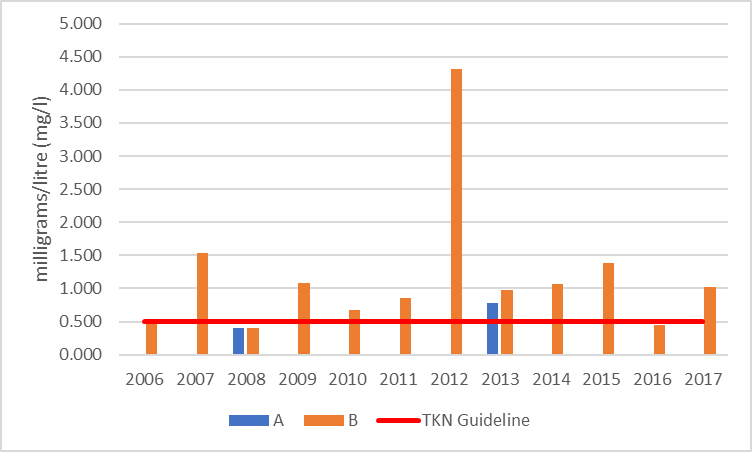
Figure 68 Average total Kjeldahl nitrogen concentrations at the shoreline monitoring sites in Mill Bay, 2006-2017.
Summary of Mill Bay Nutrients
Nutrient concentrations in Mill Bay are generally below guidelines with elevated concentrations being more common at monitored shoreline sites. It is possible that occasional problems with nutrient enrichment (i.e. algal blooms or excessive plant growth) may be observed in shallow, sheltered bays or following periods of heavy runoff.
Efforts such as the diversion of runoff and enhanced shoreline buffers are important to continue to protect and enhance water quality and reduce future nutrient increases. Nutrient exceedances may be partially attributed to the natural aging of a lake and basin characteristics. All residents can help minimize their impact on the lake by reducing nutrient inputs through practices such as proper maintenance of septic systems, keeping shorelines natural and using phosphate free soaps and detergents. Promotion of sound stewardship and protection around lake and throughout the catchment are important to maintain and protect water quality conditions into the future.
2.1.7.2 Mill Bay Water Clarity
Water clarity is measured using a Secchi disk during each deep point sample. Table 28 summarizes the recorded depths with an average depth of 3.3 m and shows that all readings have exceeded the minimum PWQO of 2m indicating that algae in the water column is not at excessive levels (good water clarity). Less than 2 m will indicate overproduction in a lake or significant inputs to the water column that are limiting light availability. Figure 69 shows that no individual reading has been below the guideline and measured depths range from 2.3 m to 5 m. No trend was observed within the 2006-2017 data set, indicating that Secchi depths have not change significantly over this period.
Table 28 Summary of Secchi depths recorded at the deep point site (DP1) on Mill Bay, 2006-2017.
Figure 69 Recorded Secchi depths at the deep point site (DP1) on Mill Bay, 2006-2017.
Summary of Mill Bay Water Clarity
Waters in Mill Bay are very clear and sufficient sunlight is able to penetrate the water column to support aquatic life and provide sufficient visibility for safe recreational use (boating, swimming).
2.1.7.3 Mill Bay Fish Habitat
Two other factors, dissolved oxygen/temperature and pH were also assessed to provide an overall sense of the health of Mill Bay from a fish habitat perspective.
2.1.7.3.1 Mill Bay Dissolved Oxygen and Temperature
The red bars in Figure 70 show the depths where suitable conditions exist for warm water fish species (temperature less than 25°C and dissolved oxygen greater than 4 mg/l) at the deep point site. The vertical axis represents the total lake depth at each site where the profile is taken. Suitable conditions typically exist to about 3m within the water column. Through the 2006-2017 period there was no significant change in habitat conditions (dissolved oxygen/temperature).
Figure 70 Depths suitable for warm water fish species at the deep point site (DP1) on Mill Bay, 2006-2017.
2.1.7.3.2 Mill Bay pH
pH is a basic water quality parameter used to assess the acidity of water, an important factor for aquatic life. Figure 71 shows monitored pH values over the 2006-2017 period.
Figure 71 pH concentrations at the deep point site (DP1) in Mill Bay, 2006-2017.
The majority of samples (97%, table 29) were within guidelines established by the Canadian Council of Minister's of the Environment which state that pH should be between 6.5 and 9 to protect aquatic life. No significant change was observed in pH results over the 2006-2017 period.
Table 29 Summary of pH results at the deep point site (DP1) in Mill Bay, 2006-2017
Summary of Water Quality for Fish Habitat in Mill Bay
Overall the water chemistry data at the deep point describes suitable habitat conditions for fish species such as bass, walleye and pike. There is some evidence that the warming of the water column in the late summer and limited oxygen availability at deeper depths may minimize the amount of habitat for some more sensitive species. pH conditions are within the range recommended for the protection of aquatic life. Overall, the data indicates a healthy environment for aquatic species.
2.1.7.4 Mill Bay E. Coli
E. coli is sampled at monitored shoreline sites twice each sampling season. E. coli data was not used in the calculations of the WQI rating for the lake due to differences in sampling frequency and site locations, the results are summarized in Table 30. The results indicate that 100 percent of samples were below the E. coli guideline of 100 colony forming units (CFU) per 100 ml set by the PWQO; across the lake the count at the geometric mean was 3.6 CFU/100ml (Table 30)
Table 30 Summary of E. coli results for Mill Bay, 2006-2017
Figure 72 Geometric mean of shoreline sites monitored in Mill Bay, 2006-2017
Figure 72 shows the distribution of counts across all shoreline sites. Please note that results are based on a minimal number of samples (Table 30), all results were well below the guideline.
Summary of Mill Bay Bacterial Contamination
The results presented above provide evidence that bacterial contamination is not a significant concern in Mill Bay and the water should be safe for recreational use such as swimming and boating.
2.1.8 Bobs Lake: Mud Bay Water Quality
2.1.8.1 Mud Bay Nutrients
Total phosphorus (TP) is used as a primary indicator of excessive nutrient loading and contributes to abundant aquatic vegetation growth and depleted dissolved oxygen levels. The Provincial Water Quality Objective (PWQO) is used as the TP Guideline and states that in lakes, concentrations greater than 0.020 mg/l indicate an excessive amount of TP within the water column. Concentrations below 0.010 mg/l are generally considered to be minimal and unlikely to have problems associated with nutrient loading. Total Kjeldahl nitrogen (TKN) is used as a secondary indicator of nutrient loading. RVCA uses a guideline of 0.500 mg/l to assess TKN within surface waters.
Nutrients at the Mud Bay Deep Point
TP and TKN sampling results collected by the RVCA are presented in Figures 73 to 76. Variability has occurred in the sampled TP concentrations at this site with particularly high samples observed in 2010, 2011 and 2013. Though these results provide an example of occasional exceedances, yearly average concentrations are below guidelines and there has been no significant trend detected (Figure 73 and 74). Overall, TP results for Mud Bay are typically low, 88 percent of samples analyzed for TP were less than the TP guideline and the average concentration was 0.013 mg/l (Table 31). TKN concentration also showed variability; as with TP concentration no trend was observed for this parameter (Figures 75 and 76). Ninety-five percent of reported results were below the TKN guideline and the average TKN concentration was 0.355 mg/l (Table 31).
Figure 73 Total phosphorus sampling results at the deep point site (DP1) in Mud Bay, 2006-2017.
Figure 74 Average total phosphorus results at the deep point site (DP1) in Mud Bay, 2006-2017.
Figure 75 Total Kjeldahl nitrogen sampling results at the deep point site (DP1) in Mud Bay, 2006-2017.
Figure 76 Average total Kjeldahl nitrogen results at the deep point site (DP1) in Mud Bay, 2006-2017.
Table 31 Summary of nutrient results for Mud Bay over the monitoring period, 2006-2017.
Overall, the data presented indicates that nutrient concentrations may be considered low with occasional reports of elevated samples at the deep water site on Mud Bay.
Nutrients around Mud Bay
The average nutrient concentrations at most monitored shoreline sites around the lake vary from year to year (Figures 77 and 78). Please note that site B is the only shoreline site monitored yearly in Mud Bay. Sites A, C and D are monitored every fifth year; therefore data is only available from 2008 and 2013 for site within the 2006-2017 period. The exception to this is site A which was monitored in 2006.
Average total phosphorous concentrations are inconsistent at site B and are typically greater than TP concentrations at other sites, though have not exceeded the guideline (Figure 77). Average TKN concentrations reflect a similar pattern to TP concentrations and all average concentrations are below the guideline (Figure 78).
Figure 77 Average total phosphorous concentrations at the shoreline monitoring site in Mud Bay, 2006-2017.
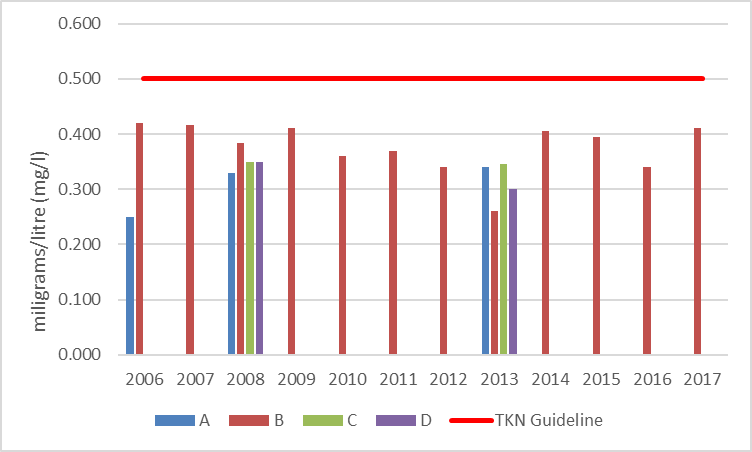
Figure 78 Average total Kjeldahl nitrogen concentrations at the shoreline monitoring sites in Mud Bay, 2006-2017.
Summary of Mud Bay Nutrients
Nutrient concentrations in Mud Bay are generally below guidelines with elevated concentrations being more common at monitored shoreline sites. It is possible that occasional problems with nutrient enrichment (i.e. algal blooms or excessive plant growth) may be observed in shallow, sheltered bays or following periods of heavy runoff.
Efforts such as the diversion of runoff and enhanced shoreline buffers are important to continue to protect and enhance water quality and reduce future nutrient increases. Nutrient exceedances may be partially attributed to the natural aging of a lake and basin characteristics. All residents can help minimize their impact on the lake by reducing nutrient inputs through practices such as proper maintenance of septic systems, keeping shorelines natural and using phosphate free soaps and detergents. Promotion of sound stewardship and protection around lake and throughout the catchment are important to maintain and protect water quality conditions into the future.
2.1.8.2 Mud Bay Water Clarity
Water clarity is measured using a Secchi disk during each deep point sample. Table 32 summarizes the recorded depths with an average depth of 4.7 m and shows that all readings have exceeded the minimum PWQO of 2m indicating that algae in the water column is not at excessive levels (good water clarity). Less than 2 m will indicate overproduction in a lake or significant inputs to the water column that are limiting light availability. Figure 79 shows that no individual reading has been below the guideline and measured depths have been variable ranging from 2.6 m to 8 m. Overall, no trend was observed within the 2006-2017 data set, indicating that Secchi depths have not change significantly over this period.
Table 32 Summary of Secchi depths recorded at the deep point site (DP1) on Mud Bay, 2006-2017.
Figure 79 Recorded Secchi depths at the deep point site (DP1) on Mud Bay, 2006-2017.
Summary of Mud Bay Nutrients
Waters in Mud Bay are very clear and sufficient sunlight is able to penetrate the water column to support aquatic life and provide sufficient visibility for safe recreational use (boating, swimming).
2.1.8.3 Mud Bay Fish Habitat
Two other factors, dissolved oxygen/temperature and pH were also assessed to provide an overall sense of the health of Mud Bay from a fish habitat perspective.
2.1.8.3.1 Mud Bay Dissolved Oxygen and Temperature
The red bars in Figure 80 show the depths where suitable conditions exist for warm water fish species (temperature less than 25°C and dissolved oxygen greater than 4 mg/l) at the deep point site. The vertical axis represents the total lake depth at each site where the profile is taken. Suitable conditions typically exist to about 6m within the water column. In 2007, 2010 and 2011 measurements in the late summer showed very limited conditions. Overall, through the 2006-2017 period there was no significant change in habitat conditions (dissolved oxygen/temperature).
Figure 80 Depths suitable for warm water fish species at the deep point site (DP1) on Mud Bay, 2006-2017.
2.1.8.3.2 Mud Bay pH
pH is a basic water quality parameter used to assess the acidity of water, an important factor for aquatic life. Figure 81 shows monitored pH values over the 2006-2017 period.
Figure 81. pH concentrations at the deep point site (DP1) in Mud Bay, 2006-2017.
All samples (Table 33) were within guidelines established by the Canadian Council of Minister's of the Environment which state that pH should be between 6.5 and 9 to protect aquatic life. No significant change was observed in pH results over the 2006-2017 period.
Table 33 Summary of pH results at the deep point site (DP1) in Mud Bay, 2006-2017
Summary of Water Quality in Mud Bay for Fish Habitat
Overall the water chemistry data at the deep point describes suitable habitat conditions for warm water fish. There is some evidence that the warming of the water column in the late summer that may minimize the amount of habitat for some more sensitive species. pH conditions are within the range recommended for the protection of aquatic life. Overall, the data indicates a healthy environment for aquatic species.
2.1.8.4 Mud Bay E. Coli
E. coli is sampled at monitored shoreline sites twice each sampling season. E. coli data was not used in the calculations of the WQI rating for the lake due to differences in sampling frequency and site locations, the results are summarized in Table 34. The results indicate that 100 percent of samples were below the E. coli guideline of 100 colony forming units (CFU) per 100 ml set by the PWQO; across the lake the count at the geometric mean was 3.0 CFU/100ml (Table 34)
Table 34 Summary of E. coli results for Mud Bay, 2006-2017
Figure 82 Geometric mean of shoreline sites monitored in Mud Bay, 2006-2017
Figure 82 shows the distribution of counts across all shoreline sites. Please note that results are based on a minimal number of samples (Table 34), all results were well below the guideline.
Summary of Mud Bay Bacterial Contamination
The results presented above provide evidence that bacterial contamination is not a significant concern in Mud Bay and the water should be safe for recreational use such as swimming and boating.
2.2 Rock Lake Water Quality
2.2.1 Rock Lake Nutrients
Total phosphorus (TP) is used as a primary indicator of excessive nutrient loading and contributes to abundant aquatic vegetation growth and depleted dissolved oxygen levels. The Provincial Water Quality Objective (PWQO) is used as the TP Guideline and states that in lakes, concentrations greater than 0.020 mg/l indicate an excessive amount of TP within the water column. Concentrations below 0.010 mg/l are generally considered to be minimal and unlikely to have problems associated with nutrient loading. Total Kjeldahl nitrogen (TKN) is used as a secondary indicator of nutrient loading. RVCA uses a guideline of 0.500 mg/l to assess TKN within surface waters.
Nutrients at the Rock Lake Deep Points
TP and TKN sampling results collected by the RVCA are presented in Figures 83 to 86. Concentrations have shown some variability from year to year, but overall the sample mean has been well below the guideline, there has been no significant trend in TP based on sampling results (Figure 83 and 84). Overall, TP results for Mud Bay are very low, 95 percent of samples analyzed for TP were less than the TP guideline and the average concentration was 0.009 mg/l (Table 35). TKN results showed a declining trend in concentrations (Figures 85 and 86). Ninety-eight percent of reported results were below the TKN guideline and the average TKN concentration was 0.343 mg/l (Table 35).
Figure 83 Total phosphorus sampling results at the deep point site (DP1) in Rock Lake, 2006-2017.
Figure 84 Average total phosphorus results at the deep point site (DP1) in Rock Lake 2006-2017.
Figure 85 Total Kjeldahl nitrogen sampling results at the deep point site (DP1) in Rock Lake, 2006-2017.
Figure 86 Average total Kjeldahl nitrogen results at the deep point site (DP1) in Rock Lake 2006-2017.
Table 35 Summary of nutrient results for Rock Lake over the monitoring period, 2006-2017.
Overall, the data presented indicates that nutrient concentrations may be considered minimal with very few instances of elevated samples at the deep water site on Rock Lake.
Summary of Rock Lake Nutrients
Nutrient concentrations in Rock Lake are below guidelines with elevated concentrations being very rare. It is possible that occasional problems with nutrient enrichment (i.e. algal blooms or excessive plant growth) may be observed in shallow, sheltered bays or following periods of heavy runoff.
Efforts such as the diversion of runoff and enhanced shoreline buffers are important to continue to protect and enhance water quality and reduce future nutrient increases. Nutrient exceedances may be partially attributed to the natural aging of a lake and basin characteristics. All residents can help minimize their impact on the lake by reducing nutrient inputs through practices such as proper maintenance of septic systems, keeping shorelines natural and using phosphate free soaps and detergents. Promotion of sound stewardship and protection around lake and throughout the catchment are important to maintain and protect water quality conditions into the future.
2.2.2 Rock Lake Water Clarity
Water clarity is measured using a Secchi disk during each deep point sample. Table 36 summarizes the recorded depths with an average depth of 4.1 m and shows that all readings have exceeded the minimum PWQO of 2m indicating that algae in the water column is not at excessive levels (good water clarity). Less than 2 m will indicate overproduction in a lake or significant inputs to the water column that are limiting light availability. Figure 87 shows that no individual reading has been below the guideline and measured depths have been variable ranging from 2.5 m to 6.5 m. Overall, no trend was observed within the 2006-2017 data set, indicating that Secchi depths have not change significantly over this period.
Table 36 Summary of Secchi depths recorded at the deep point site (DP1) on Rock Lake, 2006-2017.
Figure 87 Recorded Secchi depths at the deep point site (DP1) on Rock Lake, 2006-2017.
Summary of Rock Lake Water Clarity
Waters in Rock Lake are very clear and sufficient sunlight is able to penetrate the water column to support aquatic life and provide sufficient visibility for safe recreational use (boating, swimming).
2.2.3 Rock Lake Fish Habitat
Two other factors, dissolved oxygen/temperature and pH were also assessed to provide an overall sense of the health of Rock Lake from a fish habitat perspective.
2.2.3.1 Rock Lake Dissolved Oxygen and Temperature
The red bars in Figure 88 show the depths where suitable conditions exist for warm water fish species (temperature less than 25°C and dissolved oxygen greater than 4 mg/l) at the deep point site. The vertical axis represents the total lake depth at each site where the profile is taken. Suitable conditions typically exist to about 24m within the water column. Through the 2006-2017 period there was no significant change in habitat conditions (dissolved oxygen/temperature).
Figure 88 Depths suitable for warm water fish species at the deep point site (DP1) on Rock Lake, 2006-2017.
2.2.3.2 Rock Lake pH
pH is a basic water quality parameter used to assess the acidity of water, an important factor for aquatic life. Figure 89 shows monitored pH values over the 2006-2017 period.
Figure 89. pH concentrations at the deep point site (DP1) in Rock Lake, 2006-2017.
The majority of samples (95%, table 37) were within guidelines established by the Canadian Council of Minister's of the Environment which state that pH should be between 6.5 and 9 to protect aquatic life. No significant change was observed in pH results over the 2006-2017 period.
Table 37 Summary of pH results at the deep point site (DP1) in Rock Lake, 2006-2017
Summary of Water Quality for Fish Habitat in Rock Lake
Overall the water chemistry data at the deep point describes suitable habitat conditions for fish species such as bass, walleye and pike. There is some evidence that the warming of the water column in the late summer that may minimize the amount of habitat for some more sensitive species. pH conditions are within the range recommended for the protection of aquatic life. Overall, the data indicates a healthy environment for aquatic species.
2.3 Crow Lake Water Quality
Surface water quality conditions in Crow Lake have been monitored by RVCA’s Watershed Watch Program since 2003. Data from the deep point sites (DP1) have been used to calculate the WQI rating for Crow Lake, which averaged “Good-Very Good” over the 2006-2017 period (Table 38). Low nutrient concentrations, good oxygen availability and clear water all influenced this rating. The following discussion explains how each of the monitored water quality parameters contributes to the lake’s water quality.
This report also considers data from 10 additional shoreline sites that are monitored around the lake. These sites have not been included in the calculation of the CCME WQI rating, as they are not monitored with the same frequency as the deep point site. However, they do provide important information on water quality conditions in the near shore areas. For locations of the deep point and shoreline sites (A-J) please see Figure 3.
Table 38 Water Quality Index rating for Crow Lake
2.3.1 Crow Lake Nutrients
Total phosphorus (TP) is used as a primary indicator of excessive nutrient loading and contributes to abundant aquatic vegetation growth and depleted dissolved oxygen levels. The Provincial Water Quality Objective (PWQO) is used as the TP Guideline and states that in lakes, concentrations greater than 0.020 mg/l indicate an excessive amount of TP within the water column. Concentrations below 0.010 mg/l are generally considered to be minimal and unlikely to have problems associated with nutrient loading.
Total Kjeldahl nitrogen (TKN) is used as a secondary indicator of nutrient loading. RVCA uses a guideline of 0.500 mg/l to assess TKN[1] within surface waters.
Nutrients at the Crow Lake Deep Point
TP and TKN sampling results collected by the RVCA are presented in Figures 90 to 93. Some variability has occurred in the sampled TP concentrations at this site (Figure 90 and 91), no significant trend[2] was observed in the 2006-2017 dataset. Ninety-three percent of samples analyzed for TP were less than the TP guideline and the average concentration was 0.010 mg/l (Table 39). TKN concentration also showed variability as with TP concentrations no significant change was observed (Figures 92 and 93). Ninety-five percent of reported results were below the TKN guideline and the average TKN concentration was very low at 0.298 mg/l (Table 39).
Figure 90 Total phosphorous sampling results at deep point site on Crow Lake, 2006-2017.
Figure 91 Average total phosphorous results at deep point site on Crow Lake, 2006-2017.
Figure 92 Total Kjeldahl nitrogen sampling results at deep point site on Crow Lake, 2006-2017
Figure 93 Average total Kjeldahl nitrogen sampling results at the deep point site on Crow Lake, 2006-2017
Table 39 Summary of nutrient results for Crow Lake over the monitoring period, 2006-2017.
Overall, the data presented indicates that nutrient concentrations may be considered low with very few exceedances in the mid-lake, deep water site on Crow Lake.
Nutrients around Crow Lake
The average nutrient concentrations at monitored shoreline sites around the lake vary from year to year (Figures 94 and 95). Please note that in the 2006-2017 monitoring period sites A, E and J were monitored yearly; while sites B, C, D, F, G, H and I were only sampled in 2008 and 2013.
Average total phosphorous concentrations are below the TP guideline at all of the sites, with the exception of site E in 2007 (Figure 94); all subsequent results are below the guideline. Average TKN concentrations were also below the guideline at all sites (Figure 95).
Figure 94 Average total phosphorous concentrations at shoreline monitoring sites in Crow Lake, 2006-2017
Figure 95 Average total Kjeldahl nitrogen concentrations at shoreline monitoring sites in Crow Lake, 2006-2017
Summary of Crow Lake Nutrtients
Crow Lake nutrient concentrations are consistently below the guidelines, with very few exceedances. It is possible that occasional problems with nutrient enrichment (i.e. algal blooms or excessive plant growth) may be observed in some shallow, sheltered bays.
Efforts such as the diversion of runoff and enhanced shoreline buffers are important to continue to protect and enhance water quality, and reduce future nutrient increases-particularly in developed areas. Nutrient exceedances may be partially attributed to the natural aging of a lake and basin characteristics. All residents can help minimize their impact on the lake by reducing nutrient inputs through practices such as proper maintenance of septic systems, keeping shorelines natural and using phosphate free soaps and detergents. Promotion of sound stewardship and protection around lake is important to maintain and protect water quality conditions into the future.
2.3.2 Crow Lake Water Clarity
Water clarity is measured using a Secchi disk during each deep point sample. Table 40 summarizes the recorded depths with an average depth of 5.1 m and shows that all readings have exceeded the minimum PWQO of 2 m; indicating that algae in the water column is not at excessive levels (good water clarity). Less than 2 m will indicate overproduction in a lake or significant inputs to the water column that are limiting light availability. Figure 96 shows that no individual reading has been below the guideline and measured depths range from 3.0 m to 7.2 m. No trend was observed in Secchi depths over the 2006-2017 data set.
Table 40 Summary of Secchi depths recorded at the deep point sites on Crow Lake, 2006-2017
Figure 96 Recorded Secchi depths at the deep point sites on Crow Lake, 2006-2017
Summary of Crow Lake Water Clarity
Waters in Crow Lake are generally clear and sufficient sunlight is able to penetrate the water column to support aquatic life and provide sufficient visibility for safe recreational use (boating, swimming).
2.3.3 Crow Lake Fish Habitat
Two other factors, dissolved oxygen/temperature and pH were also assessed to provide an overall sense of the health of Crow Lake from a fish habitat perspective.
2.3.3.1 Crow Lake Dissolved Oxygen and Temperature
The red bars in Figure 97 show the depths where suitable conditions exist for warm water fish species (temperature less than 25°C and dissolved oxygen greater than 4 mg/l) at the deep point site. The vertical axis represents the total lake depth at each site where the profile is taken. Suitable conditions typically were observed over the monitoring periods to about 20m of the water column. Overall, no significant change was noted in conditions through the 2006-2017 period.
Figure 97 Depths suitable for warm water fish species on Crow Lake, 2006-2017.
2.3.3.2 Crow Lake pH
All samples were within guidelines established by the Canadian Council of Minister's of the Environment which state that pH should be between 6.5 and 9 to protect aquatic life (Table 41, Figure 98). Surface water’s that are found to be more alkaline (higher pH) are common in many regions of the Tay River subwatershed and can generally be attributed to the geology rather than anthropogenic activities. Biological activities such as increased photosynthesis from algal blooms and plant growth may also influence pH. A slight declining trend was observed throughout the 2006-2017 period.
Figure 98 pH concentrations at the deep point site on Crow Lake, 2006-2017
Table 41 Summary of pH results at the deep point site on Crow Lake, 2006-2017
Summary of Water Quality for Fish Habitat in Crow Lake
Overall the water chemistry data at the deep point describes suitable habitat conditions for fish species such as bass, walleye and pike. pH conditions are within the range recommended for the protection of aquatic life. Overall, the data indicates a healthy environment for aquatic species.
2.3.4 Crow Lake E. Coli
E. coli is sampled at monitored shoreline sites twice each sampling season. E. coli data was not used in the calculations of the WQI rating for the lake due to differences in sampling frequency and site locations. E. coli data has been summarized in Table 42.
Throughout the 2006-2017 period 100 percent of samples collected by RVCA were below the E. coli guideline of 100 colony forming units (CFU) per 100 ml set by the PWQO; across the lake the count at the geometric mean was 3 CFU/100ml (Table 42). This provides support that there is little indication of bacterial contamination around the lake. Figure 99 show the distribution of counts across all shoreline sites, all of which fall well below the guideline of 100 CFU/100ml.
Table 42 Summary of E. coli results for Crow Lake, 2006-2017
Figure 99 Geometric mean of shoreline sites monitored on Crow Lake, 2006-2017
Summary of Crow Lake Bacterial Contamination
The results presented above indicate that bacterial contamination is not a significant concern in Crow Lake and the water should be safe for recreational use such as swimming and boating.
[1] No Ontario guideline for TKN is presently available; however, waters not influenced by excessive organic inputs typically range from 0.100 to 0.500 mg/l, Environment Canada (1979) Water Quality Sourcebook, A Guide to Water Quality Parameters, Inland Waters Directorate, Water Quality Branch, Ottawa, Canada
[2]Trends in the data were assessed using the Mann-Kendall trend test and Sens slope statistic.
[3]A type of mean or average, which indicates the central tendency or typical value of a set of numbers by using the product of their values (as opposed to the arithmetic mean which uses their sum). It is often used to summarize a variable that varies over several orders of magnitude, such as E. coli counts.
